
-
Contents
-
Table of Contents
-
Bookmarks
Quick Links
User Guide
AC1350 Wireless Dual Band Router
Archer C59
REV2.0.0
1910012073
Related Manuals for TP-Link AC1350
Summary of Contents for TP-Link AC1350
-
Page 1
User Guide AC1350 Wireless Dual Band Router Archer C59 REV2.0.0 1910012073… -
Page 2: Table Of Contents
Chapter 5. TP-Link Cloud Service ……..21…
-
Page 3
7. 1. Access the USB Storage Device ……….33 7. -
Page 4
13. 7. 1. Set the Router’s PIN……….79 13. -
Page 5: About This Guide
The Quick Installation Guide can be found where you find this guide or inside the package of the router. Specifications can be found on the product page at http://www.tp-link.com. A Technical Support Forum is provided for you to discuss our products at http://forum.tp-link.com.
-
Page 6: Chapter 1. Get To Know About Your Router
Chapter Get to Know About Your Router This chapter introduces what the router can do and shows its appearance. It contains the following sections: • Product Overview • Panel Layout…
-
Page 7: Product Overview
Ethernet ports supply high-speed connection to your wired devices. Moreover, it is simple and convenient to set up and use the TP-Link router due to its intuitive web interface and the powerful Tether app.
-
Page 8: The Back Panel
Chapter 1 Get to Know About Your Router LED Explanation Name Status Indication The 5GHz wireless band is enabled. (5GHz Wireless) The 5GHz wireless band is disabled. Green On Internet service is available. The router’s Internet port is connected, but the internet service Orange On (Internet) is not available.
-
Page 9
Chapter 1 Get to Know About Your Router Item Description Press and hold this button for about 5 seconds to reset the router to its Reset Button factory default settings. Ethernet Ports (1/2/3/4) For connecting your PC or other wired devices to the router. Internet Port For connecting to a DSL/Cable modem, or an Ethernet jack. -
Page 10: Chapter 2. Connect The Hardware
Chapter Connect the Hardware This chapter contains the following sections: • Position Your Router • Connect Your Router…
-
Page 11: Position Your Router
Chapter 2 Connect the Hardware 2. 1. Position Your Router • The product should not be located in a place where it will be exposed to moisture or excessive heat. • Place the router in a location where it can be connected to multiple devices as well as to a power source.
-
Page 12
Chapter 2 Connect the Hardware 3. Turn on the modem, and then wait about 2 minutes for it to restart. 4. Connect the power adapter to the router and turn on the router. 5. Verify that the following LEDs are on and solid to confirm the harware is connected correctly. -
Page 13
Chapter 2 Connect the Hardware • Method 3: Use the WPS button Wireless devices that support WPS, including Android phones, tablets, and most USB network adapters, can be connected to your router through this method. Note: • WPS is not supported by iOS devices. •… -
Page 14: Chapter 3. Log In To Your Router
Chapter Log In to Your Router…
-
Page 15
• If the login window does not appear, please refer to the Section. • If you have registered a TP-Link ID and bound your cloud router to it, the login password you created here will be ineffective. Please log in to the cloud router using your TP-Link ID. -
Page 16: Chapter 4. Set Up Internet Connection
Chapter Set Up Internet Connection This chapter introduces how to connect your router to the internet. The router is equipped with a web-based Quick Setup wizard. It has necessary ISP information built in, automates many of the steps and verifies that those steps have been successfully completed.
-
Page 17: Use Quick Setup Wizard
ISP. Follow the steps below to check or modify your internet connection settings. 1. Visit http://tplinkwifi.net, and log in with your TP-Link ID or the password you set for the router.
-
Page 18
Chapter 4 Set Up Internet Connection Note: If you are unsure of what your connection type is, click Auto Detect. Since different connection types require different cables and connection information, you can also refer to the demonstrations in Step 4 to determine your connection type. -
Page 19
Chapter 4 Set Up Internet Connection 3 ) If you choose PPPoE, enter the username password provided by your ISP. PPPoE users usually have DSL cable modems. 4 ) If you choose L2TP, enter the username password and choose the Secondary Connection provided by your ISP. -
Page 20
Chapter 4 Set Up Internet Connection 5 ) If you choose PPTP, enter the username and password, and choose the Secondary Connection provided by your ISP. Different parameters are needed according to the Secondary Connection you have chosen. 5. Click Save. 6. -
Page 21: Set Up An Ipv6 Internet Connection
Your ISP provides information about one of the following IPv6 internet connection types: PPPoE, Dynamic IP(SLAAC/DHCPv6), Static IP, 6to4 tunnel, Pass-Through (Bridge). 1. Visit http://tplinkwifi.net, and log in with your TP-Link ID or the password you set for the router.
-
Page 22
Chapter 4 Set Up Internet Connection Dynamic IP(SLAAC/DHCPv6): Click Advanced to input further information if your ISP requires. Click Save and then click Renew. PPPoE: By default, the router uses the IPv4 account to connect to the IPv6 server. Click Advanced to input further information if your ISP requires. -
Page 23
Chapter 4 Set Up Internet Connection 6to4 Tunnel: An IPv4 internet connection type is a prerequisite for this connection type (Manually Set Up Your Internet Connection). Click Advanced input further information if your ISP requires. Click Save and then click Connect. Pass-Through (Bridge): Click Save… -
Page 24
Chapter 4 Set Up Internet Connection 5. Configure LAN ports. Windows users are recommended to choose from the first two types. Fill in Address Prefix provided by your ISP, and click Save. Tips: Find Help on the web management page to know more about items. 6. -
Page 25: Chapter 5. Tp-Link Cloud Service
TP-Link Cloud service provides a better way to manage your cloud devices. Log in to your router with a TP-Link ID, and you can easily monitor and manage your home network when you are out and about via the Tether app on your smartphone or tablet. To ensure that your router stays new and gets better over time, the TP-Link Cloud will notify you when an important firmware upgrade is avaliable.
-
Page 26: Register A Tp-Link Id
IDs. • Once the router is bound to your TP-Link ID, you need to log in to the router with the TP-Link ID. • Once you have registered a TP-Link ID on the web management page, you can only register another TP-Link ID via the Tether APP.
-
Page 27: Manage The User Tp-Link Ids
2. Enter the current password, then a new password twice. And click Save. 5. 3. Manage the User TP-Link IDs The TP-Link ID used to log in to the router for the first time will be automatically bound as the Admin account.
-
Page 28: Add Tp-Link Id To Manage The Router
3. Click , enter another TP-Link ID as needed and click Save. Note: If you need another TP-Link ID, please register a new one via the Tether app. Install Tether referring to Install the Tether App on Your Smartphones or Tablets.
-
Page 29: Manage The Router Via The Tp-Link Tether App
Locally Manage Your Router Using the Tether App 1. Connect your device to the router’s wireless network. 2. Launch the Tether app, select the model of your router and log in with your TP-Link ID or the password your set for the router.
-
Page 30: Remotely Manage Your Router Using The Tether App
• TP-Link Cloud router with the latest firmware. Refer to Upgrade the Firmware update your router to the latest firmware version. • A TP-Link ID bound to your router. If you don’t have a TP-Link ID, refer to Register a TP-Link ID to get one.
-
Page 31
Chapter 5 TP-Link Cloud Service 2. Enter the email address and the password of your TP-Link ID, and then tap Login. 3. Select the model of your router from the My Cloud Device list. -
Page 32
Chapter 5 TP-Link Cloud Service 4. On the home page, you can check your internet status and connected devices, or click to manage your router remotely as needed. -
Page 33: Chapter 6. Guest Network
Chapter Guest Network This function allows you to provide Wi-Fi access for guests without disclosing your main network. When you have guests in your house, apartment, or workplace, you can create a guest network for them. In addition, you can customize guest network options to ensure network security and privacy.
-
Page 34: Create A Network For Guests
Chapter 6 Guest Network 6. 1. Create a Network for Guests 1. Visit http://tplinkwifi.net, and log in with your TP-Link ID or the password you set for the router. 2. Go to Advanced > Guest Network. Locate the Wireless section.
-
Page 35: Customize Guest Network Options
Chapter 6 Guest Network 6. 2. Customize Guest Network Options 1. Visit http://tplinkwifi.net, and log in with your TP-Link ID or the password you set for the router. 2. Go to Advanced > Guest Network. Locate the Settings section. 3. Customize guest network options according to your needs.
-
Page 36: Chapter 7. Usb Settings
Chapter USB Settings This chapter describes how to use the USB ports to share files, media and a printer from the USB storage devices over your home network locally, or remotely through the internet. The router supports USB external flash drives, hard drives and USB printers. It contains the following sections: •…
-
Page 37: Access The Usb Storage Device
Chapter 7 USB Settings 7. 1. Access the USB Storage Device Insert your USB storage device into the router’s USB port and then access files stored there locally or remotely. Tips: • If you use USB hubs, make sure no more than 4 devices are connected to the router. •…
-
Page 38: Access The Usb Device Remotely
Chapter 7 USB Settings ¾ Method 2: Open the Windows Explorer (or go to Computer) and type the server address \\tplinkwifi.net ftp://tplinkwifi.net in the address bar, then press Enter. Windows computer 1 ) Select > Connect to Server. 2 ) Type the server address smb://tplinkwifi.net. 3 ) Click Connect.
-
Page 39
If your ISP assigns a private WAN IP address (such as 192.168.x.x or 10.x.x.x), you cannot use this feature because private addresses are not routed on the Internet. Follow the steps below to configure remote access settings. 1. Visit http://tplinkwifi.net, and log in with your TP-Link ID or the password you set for the router. 2. Go to Advanced >… -
Page 40: Customize The Access Settings
1. Visit http://tplinkwifi.net, and log in with your TP-Link ID or the password you set for the router.
-
Page 41
Chapter 7 USB Settings 2. Now you can access the USB disk by visiting \\MyShare (for Windows) or smb:// MyShare (for Mac). ¾ To Only Share Specific Content 1. Focus on the Folder Sharing section. Click the button to disable Share All, then click to add a new sharing folder. -
Page 42
Chapter 7 USB Settings • Enable Authentication: Tick to enable authentication for this folder sharing, and you will be required to log in to the Sharing Account to access the USB disk. Refer to To Set up Authentication for Data Security to learn more. -
Page 43
Chapter 7 USB Settings For Windows users, do not set the sharing username the same as the Windows username. Otherwise, Windows credential mechanism may cause the following problems: • If the sharing password is also the same as the Windows password, authentication will not work since the Windows will automatically use its account information for USB access. -
Page 44: Media Sharing
7. 3. Printer Sharing The feature of Printer Sharing helps you share a printer with different computers connected to the router. Note: Printers unlisted on this page may be incompatible with the router: http://www.tp-link.com/common/compatible/print-server/. 1. Install the Driver of the Printer…
-
Page 45
USB LED becomes solid on. 3. Install the TP-Link USB Printer Controller Utility TP-Link USB Printer Controller Utility helps you access the shared printer. Download and Install the utility on each computer that needs printer service. 1 ) Visit http://www.tp-link.com/app/usb/. -
Page 46
Chapter 7 USB Settings 3 ) Click the Auto-Connect for printing tab to pull down a list, then select Set Auto- Connect Printer. Windows 4 ) Select the printer you share, then click Apply. Windows… -
Page 47
Windows Tips: The Print Server also allows different clients to share the scan feature of MFPs (Multi-Function Printers). To scan with TP-Link USB Printer Controller, right-click the printer and select Network Scanner. Then, a scanning window will pop up. Finish the scanning process by following on-screen instructions. -
Page 48: Chapter 8. Parental Controls
Chapter Parental Controls This function allows you to block inappropriate, explicit and malicious websites, and control access to specified websites at specified time.
-
Page 49
Wikipedia.org from 18:00 (6PM) to 22:00 (10PM) at the weekend and not other times. How can I 1. Visit http://tplinkwifi.net, and log in with your TP-Link ID or do that? the password you set for the router. 2. Go to Advanced >… -
Page 50
Chapter 8 Parental Controls 5. Enter a Description for the entry, tick the Enable This Entry checkbox, and then click OK. 6. Select Whitelist as the restriction policy. Tips: • With Blacklist selected, the controlled devices cannot access any websites containing the specified keywords during the Internet Access Time period. -
Page 51
Chapter 8 Parental Controls Done! Now you can control your children’s internet access as needed. -
Page 52: Chapter 9. Qos
Chapter This chapter introduces how to create a QoS (Quality of Service) rule to specify prioritization of traffic and minimize the impact caused when the connection is under heavy load. It contains the following sections: • Prioritize Internet Traffic with QoS…
-
Page 53: Prioritize Internet Traffic With Qos
Internet for my phone. How can I 1. Enable QoS and set bandwidth allocation. do that? 1 ) Visit http://tplinkwifi.net, and log in with your TP-Link ID or the password you set for the router. 2 ) Go to Advanced >…
-
Page 54
Chapter 9 2 ) Choose the respective device from the list. 3 ) Click OK. 3. Refer to the steps above to apply other QoS rules if any. Note: If you want to delete a QoS rule, click to remove the responding rule from the list. Done! Now QoS is implemented to prioritize Internet traffic. -
Page 55: Chapter 10. Network Security
Chapter Network Security This chapter guides you on how to protect your home network from cyber attacks and unauthorized users by implementing these three network security functions. You can protect your home network against DoS (Denial of Service) attacks from flooding your network with server requests using DoS Protection, block or allow specific client devices to access your network using Access Control, or you can prevent ARP spoofing and ARP attacks using IP &…
-
Page 56: Protect The Network From Cyber Attacks
DoS Protection can protect your home network against DoS attacks from flooding your network with server requests. Follow the steps below to configure DoS Protection. 1. Visit http://tplinkwifi.net, and log in with your TP-Link ID or the password you set for the router.
-
Page 57: Access Control
Block or allow specific client devices to access my network (via wired or wireless). How can I 1. Visit http://tplinkwifi.net, and log in with your TP-Link ID or do that? the password you set for the router. 2. Go to Advanced >…
-
Page 58: Ip & Mac Binding
Chapter 10 Network Security 3 ) Click Block above the Online Devices table. The selected devices will be added to Devices in Blacklist automatically. To allow specific device(s): 1 ) Select Whitelist and click Save. 2 ) Click in the Devices in Whitelist section.
-
Page 59
Chapter 10 Network Security I want to: Prevent ARP spoofing and ARP attacks. How can I 1. Visit http://tplinkwifi.net, and log in with your TP-Link ID or do that? the password you set for the router. 2. Go to Advanced >… -
Page 60: Chapter 11. Nat Forwarding
The TP-Link router supports four forwarding rules. If two or more rules are set, the priority of implementation from high to low is Virtual Servers, Port Triggering, UPNP and DMZ.
-
Page 61: Share Local Resources On The Internet By Virtual Servers
How can I 1. Assign a static IP address to your PC, for example do that? 192.168.0.100. 2. Visit http://tplinkwifi.net, and log in with your TP-Link ID or the password you set for the router. 3. Go to Advanced >…
-
Page 62: Open Ports Dynamically By Port Triggering
VoIPs, video players and common applications including MSN Gaming Zone, Dialpad and Quick Time 4 players, etc. Follow the steps below to configure the Port Triggering rules: 1. Visit http://tplinkwifi.net, and log in with your TP-Link ID or the password you set for the router. 2. Go to Advanced >…
-
Page 63: Make Applications Free From Port Restriction By Dmz
Chapter 11 NAT Forwarding 3. Click View Existing Applications, and select the desired application. The Triggering Port, External Port Protocol will be automatically filled in. The following picture takes application MSN Gaming Zone as an example. 4. Click OK. Tips: •…
-
Page 64: Make Xbox Online Games Run Smoothly By Upnp
How can I 1. Assign a static IP address to your PC, for example do that? 192.168.0.100. 2. Visit http://tplinkwifi.net, and log in with your TP-Link ID or the password you set for the router. 3. Go to Advanced >…
-
Page 65
Therefore, you can play Xbox online games without a hitch. Internet XBOX Router If necessary, you can follow the steps to change the status of UPnP. 1. Visit http://tplinkwifi.net, and log in with your TP-Link ID or the password you set for the router. 2. Go to Advanced >… -
Page 66: Chapter 12. Vpn Server
Chapter VPN Server The VPN (Virtual Private Networking) Server allows you to access your home network in a secured way through internet when you are out of home. The router offers two ways to setup VPN connection: OpenVPN and PPTP (Point to Point Tunneling Protocol) VPN. OpenVPN is somewhat complex but with greater security and more stable.
-
Page 67: Use Openvpn To Access Your Home Network
VPN client software on the remote device. Please follow the steps below to set up an OpenVPN connection. 12. 1. 1. Step1. Set up OpenVPN Server on Your Router 1. Visit http://tplinkwifi.net, and log in with your TP-Link ID or the password you set for the router. 2. Go to Advanced >…
-
Page 68: Step 2. Configure Openvpn Connection On Your Remote Device
Chapter 12 VPN Server 6. Select your Client Access type. Select Home Network Only if you only want the remote device to access your home network; select Internet and Home Network you also want the remote device to access internet through the VPN Server. 7.
-
Page 69: Step 1. Set Up Pptp Vpn Server On Your Router
Chapter 12 VPN Server 12. 2. 1. Step 1. Set up PPTP VPN Server on Your Router 1. Visit http://tplinkwifi.net, and log in with your TP-Link ID or the password you set for the router. 2. Go to Advanced >…
-
Page 70: Step 2. Configure Pptp Vpn Connection On Your Remote Device
Chapter 12 VPN Server 1 ) Click Add. 2 ) Enter the Username Password to authenticate devices to the PPTP VPN Server. 3 ) Click OK. 12. 2. 2. Step 2. Configure PPTP VPN Connection on Your Remote Device The remote device can use the Windows built-in PPTP software or a third-party PPTP software to connect to PPTP Server.
-
Page 71
Chapter 12 VPN Server 3. Select Connect to a workplace and click Next. 4. Select Use my Internet connection (VPN). -
Page 72
Chapter 12 VPN Server 5. Enter the internet IP address of the router (for example: 218.18.1.73) in the Internet address field. Click Next. 6. Enter the User name Password you have set for the PPTP VPN server on your router, and click Connect. -
Page 73
Chapter 12 VPN Server 7. The PPTP VPN connection is created and ready to use. -
Page 74: Chapter 13. Customize Your Network Settings
Chapter Customize Your Network Settings This chapter guides you on how to configure advanced network features. It contains the following sections: • Change the LAN Settings • Configure to Support IPTV Service • Specify DHCP Server Settings • Set Up a Dynamic DNS Service Account •…
-
Page 75: Change The Lan Settings
If the IP address conflicts with another device on your local network or your network requires a specific IP subnet, you can change it. 1. Visit http://tplinkwifi.net, and log in with your TP-Link ID or the password you set for the router. 2. Go to Advanced >…
-
Page 76
Chapter 13 Customize Your Network Settings 2 ) Click Save. 3 ) After configuring IGMP proxy, IPTV can work behind your router now. You can connect your set-top box to any of the router’s Ethernet port. If IGMP is not the technology your ISP applies to provide IPTV service: 1 ) Tick Enable… -
Page 77: Specify Dhcp Server Settings
IP Address Pool. You can change the settings of the DHCP Server if necessary, and you can reserve LAN IP addresses for specified client devices. 1. Visit http://tplinkwifi.net, and log in with your TP-Link ID or the password you set for the router.
-
Page 78: Set Up A Dynamic Dns Service Account
Note: DDNS does not work if the ISP assigns a private WAN IP address (such as 192.168.1.x) to the router. 1. Visit http://tplinkwifi.net, and log in with your TP-Link ID or the password you set for the router. 2. Go to Advanced >…
-
Page 79
Chapter 13 Customize Your Network Settings Note: To enjoy TP-Link’s DDNS service, you have to log in with a TP-Link ID. If you have not logged in with one, click 4. Click Register in the Domain Name List if you have chosen TP-Link, and enter the Domain Name as needed. -
Page 80: Create Static Routes
Chapter 13 Customize Your Network Settings 5. Click Login and Save. Tips: If you want to use a new DDNS account, please click Logout first, and then log in with a new account. 13. 5. Create Static Routes Static routing is a form of routing that is configured manually by a network administrator or a user by adding entries into a routing table.
-
Page 81
1. Change the routers’ LAN IP addresses to two different IP I do that? addresses on the same subnet. Disable Router B’s DHCP function. 2. Visit http://tplinkwifi.net, and log in with your TP-Link ID or the password you set for Router A. 3. Go to Network >… -
Page 82: Specify Wireless Settings
The preset SSID and password can be found on the label of the router. You can customize the wireless settings according to your needs. Visit http://tplinkwifi.net, and log in with your TP-Link ID or the password you set for the router.
-
Page 83: Use Wps For Wireless Connection
13. 7. Use WPS for Wireless Connection Wi-Fi Protected Setup (WPS) provides an easier approach to set up a security-protected Wi-Fi connection. 1. Visit http://tplinkwifi.net, and log in with your TP-Link ID or the password you set for the router. Advanced >…
-
Page 84: Use The Wps Wizard For Wi-Fi Connections
Chapter 13 Customize Your Network Settings • PIN (Personal Identification Number) is an eight-character identification number preset to each router. WPS supported devices can connect to your router with the PIN. The default PIN is printed on the label of the router. 13.
-
Page 85: Chapter 14. Manage The Router
Chapter Manage the Router This chapter will show you the configuration for managing and maintaining your router. It contains the following sections: • Set Up System Time • Control LEDs • Test the Network Connectivity • Upgrade the Firmware • Backup and Restore Configuration Settings •…
-
Page 86: Set Up System Time
Parental Controls. You can choose the way to obtain the system time as needed. 1. Visit http://tplinkwifi.net, and log in with your TP-Link ID or the password you set for the router.
-
Page 87: Control Leds
The router‘s LEDs indicate router’s activities and status. You can turn on or turn off the LEDs either from the web management page or by pressing the LED button. 1. Visit http://tplinkwifi.net, and log in with your TP-Link ID or the password you set for the router.
-
Page 88: Test The Network Connectivity
14. 3. Test the Network Connectivity Diagnostics is used to test the connectivity between the router and the host or other network devices. 1. Visit http://tplinkwifi.net, and log in with your TP-Link ID or the password you set for the router. 2. Go to Advanced >…
-
Page 89: Upgrade The Firmware
Do NOT turn off the router during the firmware upgrade. 14. 4. 1. Online Upgrade 1. Visit http://tplinkwifi.net, and log in with your TP-Link ID or the password you set for the router. 2. When the latest firmware is available for your router, the update icon will display in the top-right corner of the page.
-
Page 90: Manual Upgrade
Firmware Upgrade page. 14. 4. 2. Manual Upgrade 1. Download the latest firmware file for the router from www.tp-link.com. 2. Visit http://tplinkwifi.net, and log in with your TP-Link ID or the password you set for the router. 3. Go to Advanced >…
-
Page 91: Restore Interrupted Upgrade After Power Failure
Moreover, if necessary you can erase the current settings and reset the router to the default factory settings. 1. Visit http://tplinkwifi.net, and log in with your TP-Link ID or the password you set for the router.
-
Page 92: Change The Administrator Account
• During the resetting process, do not turn off the router. • After reset, you can still use the current login password or the TP-Link ID to log in to the web management page. ¾ To reset the router to factory default settings: 1.
-
Page 93: Password Recovery
This feature allows you to recover the login password you set for you router in case you forget it. Note: If you are using a TP-Link ID to log in to the web management page, the Password Recovery feature will be disabled. To manage the TP-Link ID, go to Basic >…
-
Page 94: Local Management
This feature allows you to limit the number of client devices on your LAN from accessing the router by using the MAC address-based authentication. 1. Visit http://tplinkwifi.net, and log in with your TP-Link ID or the password you set for the router.
-
Page 95: Remote Management
6. Click OK. 14. 9. Remote Management This feature allows you to control remote devices’ authority to manage the router. 1. Visit http://tplinkwifi.net, and log in with your TP-Link ID or the password you set for the router. 2. Go to Advanced >…
-
Page 96: System Log
When the router does not work normally, you can save the system log and send it to the technical support for troubleshooting. ¾ To save the system log locally: 1. Visit http://tplinkwifi.net, and log in your TP-Link ID or the password you set for the router. 2. Go to Advanced >…
-
Page 97
It would be great if the system logs could be sent to my mailbox at 8 a.m. every day. 1. Visit http://tplinkwifi.net, and log in with your TP-Link ID or the password you set for the router. -
Page 98: Monitor The Internet Traffic Statistics
The Traffic Statistics page displays the network traffic of the LAN, WAN and WLAN sent and received packets, allowing you to monitor the volume of internet traffic statistics. 1. Visit http://tplinkwifi.net, and log in with your TP-Link ID or the password you set for the router.
-
Page 99
Chapter 14 Manage the Router 3. Toggle on Traffic Statistics, and then you can monitor the traffic statistics in Traffic Statistics List section. Click Refresh to update the statistic information on the page. Click Reset All to reset all statistic values in the list to zero. Click Delete All to delete all statistic information in the list. -
Page 100: Faq
Q2. What should I do if I forget my web management password? • If you are using a TP-Link ID to log in, or you have enabled the Password Recovery feature of the router, click…
-
Page 101
4 ) Click LAN settings and deselect the following three options and click OK. 5 ) Go to Advanced > Restore advanced settings, click to save the settings. -
Page 102
WDS bridging function can be enabled either in 2.4GHz frequency or 5GHz frequency for a dual-band router. We use the WDS bridging function in 2.4GHz frequency as example. 1. Visit http://tplinkwifi.net, and log in with your TP-Link ID or the password you set for the router. -
Page 103
of the root router is 192.168.0.1, the IP address of the extended router can be 192.168.0.2~192.168.0.254. We take 192.168.0.2 as example.) 2 ) Click Save. Note: Log in to the web management page again if the IP address of the router is altered. 3. -
Page 104
1. Visit http://tplinkwifi.net, and log in with your TP-Link ID or the password you set for the router. 2. Go to Advanced > Status to check internet status: As the follow picture shows, if IP Address is a valid one, please try the methods below and try again: •… -
Page 105
• Make sure the physical connection between the router and the modem is proper. • Clone the MAC address of your computer. 1 ) Visit http://tplinkwifi.net, and log in with your TP-Link ID or the password you set for the router. -
Page 106
• Modify the LAN IP address of the router. Note: Most TP-Link routers use 192.168.0.1/192.168.1.1 as their default LAN IP address, which may conflict with the IP range of your existing ADSL modem/router. If so, the router is not able to communicate with your modem and you can’t access the internet. -
Page 107
1 ) Confirm your internet connection type, which can be learned from the ISP. 2 ) Visit http://tplinkwifi.net, and log in with your TP-Link ID or the password you set for the router. 3 ) Go to Advanced > Network >… -
Page 108
2 ) Exit the wireless configuration tool (the TP-Link Utility, for example). 3 ) Select and right click on… -
Page 109
1 ) Sometimes you will be asked to type in a PIN number when you connect to the wireless network for the first time. This PIN number is different from the Wireless Password/Network Security Key, usually you can only find it on the label of your router. -
Page 110
Specifications are subject to change without notice. is a registered trademark of TP-Link Technologies Co., Ltd. Other brands and product names are trademarks or registered trademarks of their respective holders. No part of the specifications may be reproduced in any form or by any means or used to make any derivative such as translation, transformation, or adaptation without permission from TP-Link Technologies Co., Ltd. -
Page 111
FCC STATEMENT This equipment has been tested and found to comply with the limits for a Class B digital device, pursuant to part 15 of the FCC Rules. These limits are designed to provide reasonable protection against harmful interference in a residential installation. This equipment generates, uses and can radiate radio frequency energy and, if not installed and used in accordance with the instructions, may cause harmful interference to radio communications. -
Page 112
CE Mark Warning This is a class B product. In a domestic environment, this product may cause radio interference, in which case the user may be required to take adequate measures. RF Exposure Information This device meets the EU requirements (2014/53/EU Article 3.1a) on the limitation of exposure of the general public to electromagnetic fields by way of health protection. -
Page 113
Déclaration d’exposition aux radiations: Cet équipement est conforme aux limites d’exposition aux rayonnements IC établies pour un environnement non contrôlé. Cet équipement doit être installé et utilisé avec un minimum de 20 cm de distance entre la source de rayonnement et votre corps. Industry Canada Statement CAN ICES-3 (B)/NMB-3(B) Korea Warning Statements:… -
Page 114
Safety Information • When product has power button, the power button is one of the way to shut off the product; when there is no power button, the only way to completely shut off power is to disconnect the product or the power adapter from the power source. •…
Беспроводная точка доступа tp-link AC1350

Настройка с видео
Посетите: https://www.tp-link.com/support/setup-video/ или отсканируйте QR-код, чтобы найти видео настройки вашей модели продукта.
Примечание: Изображение может отличаться от реального продукта.
Оборудование закончилосьview
Передняя панель

Светодиодный индикатор
- Горит зеленым: устройство инициализируется или работает правильно.
- Медленно мигает зеленым: устройство находится в изолированном состоянии.
- Мигающий желтый: устройство работает ненормально.
- Мигающий желтый, зеленый: устройство обновляется. Не отсоединяйте и не выключайте устройство.
- Быстро мигает желтым, зеленым: устройство сбрасывается до заводских настроек по умолчанию.
Задняя панель
СБРОС
Когда устройство включено, нажмите и удерживайте кнопку около 5 секунд, пока светодиодный индикатор не начнет быстро мигать желтым, а затем зеленым, затем отпустите кнопку. Устройство восстановит заводские настройки по умолчанию.
ETH1 (PoE) (для EAP225/EAP223/EAP245/EAP265 HD)
Порт используется для подключения к порту PoE предоставленного адаптера PoE или PSE (оборудование для подачи электроэнергии), например коммутатора PoE, как для передачи данных, так и для передачи питания через Ethernet (PoE) через кабель Ethernet.
ETH2 (для EAP245 / EAP265 HD)
Порт представляет собой порт Gigabit Ethernet, используемый для моста.
Примечание: Для EAP245 V4 ETH2 поддерживает Passive PoE Out, а энергопотребление его оконечных устройств не должно превышать 5 Вт.
ETHERNET (для EAP110 / EAP115)
Порт используется для подключения к маршрутизатору или коммутатору для передачи данных или к PSE (оборудование источника питания), например коммутатору PoE, как для передачи данных, так и для передачи питания через Ethernet (PoE) через кабель Ethernet.
ПИТАНИЕ (для EAP115)
Подключите один конец прилагаемого адаптера питания к этому порту, а другой конец — к стандартной электрической розетке для питания EAP.
Установка оборудования
EAP может быть установлен на потолке или стене. Выберите способ крепления в соответствии с вашими потребностями. Следуйте инструкциям ниже для соответствующей установки.

Вариант 1: потолочный монтаж
Примечание: Убедитесь, что потолочная плитка больше EAP.
- Снимаем потолочную плитку.

- Установите монтажный кронштейн в центр потолочной плитки. Отметьте три позиции для отверстий для винтов и положение для отверстия для кабеля Ethernet.

Просверлите три отверстия диаметром 4 мм для винтов и отверстие диаметром 25 мм для кабеля Ethernet в отмеченных местах. - Прикрепите монтажный кронштейн к потолочной плитке с помощью трех винтов M3x30 с полукруглой головкой, шайб и барашковых гаек, как показано слева.

- Пропустите кабель Ethernet через отверстие и установите потолочную плитку на место.

- Подключите кабель Ethernet к порту ETHERNET. Прикрепите EAP к монтажному кронштейну, совместив стрелку.
на EAP со стрелкой на монтажном кронштейне, затем поверните EAP до фиксации, как показано слева.
Вариант 2: настенный монтаж
Примечание: Из соображений безопасности не рекомендуется устанавливать EAP жалюзи вниз.
- Если кабель Ethernet проходит через стену, вы можете расположить монтажный кронштейн, чтобы пропустить кабель через крепежное отверстие. Отметьте три позиции для отверстий под винты, а затем просверлите три отверстия диаметром 6 мм в отмеченных местах.

- Вставьте пластиковые анкеры в отверстия диаметром 6 мм.

- отверстия. Закрепите монтажный кронштейн на стене, вкрутив саморезы в анкеры. Убедитесь, что выступы монтажного кронштейна находятся снаружи.

- Подключите кабель Ethernet к порту Ethernet на EAP.

- Прикрепите EAP к монтажному кронштейну, совместив стрелку на EAP со стрелкой на монтажном кронштейне, затем поверните EAP до фиксации, как показано слева.

Наконечник: Чтобы снять EAP с монтажного кронштейна, вставьте канцелярскую скрепку в паз безопасности, чтобы освободить фиксирующий язычок, и поверните EAP, пока он не отсоединится от монтажного кронштейна, как показано ниже.
Напряжение питания
EAP может питаться от адаптера питания или устройства PSE (например, коммутатора PoE), которое соответствует классу источника питания 2 (PS2) или ограниченному источнику питания (LPS) стандарта IEC 62368-1.
Вариант 1: Через коммутатор PoE (для EAP115/EAP225/EAP223/EAP245/EAP265 HD)

Подключите кабель Ethernet от коммутатора PoE к порту Ethernet (ETH1 для EAP245/EAP265 HD).
Вариант 2: Через адаптер PoE (для EAP110/EAP225/EAP223/EAP245/EAP265 HD)
- Подключите кабель Ethernet от порта Ethernet (ETH1 для EAP245 / EAP265 HD) устройства EAP к порту PoE предоставленного адаптера PoE.
- Подключите кабель Ethernet от вашей локальной сети к LAN-порту адаптера PoE.
- Подключите шнур питания к сетевой розетке адаптера. Подсоедините другой конец шнура питания к стандартной
Вариант 3: Через адаптер питания (для EAP115)
Подключите один конец прилагаемого адаптера питания к порту POWER EAP, а другой конец — к стандартной розетке электросети.
Конфигурация программного обеспечения
Выберите один из следующих методов для настройки ваших EAP:
Метод 1: Автономный режим
Отдельная настройка EAP и управление ими (удобно для небольшой сети с несколькими устройствами)
Метод 2: Режим контроллера
Для настройки и управления EAP в пакетном режиме на центральной платформе, а именно Omada Controller.
Метод 1: автономный режим
Внимание
- Перед тем, как начать, обязательно включите питание и подключите устройства в соответствии со схемой топологии.
- DHCP-сервер (обычно маршрутизатор с включенной функцией DHCP) необходим для назначения IP-адресов EAP и клиентам в вашей локальной сети.
Через приложение Omada
- Загрузите приложение TP-Link Omada на свое мобильное устройство. Его можно скачать в App Store или Google Play:
- Подключите мобильное устройство к EAP, используя SSID по умолчанию (формат:
TP-Link_2.4GHz / 5GHz_XXXXXX), напечатанный на этикетке внизу продукта. - Откройте приложение Omada и дождитесь появления EAP на странице «Автономные точки доступа». Нажмите на EAP, который хотите настроить.
С помощью Web Браузер
- Подключайтесь по беспроводной сети, используя SSID по умолчанию (формат: TP-Link_2.4 ГГц / 5 ГГц_XXXXXX), указанный на этикетке в нижней части устройства.
- Запустить web браузера и введите http://tplinkeap.net в адресной строке. Используйте admin как для имени пользователя, так и для пароля для входа в систему.
- Установите новое имя пользователя и пароль для безопасного управления. Измените параметры беспроводной связи и повторно подключите беспроводные устройства к новой беспроводной сети.
Метод 2: Режим контроллера
Выберите один из следующих двух типов контроллера Omada:
Тип 1: Программный контроллер Omada
На ПК с ОС Windows или ОС Linux загрузите программный контроллер Omada из https://www.tp-link.com/support/download/omada-software-controller/. Затем запустите file и следуйте инструкциям мастера, чтобы установить и запустить программный контроллер Omada. Для управления вашими устройствами Omada Software Controller должен продолжать работать на вашем компьютере.
Для управления вашими устройствами Omada Software Controller должен продолжать работать на вашем компьютере.
Тип 2: Аппаратный контроллер Omada (OC200/OC300)
Аппаратный контроллер Omada (OC200 / OC300) — хорошая альтернатива, если у вас нет запасного ПК для работы программного контроллера Omada в сети. Его нужно приобрести дополнительно.
Для получения дополнительной информации см. Руководство по установке OC200 / OC300.
Примечание:
- Перед тем, как начать, обязательно включите питание и подключите устройства в соответствии со схемой топологии.
- DHCP-сервер (обычно маршрутизатор с включенной функцией DHCP) необходим для назначения IP-адресов EAP и клиентам в вашей локальной сети.
- Контроллер Omada должен иметь сетевой доступ к вашим устройствам Omada (маршрутизатору, коммутатору и EAP), чтобы находить, внедрять и управлять ими.
Через приложение Omada
- Загрузите приложение TP-Link Omada на свое мобильное устройство. Его можно скачать в App Store или Google Play:

- Запустите приложение Omada и настройте контроллер на локальном или удаленном сайте.
- Местное управление
- a. Подключите мобильное устройство к EAP, используя SSID по умолчанию (формат:
TP-Link_2.4GHz / 5GHz_XXXXXX), напечатанный на этикетке внизу продукта. - b. Запустите приложение Omada и перейдите в раздел «Локальный доступ», нажмите кнопку «+» в правом верхнем углу, чтобы добавить контроллер. Затем можно дополнительно настроить контроллер.
- Удаленное управление
Примечание: Прежде чем начать, убедитесь, что и ваш контроллер, и мобильное устройство имеют доступ к Интернету. - Для программного контроллера Omada
- Убедитесь, что на вашем контроллере включен облачный доступ и ваш контроллер привязан к вашему TP-Link ID.
- Запустите приложение Omada и войдите в систему со своим TP-Link ID. Затем перейдите в Cloud Access. Появится список контроллеров, привязанных к вашему TP-Link ID. Затем вы можете продолжить настройку контроллера.
- Для аппаратного контроллера Omada
- a. Убедитесь, что на вашем контроллере включен облачный доступ. По умолчанию облачный доступ включен. Убедитесь, что индикатор «Облако» медленно мигает.
- b. Запустите приложение Omada и войдите в систему, используя свой идентификатор TP-Link. Затем перейдите в «Облачный доступ». Нажмите кнопку + в правом верхнем углу, чтобы добавить контроллер. Затем можно дополнительно настроить контроллер.
С помощью Web Браузер
- Откройте контроллер Omada web стр.
Для программного контроллера Omada
Запустите программный контроллер Omada на вашем ПК. После процесса запуска контроллер автоматически открывает свой web страница. Если нет, нажмите «Запустить браузер» для управления сетью.
Для аппаратного контроллера Omada
Поскольку аппаратный контроллер Omada получает свой IP-адрес от DHCP-сервера маршрутизатора, мы не знаем его IP-адрес явно. Однако мы можем найти его в списке клиентов DHCP маршрутизатора.
a. Сначала вам нужно найти IP-адрес маршрутизатора. Откройте командную строку на вашем ПК и введите
ipconfig. В списке результатов найдите шлюз по умолчанию, который также является IP-адресом маршрутизатора.
b. Запустить web браузер и введите IP-адрес роутера. Войдите в роутер web страницы, а имя пользователя и пароль по умолчанию — admin. Затем перейдите в Сеть> LAN> Список клиентов DHCP, чтобы найти IP-адрес вашего контроллера в соответствии с его MAC-адресом.
c. Введите IP-адрес вашего контроллера в адресной строке, чтобы открыть его web стр. - На контроллере Omada web страницу, следуйте указаниям мастера, чтобы завершить быструю настройку.
- После быстрой настройки появится страница входа в систему. Введите имя пользователя и пароль, которые вы создали, и нажмите «Войти». Затем вы можете продолжить настройку контроллера.
- (Для удаленного управления) Вы можете получить удаленный доступ к контроллеру и управлять им через облачную службу Omada.
Примечание: Перед тем как начать, убедитесь, что и ваш контроллер, и ваш компьютер имеют доступ к Интернету.
Для программного контроллера Omada- a. Убедитесь, что на вашем контроллере включен облачный доступ и ваш контроллер привязан к вашему TP-Link ID. На контроллере Omada web перейдите в Настройки> Доступ к облаку, чтобы включить доступ к облаку и привязать свой TP-Link ID. Если вы настроили его при быстрой настройке, пропустите этот шаг.
- b. Запустить web браузер и введите https://omada.tplinkcloud.com в адресной строке. Введите б. Запустить web браузер и введите https://omada.tplinkcloud.com в адресной строке. Войти
- Для аппаратного контроллера Omada
- a. Убедитесь, что на вашем контроллере включен облачный доступ. По умолчанию облачный доступ включен. Убедитесь, что индикатор «Облако» медленно мигает.
- b. Запустить web браузера и введите https://omada.tplinkcloud.com в адресную строку. Введите свой TP-Link ID и пароль для входа в систему. Нажмите + Добавить контроллер и выберите «Аппаратный контроллер», чтобы добавить свой контроллер. Затем вы можете продолжить настройку контроллера.
Подробные сведения о конфигурации см. В Руководстве пользователя контроллера и EAP. Руководства можно найти в центре загрузки нашего официального webсайт:
https://www.tplink.com/support/download/.
Чтобы задать вопросы, найти ответы и пообщаться с пользователями или инженерами TP-Link, посетите https://community.tp-link.com и присоединитесь к сообществу TP-Link.
- Для получения технической поддержки, руководства пользователя и другой информации,
- пожалуйста, посетите https://www.tp-link.com/supportили просто отсканируйте QR-код.
Информация по технике безопасности
- Держите устройство подальше от воды, огня, влажности или жарких сред.
- Не пытайтесь разбирать, ремонтировать или модифицировать устройство. Если вам нужна услуга, свяжитесь с нами.
- Не используйте устройство там, где использование беспроводных устройств запрещено.
- Не используйте поврежденное зарядное устройство или USB-кабель для зарядки устройства.
- Не используйте другие зарядные устройства, кроме рекомендованных. Адаптер должен быть установлен рядом с оборудованием и должен быть легко доступен.
Продукты TP-Link частично содержат программный код, разработанный третьими сторонами, включая программный код, подпадающий под Стандартную общественную лицензию GNU («GPL»). Если применимо, условия GPL и любая информация о получении доступа к соответствующему коду GPL, используемому в продуктах TP-Link, доступны вам в
GPL-Code-Center под (https://www.tp-link.com/en/support/gpl/). Соответствующие программы распространяются БЕЗ КАКИХ-ЛИБО ГАРАНТИЙ и защищены авторскими правами одного или нескольких авторов. Подробнее см. Код GPL и другие условия GPL.
Документы / Ресурсы
Рекомендации

REV1.0.0 1910011738
Archer C60
User Guide
AC1350 Wireless Dual Band Router
Contents
About This Guide …………………………………………………………………………………..1
Chapter 1. Get to Know About Your Router . . . . . . . . . . . . . . . . . . . . . . . . . 2
1. 1. Product Overview . . . . . . . . . . . . . . . . . . . . . . . . . . . . . . . . . . . . . . . . . . . . . . . . . . . . . . . . . . 3
1. 2. Panel Layout . . . . . . . . . . . . . . . . . . . . . . . . . . . . . . . . . . . . . . . . . . . . . . . . . . . . . . . . . . . . . . . 3
1. 2. 1. Top View. . . . . . . . . . . . . . . . . . . . . . . . . . . . . . . . . . . . . . . . . . . . . . . . . . . . . . . . . . . . . 3
1. 2. 2. The Back Panel . . . . . . . . . . . . . . . . . . . . . . . . . . . . . . . . . . . . . . . . . . . . . . . . . . . . . . . 4
Chapter 2. Connect the Hardware. . . . . . . . . . . . . . . . . . . . . . . . . . . . . . . . . . 6
2. 1. Position Your Router. . . . . . . . . . . . . . . . . . . . . . . . . . . . . . . . . . . . . . . . . . . . . . . . . . . . . . . . 7
2. 2. Connect Your Router . . . . . . . . . . . . . . . . . . . . . . . . . . . . . . . . . . . . . . . . . . . . . . . . . . . . . . . 7
Chapter 3. Log into Your Router. . . . . . . . . . . . . . . . . . . . . . . . . . . . . . . . . . . 10
Chapter 4. Set Up Internet Connection . . . . . . . . . . . . . . . . . . . . . . . . . . . . 12
4. 1. Use Quick Setup Wizard . . . . . . . . . . . . . . . . . . . . . . . . . . . . . . . . . . . . . . . . . . . . . . . . . . . 13
4. 2. Manually Set up Your Internet Connection . . . . . . . . . . . . . . . . . . . . . . . . . . . . . . . . . 13
4. 3. Set Up an IPv6 Internet Connection . . . . . . . . . . . . . . . . . . . . . . . . . . . . . . . . . . . . . . . . 17
Chapter 5. Guest Network . . . . . . . . . . . . . . . . . . . . . . . . . . . . . . . . . . . . . . . . 21
5. 1. Create a Network for Guests . . . . . . . . . . . . . . . . . . . . . . . . . . . . . . . . . . . . . . . . . . . . . . . 22
5. 2. Customize Guest Network Options. . . . . . . . . . . . . . . . . . . . . . . . . . . . . . . . . . . . . . . . . 23
Chapter 6. Parental Controls. . . . . . . . . . . . . . . . . . . . . . . . . . . . . . . . . . . . . . 24
Chapter 7. QoS. . . . . . . . . . . . . . . . . . . . . . . . . . . . . . . . . . . . . . . . . . . . . . . . . . . 28
7. 1. Prioritize Internet Traffic with QoS. . . . . . . . . . . . . . . . . . . . . . . . . . . . . . . . . . . . . . . . . . 29
7. 2. Update the Database. . . . . . . . . . . . . . . . . . . . . . . . . . . . . . . . . . . . . . . . . . . . . . . . . . . . . . 32
Chapter 8. Network Security. . . . . . . . . . . . . . . . . . . . . . . . . . . . . . . . . . . . . . 34
8. 1. Protect the Network from Cyber Attacks . . . . . . . . . . . . . . . . . . . . . . . . . . . . . . . . . . . 35
8. 2. Access Control . . . . . . . . . . . . . . . . . . . . . . . . . . . . . . . . . . . . . . . . . . . . . . . . . . . . . . . . . . . . 36
8. 3. IP & MAC Binding. . . . . . . . . . . . . . . . . . . . . . . . . . . . . . . . . . . . . . . . . . . . . . . . . . . . . . . . . . 38
Chapter 9. NAT Forwarding . . . . . . . . . . . . . . . . . . . . . . . . . . . . . . . . . . . . . . . 39
9. 1. Share Local Resources on the Internet by Virtual Servers . . . . . . . . . . . . . . . . . . . . 40
9. 2. Open Ports Dynamically by Port Triggering. . . . . . . . . . . . . . . . . . . . . . . . . . . . . . . . . 41
9. 3. Make Applications Free from Port Restriction by DMZ . . . . . . . . . . . . . . . . . . . . . . 42
9. 4. Make Xbox Online Games Run Smoothly by UPnP . . . . . . . . . . . . . . . . . . . . . . . . . . 43
Chapter 10. VPN Server. . . . . . . . . . . . . . . . . . . . . . . . . . . . . . . . . . . . . . . . . . . . 45
10. 1. Use OpenVPN to Access Your Home Network. . . . . . . . . . . . . . . . . . . . . . . . . . . . . . . 46
10. 2. Use PPTP VPN to Access Your Home Network . . . . . . . . . . . . . . . . . . . . . . . . . . . . . . . 47
Chapter 11. Customize Your Network Settings . . . . . . . . . . . . . . . . . . . . . . 53
11. 1. Change the LAN Settings . . . . . . . . . . . . . . . . . . . . . . . . . . . . . . . . . . . . . . . . . . . . . . . . . . 54
11. 2. Configure to Support IPTV Service . . . . . . . . . . . . . . . . . . . . . . . . . . . . . . . . . . . . . . . . . 54
11. 3. Specify DHCP Server Settings . . . . . . . . . . . . . . . . . . . . . . . . . . . . . . . . . . . . . . . . . . . . . . 56
11. 4. Set Up a Dynamic DNS Service Account . . . . . . . . . . . . . . . . . . . . . . . . . . . . . . . . . . . . 57
11. 5. Create Static Routes . . . . . . . . . . . . . . . . . . . . . . . . . . . . . . . . . . . . . . . . . . . . . . . . . . . . . . . 58
11. 6. Specify Wireless Settings . . . . . . . . . . . . . . . . . . . . . . . . . . . . . . . . . . . . . . . . . . . . . . . . . . 60
11. 7. Use WPS for Wireless Connection . . . . . . . . . . . . . . . . . . . . . . . . . . . . . . . . . . . . . . . . . . 62
11. 7. 1. Set the Router’s PIN . . . . . . . . . . . . . . . . . . . . . . . . . . . . . . . . . . . . . . . . . . . . . . . . 62
11. 7. 2. Use the WPS Wizard for Wi-Fi Connections . . . . . . . . . . . . . . . . . . . . . . . . . . 62
11. 8. Schedule Your Wireless Function . . . . . . . . . . . . . . . . . . . . . . . . . . . . . . . . . . . . . . . . . . . 63
Chapter 12. Manage the Router . . . . . . . . . . . . . . . . . . . . . . . . . . . . . . . . . . . 65
12. 1. Set Up System Time . . . . . . . . . . . . . . . . . . . . . . . . . . . . . . . . . . . . . . . . . . . . . . . . . . . . . . . 66
12. 2. Test the Network Connectivity . . . . . . . . . . . . . . . . . . . . . . . . . . . . . . . . . . . . . . . . . . . . . 67
12. 3. Upgrade the Firmware. . . . . . . . . . . . . . . . . . . . . . . . . . . . . . . . . . . . . . . . . . . . . . . . . . . . . 68
12. 3. 1. Online Upgrade. . . . . . . . . . . . . . . . . . . . . . . . . . . . . . . . . . . . . . . . . . . . . . . . . . . . 69
12. 3. 2. Local Upgrade . . . . . . . . . . . . . . . . . . . . . . . . . . . . . . . . . . . . . . . . . . . . . . . . . . . . . 69
12. 3. 3. Restore Interrupted Upgrade after Power Failure . . . . . . . . . . . . . . . . . . . . 70
12. 4. Backup and Restore Configuration Settings . . . . . . . . . . . . . . . . . . . . . . . . . . . . . . . . 70
12. 5. Change the Administrator Account . . . . . . . . . . . . . . . . . . . . . . . . . . . . . . . . . . . . . . . . 72
12. 6. Password Recovery . . . . . . . . . . . . . . . . . . . . . . . . . . . . . . . . . . . . . . . . . . . . . . . . . . . . . . . . 72
12. 7. Local Management. . . . . . . . . . . . . . . . . . . . . . . . . . . . . . . . . . . . . . . . . . . . . . . . . . . . . . . . 73
12. 8. Remote Management . . . . . . . . . . . . . . . . . . . . . . . . . . . . . . . . . . . . . . . . . . . . . . . . . . . . . 74
12. 9. System Log . . . . . . . . . . . . . . . . . . . . . . . . . . . . . . . . . . . . . . . . . . . . . . . . . . . . . . . . . . . . . . . 75
12. 10. Monitor the Internet Traffic Statistics . . . . . . . . . . . . . . . . . . . . . . . . . . . . . . . . . . . . . . . 77
12. 11. Control LEDs . . . . . . . . . . . . . . . . . . . . . . . . . . . . . . . . . . . . . . . . . . . . . . . . . . . . . . . . . . . . . . 78
FAQ ………………………………………………………………………………………………………80
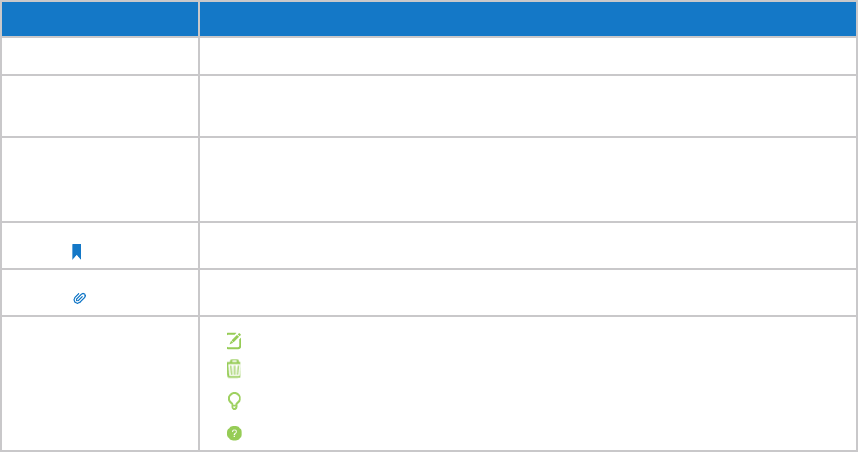
1
About This Guide
This guide is a complementation of Quick Installation Guide. The Quick Installation
Guide instructs you on quick Internet setup, and this guide provides details of each
function and shows you the way to configure these functions appropriate to your
needs.
When using this guide, please notice that features of the router may vary slightly
depending on the model and software version you have, and on your location, language,
and Internet service provider. All screenshots, images, parameters and descriptions
documented in this guide are used for demonstration only.
Conventions
In this guide the following conventions are used:
Convention Description
Blue Italic Hyperlinks are in blue italic. You can click to redirect to a website or a specific section.
Blue Contents to be emphasized and texts on the web page are in blue, including the
menus, items, buttons, etc.
>
The menu structures to show the path to load the corresponding page. For example,
Advanced > Wireless > MAC Filtering means the MAC Filtering function page is under
the Wireless menu that is located in the Advanced tab.
Note: Ignoring this type of note might result in a malfunction or damage to the device.
Tips: Indicates important information that helps you make better use of your device.
symbols on the web
page
• click to edit the corresponding entry.
• click to delete the corresponding entry.
• click to enable or disable the corresponding entry.
• click to view more information about items on the page.
More Info
• The latest software, management app and utility can be found at Download Center at
http://www.tp-link.com/support.
• The Quick Installation Guide (QIG) can be found where you find this guide or inside
the package of the router.
• Specifications can be found on the product page at http://www.tp-link.com.
• A Technical Support Forum is provided for you to discuss our products at
http://forum.tp-link.com.
• Our Technical Support contact information can be found at the Contact Technical
Support page at http://www.tp-link.com/support.

Chapter 1
Get to Know About Your
Router
This chapter introduces what the router can do and shows its appearance.
This chapter contains the following sections:
• Product Overview
• Panel Layout
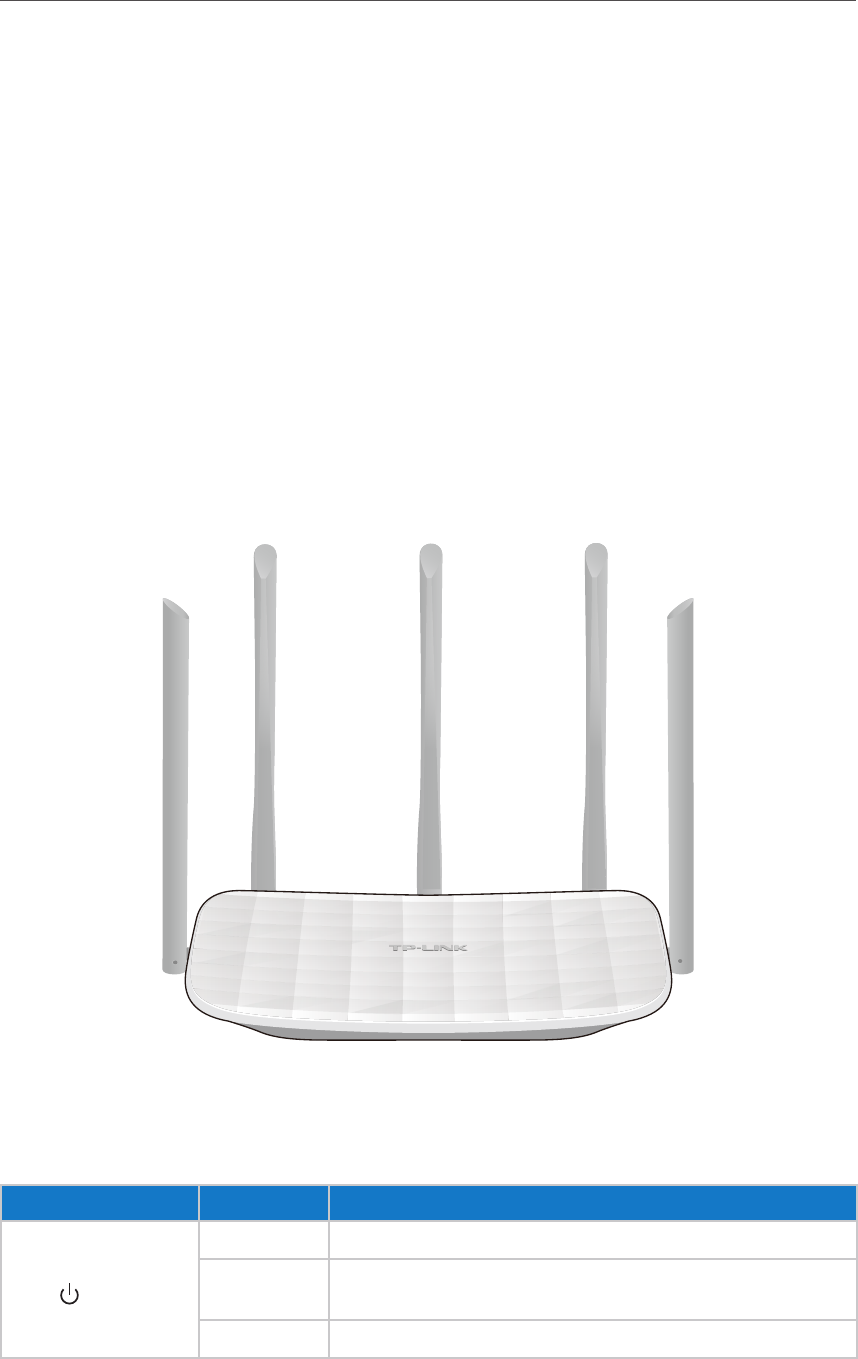
3
Chapter 1 Get to Know About Your Router
1. 1. Product Overview
The TP-LINK router is designed to fully meet the need of Small Office/Home Office
(SOHO) networks and the users demanding higher networking performance. The
powerful antennas ensure continuous Wi-Fi signal to all your devices while boosting
widespread coverage throughout your home, and the built-in Ethernet ports supply
high-speed connection to your wired devices.
Moreover, it is simple and convenient to set up and use the TP-LINK router due to its
intuitive web interface and the powerful Tether app.
1. 2. Panel Layout
1. 2. 1. Top View
The router’s LEDs (view from left to right) are located on the front panel. You can check
the router’s working status by following the LED Explanation table.
LED Explanation
Name Status Indication
(Power)
On System initialization completes.
Flashing System initialization or firmware upgrade is in process. Do not
disconnect or power off the router.
Off Power is off.

4
Chapter 1 Get to Know About Your Router
LED Explanation
Name Status Indication
(2.4GHz Wireless)
On The 2.4GHz wireless band is working properly.
Off The 2.4 GHz wireless band is disabled.
( 5GHz Wireless)
On The 5GHz wireless band is working properly.
Off The 5GHz wireless band is disabled.
(Ethernet)
On At least one Ethernet port is connected.
Off No Ethernet port is connected.
(Internet)
Blue On Internet is available.
Orange On The router’s Internet port is connected, but the Internet
is not available.
Off The router’s Internet port is not connected.
(WPS)
On/Off Turns on when a WPS connection is established, and goes off about
5 minutes later.
Flashing A wireless device is trying to connect to the network via WPS. This
process may take up to 2 minutes.
1. 2. 2. The Back Panel
The following parts (view from left to right) are located on the rear panel.
Item Description
Power Port For connecting the router to a power socket via the provided power
adapter.
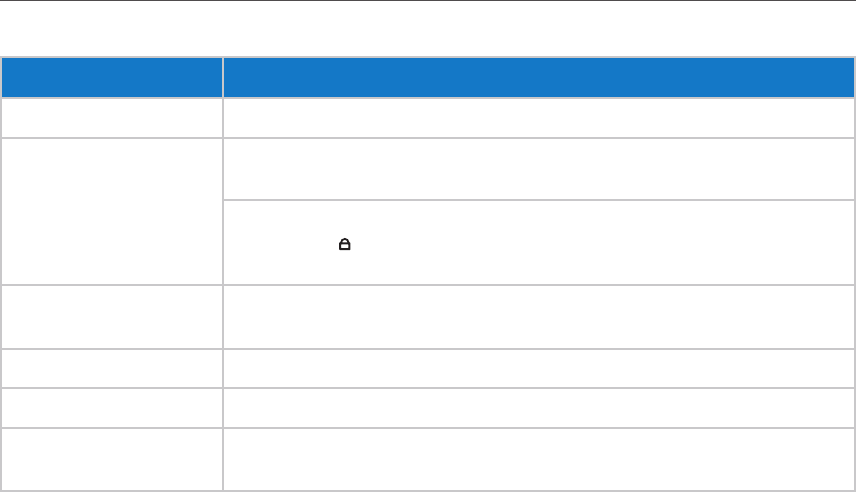
5
Chapter 1 Get to Know About Your Router
Item Description
Power On/Off Button Press this button to power on or off the router.
WPS/Wi-Fi On/Off Button
Press this button for about 2 seconds to turn on or off the wireless function of your
router.
Press this button, and immediately press the WPS button on your client device.
The WPS LED of the router should change from flashing to solid on, indicating
successful WPS connection.
Reset Button Press this button for about 7 seconds to reset the router to its factory
default settings.
Internet Port For connecting to a DSL/Cable modem, or Ethernet port.
Ethernet Ports (1/2/3/4) For connecting your PCs or other wired network devices to the router
Antennas Used for wireless operation and data transmitting. Upright them for the
best Wi-Fi performance.

Chapter 2
Connect the Hardware
This chapter contains the following sections:
• Position Your Router
• Connect Your Router
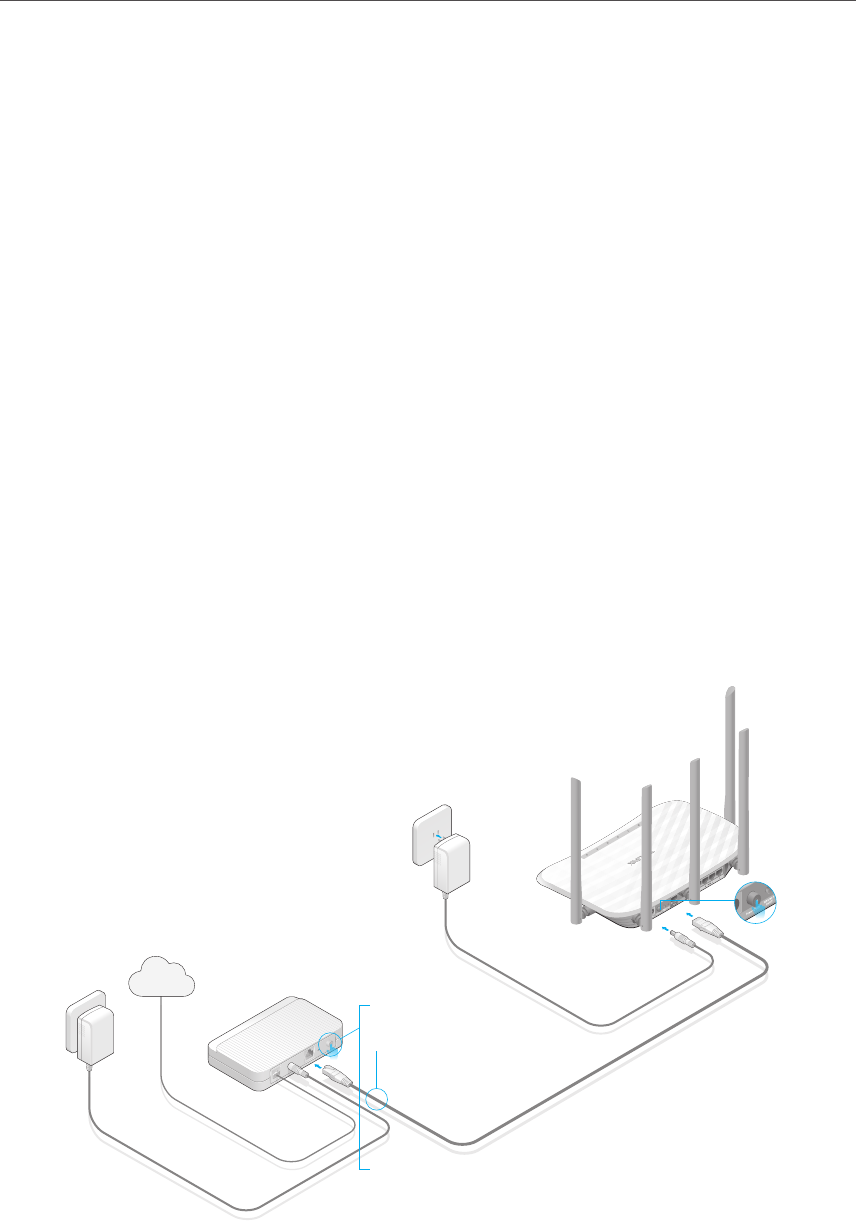
7
Chapter 2
2. 1. Position Your Router
• The Product should not be located where it will be exposed to moisture or excessive
heat.
• Place the router in a location where it can be connected to the various devices as well
as to a power source.
• Make sure the cables and power cord are safely placed out of the way so they do not
create a tripping hazard.
• The router can be placed on a shelf or desktop.
• Keep away from the strong electromagnetic radiation and the device of
electromagnetic sensitive.
2. 2. Connect Your Router
1. Follow the steps below to connect your router.
If your Internet connection is through an Ethernet cable from the wall instead of
through a DSL / Cable / Satellite modem, connect the Ethernet cable directly to the
router’s Internet port, then follow step 4 and 5 to complete the hardware connection.
1
2
Modem
Router
Internet
Power Adapter
Power Adapter
1 ) Turn off the modem, and remove the backup battery if it has one.
2 ) Connect the modem to the Internet port on your router with an Ethernet cable.
3 ) Turn on the modem, and then wait about 2 minutes for it to restart.
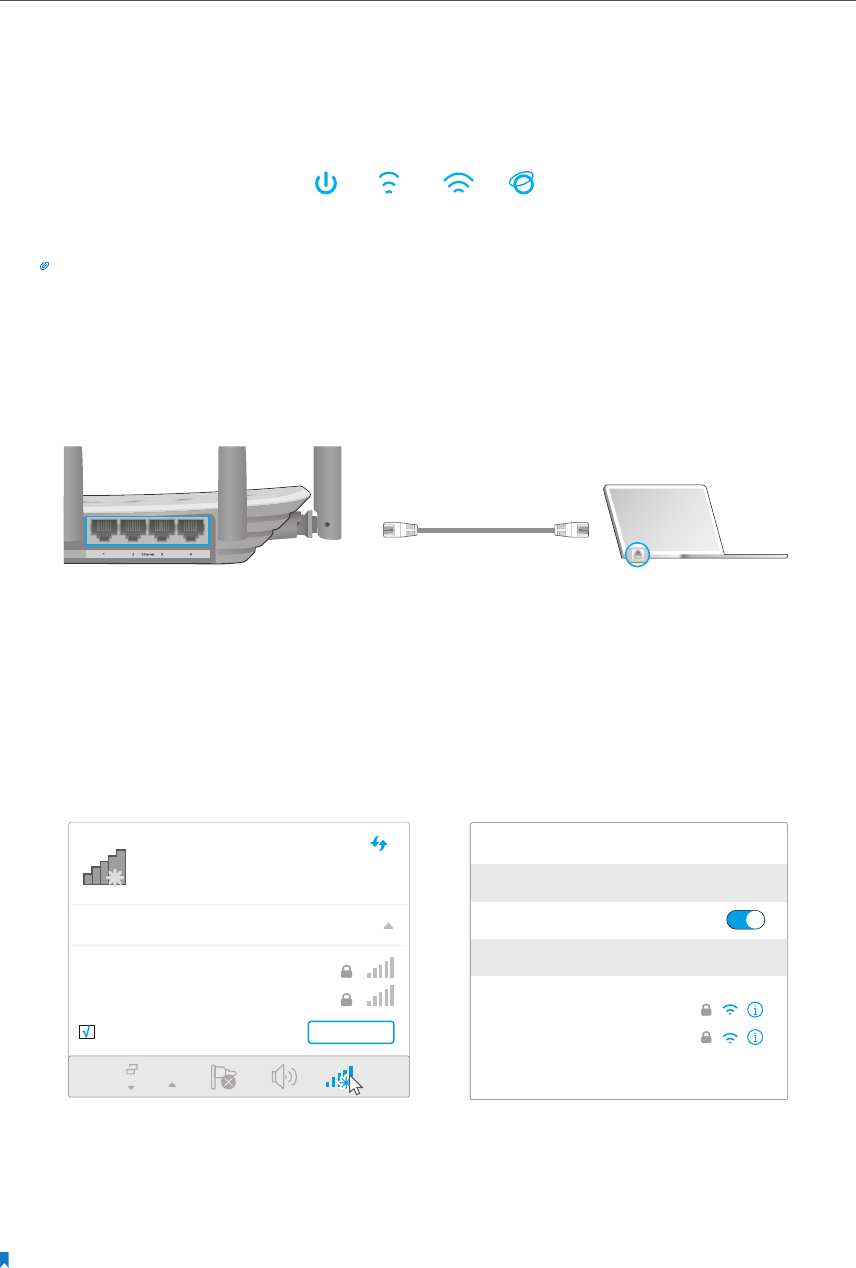
8
Chapter 2 Smart Device
4 ) Turn on the router.
5 ) Verify that the hardware connection is correct by checking these LEDs.
On
Internet
5GHz
On
Power
On
2.4GHz
On
Tips: If 2.4GHz LED and 5GHz LED are off, press the WPS/Wi-Fi On/Off button for about 2 seconds, and then
check the LEDs again in a few seconds.
2. Connect your computer to the router.
• Method 1: Wired
Turn off the Wi-Fi on your computer and connect the devices as shown below.
Ethernet Cable
• Method 2: Wirelessly
1 ) Find the SSID (Network Name) and Wireless Password/PIN printed on the label
at the bottom of the router.
2 ) Click the network icon of your computer or go to Wi-Fi Setting of your smart
device, and then select the SSID to join the network.
Connections are available
Wireless Network Connection
Connect automatically Connect
√
TP-LINK_XXXX
TP-LINK_XXXX_5G
Wi-Fi
Wi-Fi
TP-LINK_XXXX
TP-LINK_XXXX_5G
CHOOSE A NETWORK…
Other…
< Settings
Smart DeviceComputer
• Method 3: Use the WPS button
Wireless devices that support WPS, including Android phones, tablets, most USB
network cards, can be connected to your router through this method. (WPS is not
supported by iOS devices.)
Note:
The WPS function cannot be configured if the wireless function of the router is disabled. Also, the WPS function will
be disabled if your wireless encryption is WEP. Please make sure the wireless function is enabled and is configured
with the appropriate encryption before configuring the WPS.

9
Chapter 2 Close to
1. Tab the WPS icon on the device’s screen.
2. Immediately press the WPS button on your router.
Close to

Chapter 3
Log into Your Router

11
Chapter 3 Log into Your Router
With a Web-based utility, it is easy to configure and manage the rouer. The Web-based
utility can be used on any Windows, Macintosh or UNIX OS with a Web browser, such as
Microsoft Internet Explorer, Mozilla Firefox or Apple Safari.
Follow the steps below to log into your router.
1. Set up the TCP/IP Protocol in Obtain an IP address automatically mode on your
computer.
2. Visit http://tplinkwifi.net, and log in with the username and password you set for the
router. The default one is admin for both username and password.
Note:
If the login window does not appear, please refer to FAQ Section.

Chapter 4
Set Up Internet Connection
This chapter introduces how to connect your router to the Internet. The router is
equipped with a web-based Quick Setup wizard. It has necessary ISP information built
in, automates many of the steps and verifies that those steps have been successfully
completed. Furthermore, you can also set up an IPv6 connection if your ISP provides
IPv6 service.
This chapter contains the following sections:
• Use Quick Setup Wizard
• Manually Set up Your Internet Connection
• Set Up an IPv6 Internet Connection
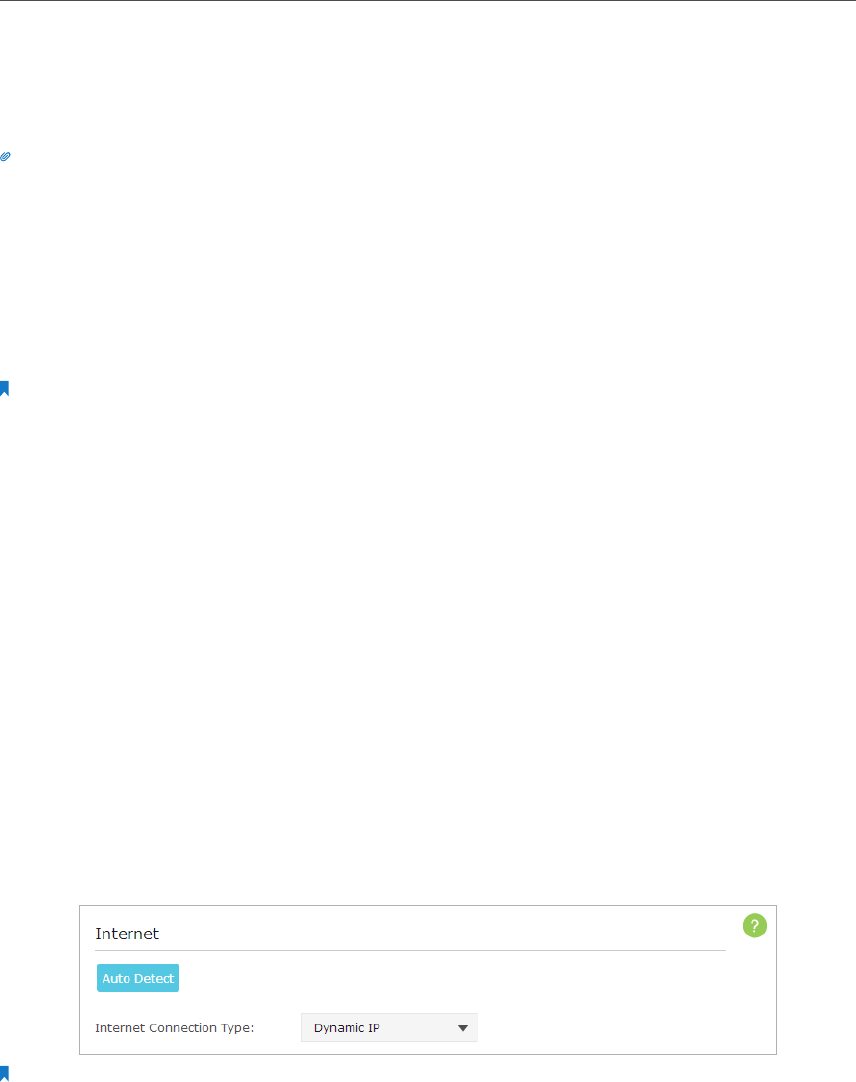
13
Chapter 4 Set Up Internet Connection
4. 1. Use Quick Setup Wizard
The Quick Setup Wizard will guide you through the process to set up your router.
Tips:
If you need the IPv6 Internet connection, please refer to the section of Set Up an IPv6 Internet Connection.
Follow the steps below to set up your router.
1. Visit http://tplinkwifi.net, and log in with the username and password you set for the
router.
2. Click Quick Setup on the top of the page. Then follow the step-by-step instructions
to connect your router to the Internet.
Note:
During the quick setup process:
• If you are not sure of the Internet Connection Type, please click Auto Detect or contact your ISP for Internet
connection information.
• If you have changed the preset wireless network name (SSID) and wireless password, all your wireless devices
must use the new SSID and password to connect to the router.
4. 2. Manually Set up Your Internet Connection
In this part, you can check your current Internet connection settings. You can also
modify the settings according to the service information provided by your ISP.
Follow the steps below to check or modify your Internet connection settings.
1. Visit http://tplinkwifi.net, and log in with the username and password you set for the
router.
2. Go to Basic > Internet.
3. Select your Internet connection type from the drop-down list.
Note:
If you are unsure of what your connection type is, click Auto Detect. Since different connection types need different
cables and connection information, you can also refer to the demonstrations in Step 4 to determine your connection
type.
4. Follow the instructions on the page to continue the configuration. Parameters on
the figures are just used for demonstration.
1 ) If you choose Dynamic IP, you need to select whether to clone the MAC address
or not. Dynamic IP users are usually equipped with a cable TV or fiber cable.

14
Chapter 4 Set Up Internet Connection
2 ) If you choose Static IP, enter the information provided by your ISP in the
corresponding fields.
3 ) If you choose PPPoE, enter the username and password provided by your ISP.
PPPoE users usually have DSL cable modem.
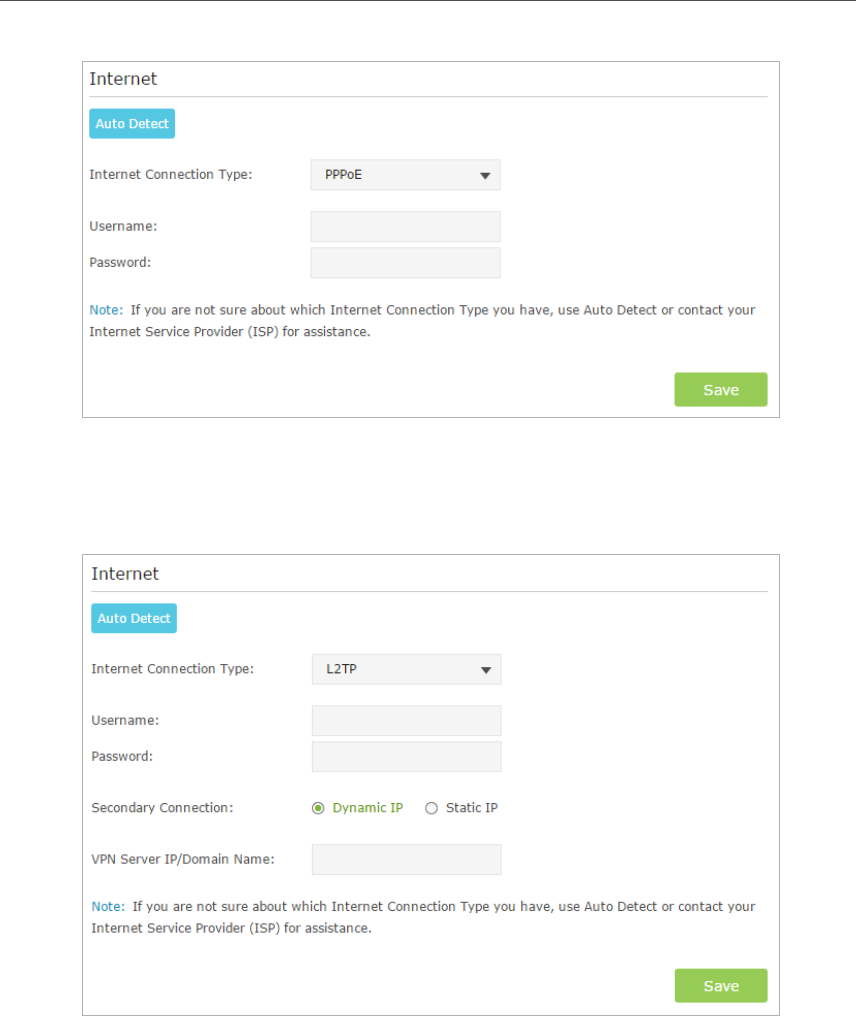
15
Chapter 4 Set Up Internet Connection
4 ) If you choose L2TP, enter the username and password and choose the Secondary
Connection provided by your ISP. Different parameters are needed according
to the Secondary Connection you have chosen.
5 ) If you choose PPTP, enter the username and password, and choose the
Secondary Connection provided by your ISP. Different parameters are needed
according to the Secondary Connection you have chosen.
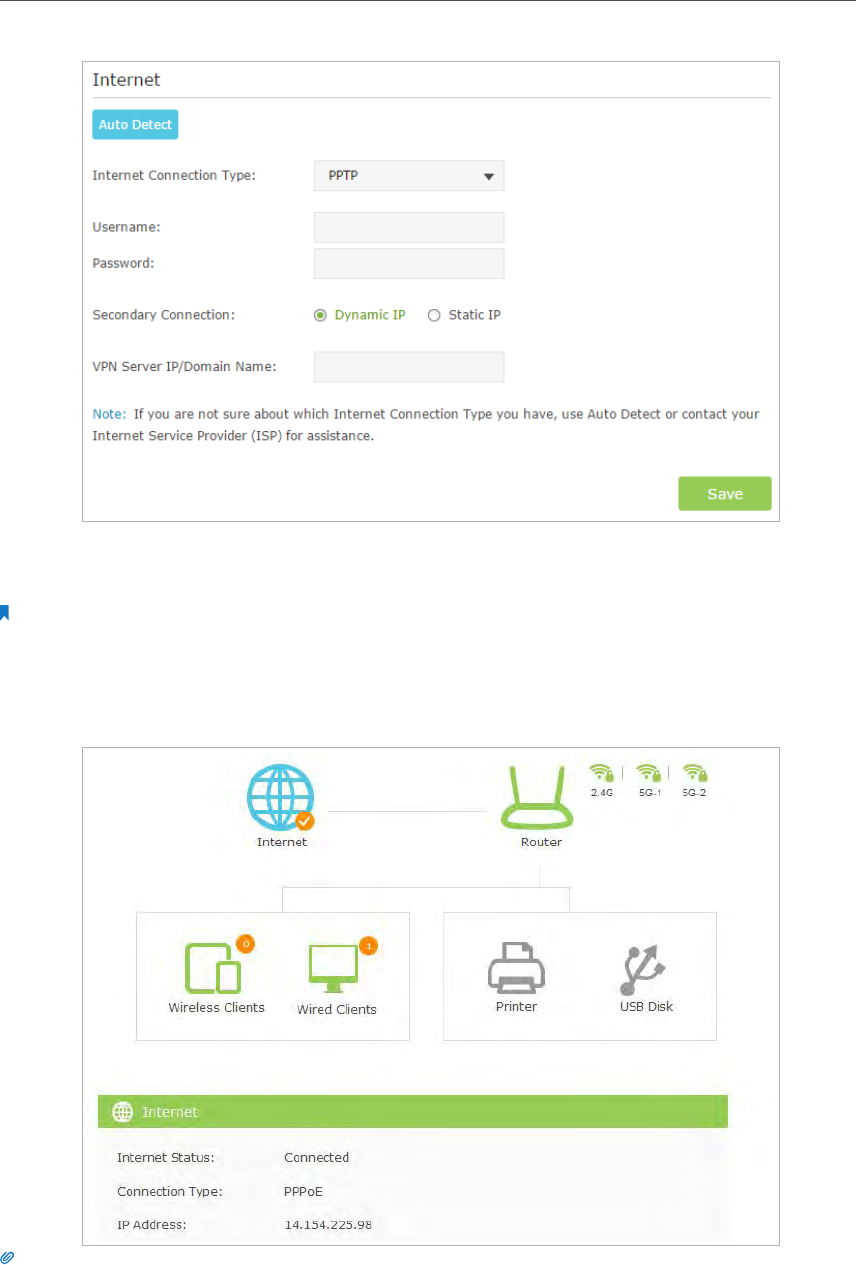
16
Chapter 4 Set Up Internet Connection
5. Click Save. To check your Internet connection, click Network Map on the left of the
page.
Note:
It may take 1-2 minutes to make the settings valid.
6. After the connection succeeds, the screen will display as follows. Here we take
PPPoE as an example.
Tips:
1. If your Internet connection type is BigPond Cable, please go to Advanced > Network > Internet to set your router.
2. If you use Dynamic IP and PPPoE and you are provided with any other parameters that are not required on the
page, please go to Advanced > Network > Internet to complete the configuration.
3. If you still cannot access the Internet, refer to the FAQ for further instructions.
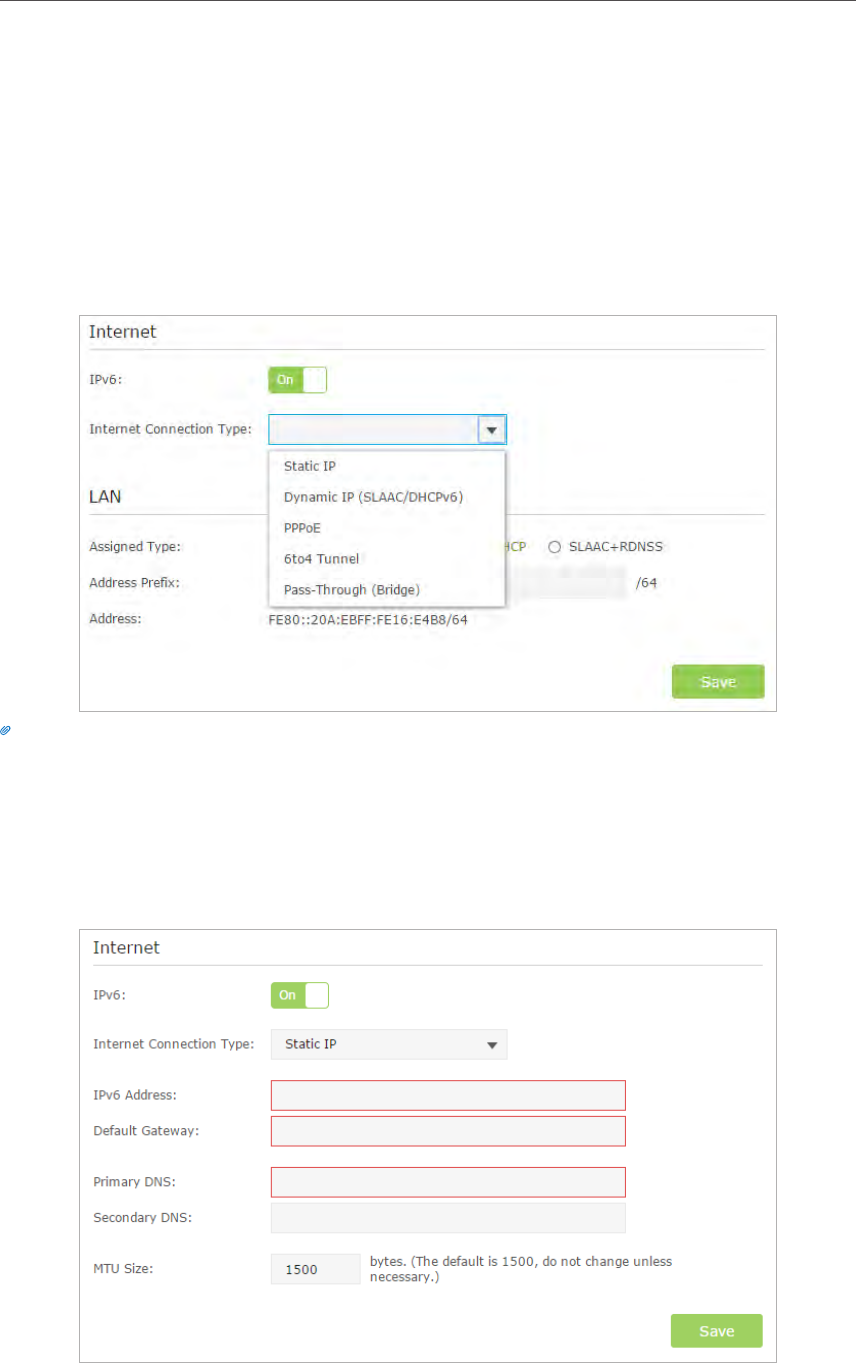
17
Chapter 4 Set Up Internet Connection
4. 3. Set Up an IPv6 Internet Connection
Your ISP provides information about one of the following IPv6 Internet connection
types: PPPoE, Dynamic IP(SLAAC/DHCPv6), Static IP, 6to4 tunnel, Pass-Through (Bridge).
1. Visit http://tplinkwifi.net, and log in with the username and password you set for the
router.
2. Go to Advanced > IPv6. Select the Internet connection type provided by your ISP.
Tips:
If you do not know what your Internet connection type is, contact your ISP or judge according to the already known
information provided by your ISP.
3. Fill in information as required by different connection types. Red blanks must be
filled in.
1 ) Static IP: Fill in blanks and click Save.
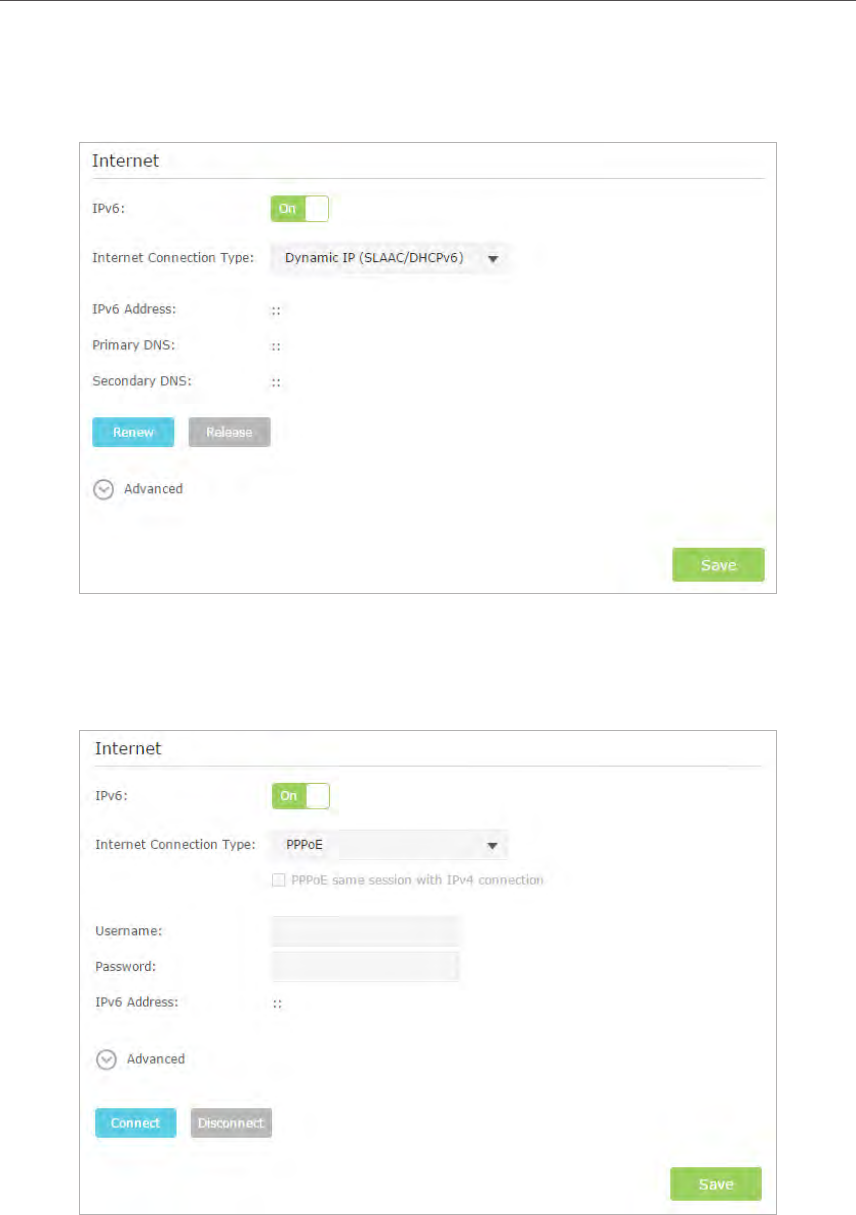
18
Chapter 4 Set Up Internet Connection
2 ) Dynamic IP(SLAAC/DHCPv6): Click Advanced to do more configuration if your
ISP requires. Click Save and then click Renew to finish the configuration.
3 ) PPPoE: Fill in the Username and Password. Click Advanced to do more
configuration if your ISP requires. Click Save and then click Connect to finish
the configuration.
4 ) 6to4 Tunnel: An IPv4 Internet connection type is a prerequisite for this
connection type (Manually Set up Your Internet Connection). Click Advanced to
do more configuration if your ISP requires. Click Save and then click Connect to
finish the configuration.
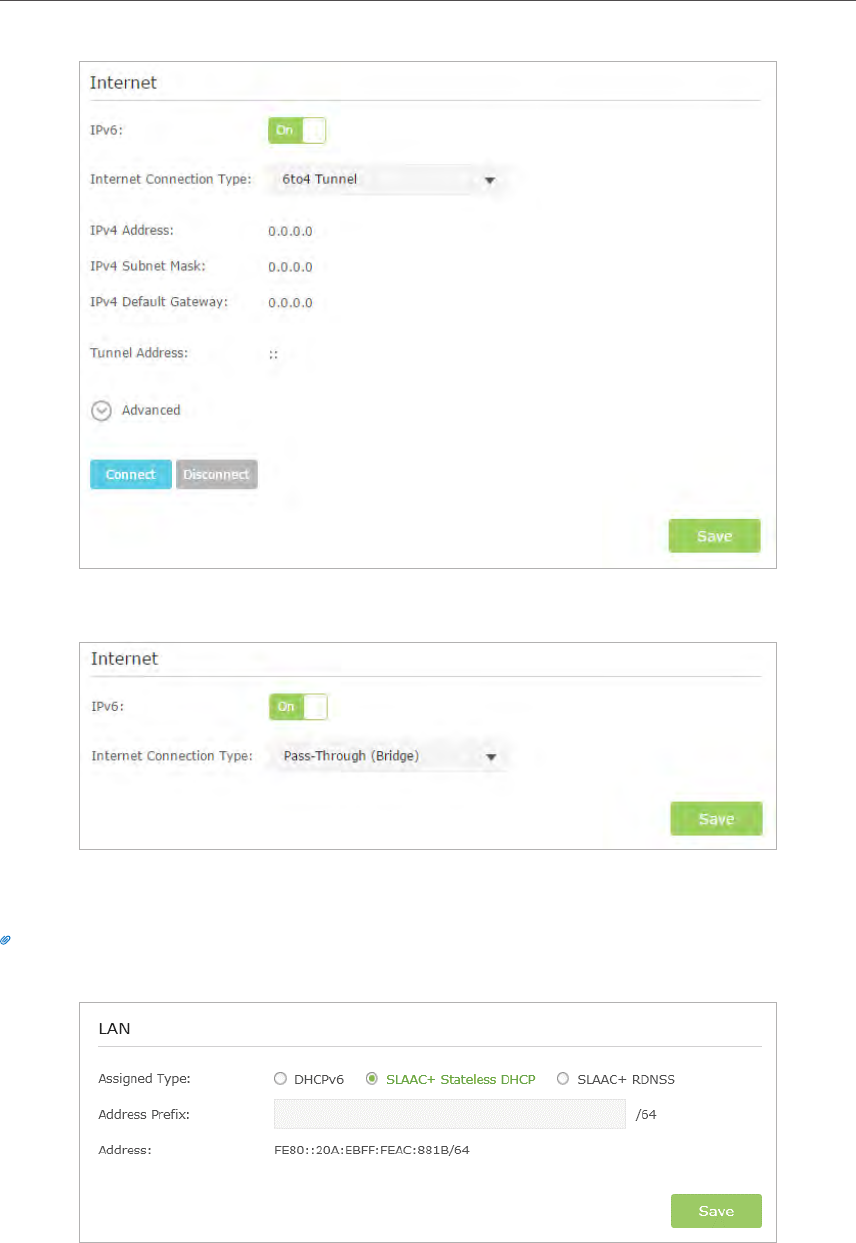
19
Chapter 4 Set Up Internet Connection
5 ) Pass-Through (Bridge): Click Save and skip to step 6.
4. Configure LAN ports. Windows users are recommended to choose from the first two
types. Fill in Address Prefix provided by your ISP, and click Save.
Tips:
Find Help on the management interface to know more about items.
5. Click Status to check whether you have successfully set up an IPv6 connection. The
following figure is an example of a successful PPPoE configuration.
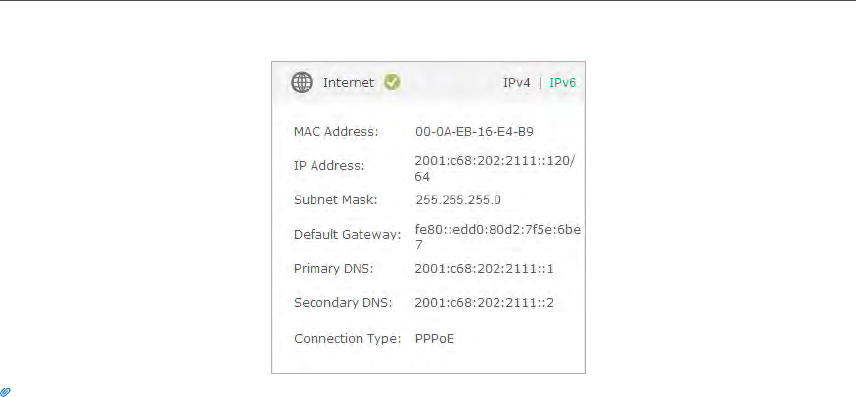
20
Chapter 4 Set Up Internet Connection
Tips:
Visit the FAQ if there is no Internet connection.

Chapter 5
Guest Network
This function allows you to provide Wi-Fi access for guests without disclosing your
main network. When you have guests in your house, apartment, or workplace, you can
create a guest network for them. In addition, you can customize guest network options
to ensure network security and privacy.
This chapter contains the following sections:
• Create a Network for Guests
• Customize Guest Network Options
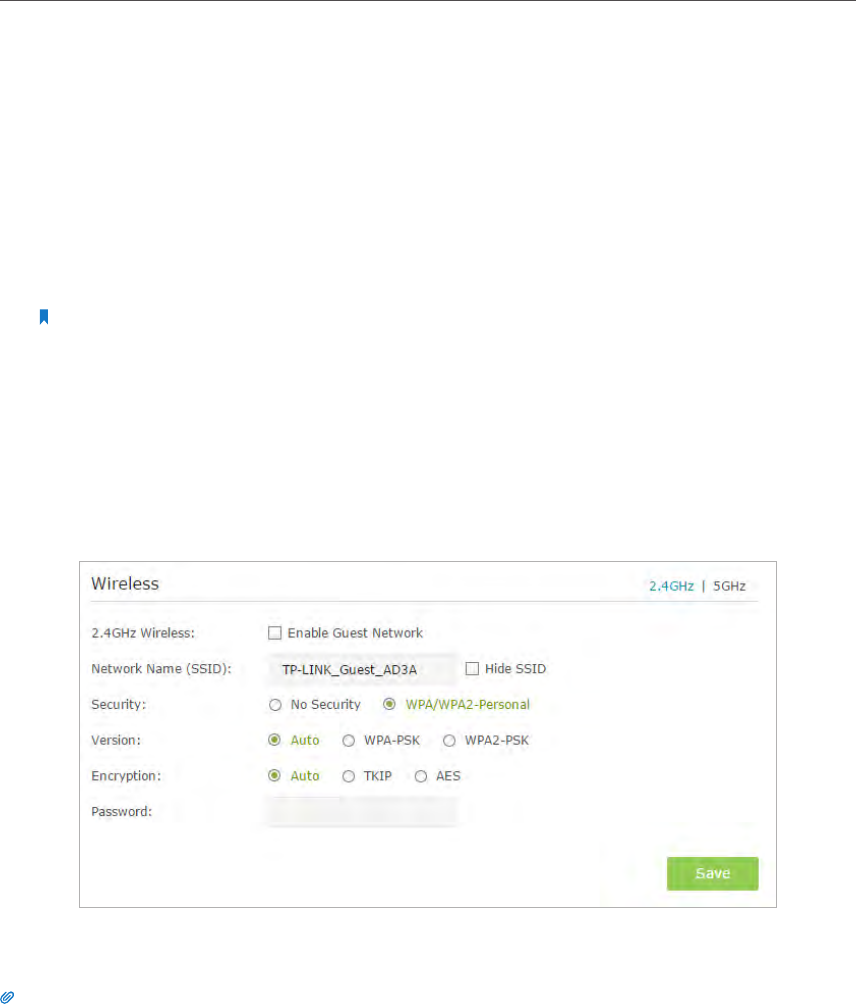
22
Chapter 5 Guest Network
5. 1. Create a Network for Guests
1. Visit http://tplinkwifi.net, and log in with the username and password you set for the
router.
2. Go to Advanced > Guest Network. Locate the Wireless section.
3. Create a guest network according to your needs.
1 ) Enable 2.4GHz Wireless network or 5GHz Wireless network.
Note:
Guest network and WDS cannot be enabled at the same time. If WDS was enabled, disable it at Advanced >
System Tools > System Parameters.
2 ) Customize the SSID. Don‘t select Hide SSID unless you want your guests to
manually input the SSID for guest network access.
3 ) Set Security to WPA/WPA2 Personal, keep the default Version and Encryption
values, and customize your own password.
4. Click Save. Now your guests can access your guest network using the SSID and
password you set!
Tips:
To view guest network information, go to Advanced > Status and locate the Guest Network section.
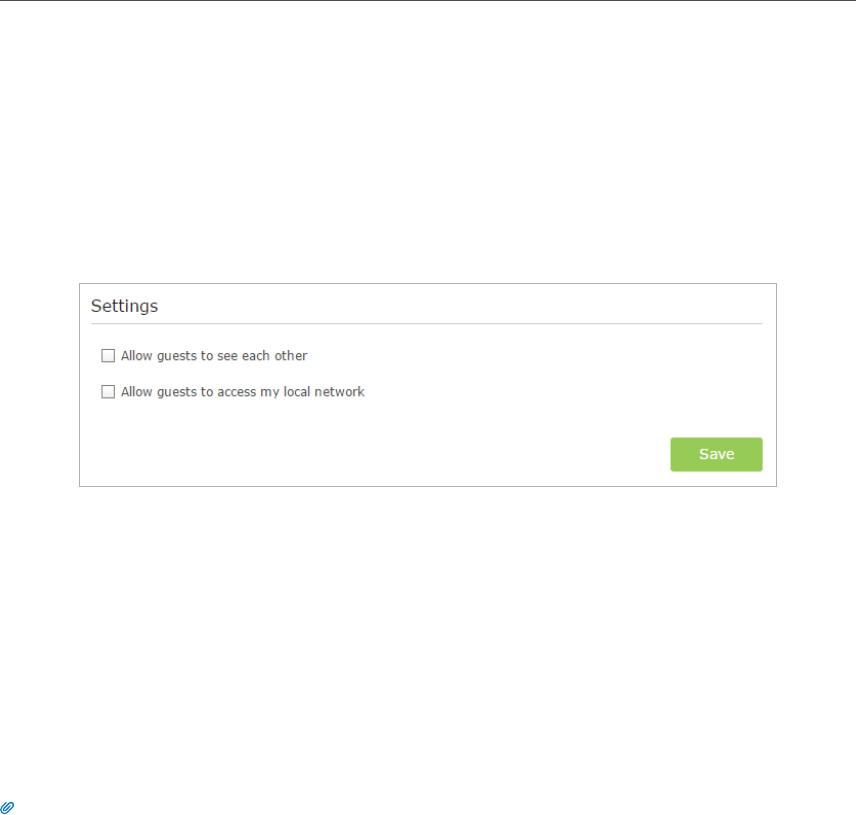
23
Chapter 5 Guest Network
5. 2. Customize Guest Network Options
1. Visit http://tplinkwifi.net, and log in with the username and password you set for the
router.
2. Go to Advanced > Guest Network. Locate the Settings section.
3. Customize guest network options according to your needs.
• Allow guests to see each other
Select this checkbox if you want to allow the wireless clients on your guest network
to communicate with each other via methods such as network neighbors, Samba,
Ping, and FTP.
• Allow guests to access my local network
Select this checkbox if you want to allow the wireless clients on your guest network
to communicate with the devices connected to your router’s LAN ports or main
network via methods such as network neighbors, Samba, Ping, and FTP.
4. Click Save. Now you can ensure network security and privacy!
Tips:
To view guest network information, go to Advanced > Status and locate the Guest Network section.

Chapter 6
Parental Controls
This function allows you to block inappropriate, explicit and malicious websites, and
controls access to specified websites at specified time.

25
Chapter 6 Parental Controls
Control the times of day my children or other home network
users are allowed to access the Internet and even types of
websites they can visit.
For example, I want to allow my children’s devices (e.g. a
computer or a tablet) to access only www.tp-link.com and
Wikipedia.org from 18:00 (6PM) to 22:00 (10PM) at the weekend
and not other times.
1. Visit http://tplinkwifi.net, and log in with the username and
password you set for the router.
2. Go to Advanced > Parental Controls and enable Parental
Controls.
3. Click Add. And then Click View Existing Devices, and select
the access device. Or, input the Device Name and MAC
Address manually.
4. Click the icon to set the Internet Access Time. Drag the
cursor over the appropriate cell(s) and click OK.
I want to:I want
How can I
do that?
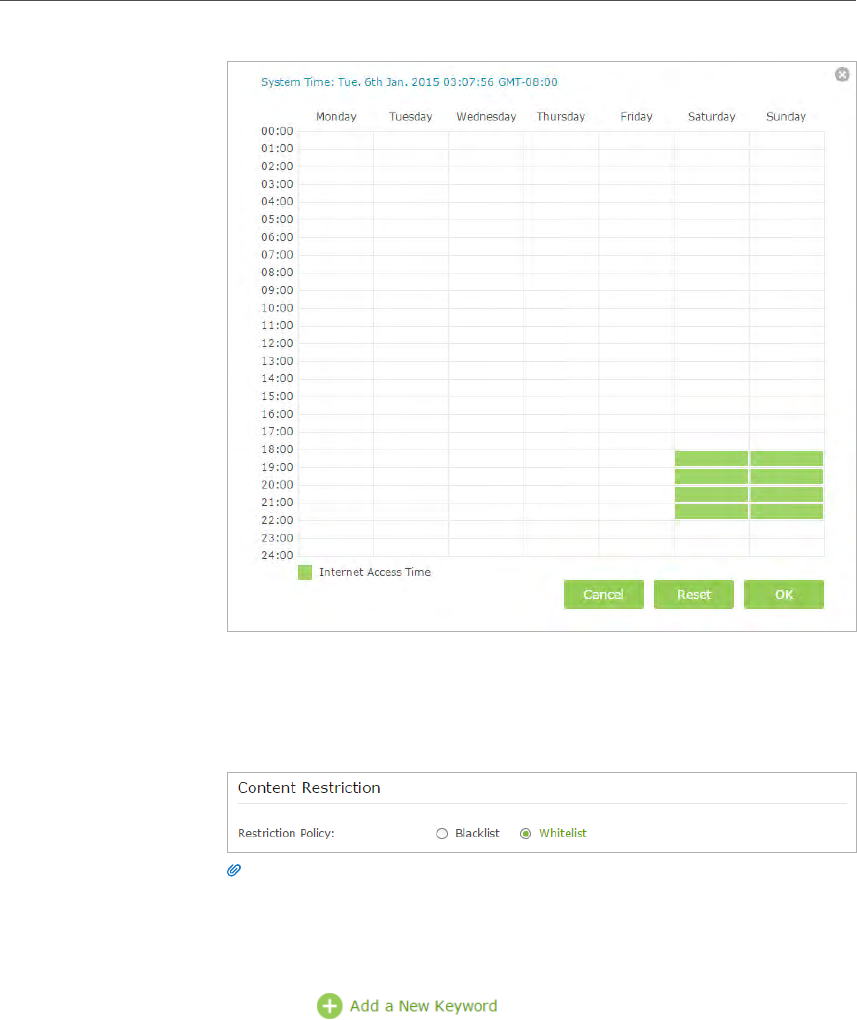
26
Chapter 6 Parental Controls
5. Enter a Description for the entry. Keep the Enable This Entry
checkbox selected. Click OK.
6. Select Whitelist as the restriction policy.
Tips:
1. With Blacklist selected, the controlled devices cannot access any websites
containing the specified keywords during the Internet Access Time period.
2. With Whitelist selected, the controlled devices can only access websites containing
the specified keywords during the Internet Access Time period.
7. Click . Enter a keyword or a website and
click Save.
You can add up to 32 keywords for either Blacklist or Whitelist.
Below are some sample entries to allow access.
• Enter a web address (e.g. wikipedia.org) or a web address
keyword (e.g. wikipedia) to only allow or block access to
the websites containing that keyword.
• Specify the domain suffix (eg. .edu or .org) to allow access
only to the websites with that suffix.
• If you wish to block all Internet browsing access, do not
add any keyword to the Whitelist.
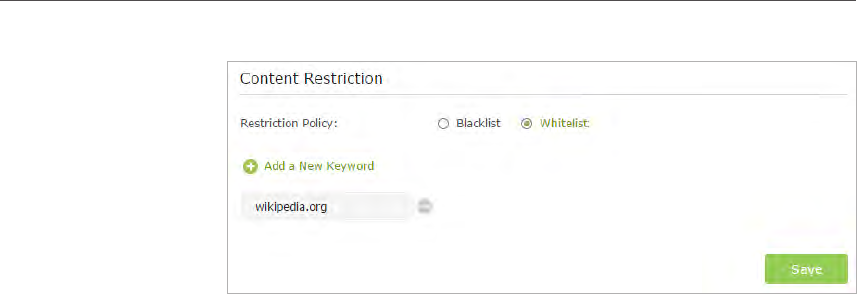
27
Chapter 6 Parental Controls
Now you can control your children’s Internet access according
to your needs.
Done!

Chapter 7
QoS
This chapter introduces how to create a QoS (Quality of Service) rule to specify
prioritization of traffic and minimize the impact caused when the connection is under
heavy load.
This chapter contains the following sections:
• Prioritize Internet Traffic with QoS
• Update the Database

29
Chapter 7 QoS
7. 1. Prioritize Internet Traffic with QoS
QoS (Quality of Service) is designed to ensure the efficient operation of the network
when come across network overload or congestion.
Specify priority levels for some devices or applications.
For example, I have several devices that are connected to my
wireless network. I would like to:
• Set my ftp server with faster surfing speed;
• Set my phone an intermediate speed on the Internet;
• Set the WIFI-GUEST with slower surfing speed.
1. Enable QoS and set bandwidth allocation.
1 ) Visit http://tplinkwifi.net, and log in with the username
and password you set for the router.
2 ) Go to Advanced > QoS > Settings.
3 ) Select Enable QoS.
4 ) Input the maximum upload and download bandwidth
provided by your service provider. 1Mbps is equal to
1000Kbps.
5 ) Click Advanced and drag the scroll bar to set the
bandwidth priority percentage.
6 ) Click Save.
2. Add a high priority QoS rule for the ftp server.
1 ) Click Add in the High Priority section.
I want to:
How can I
do that?
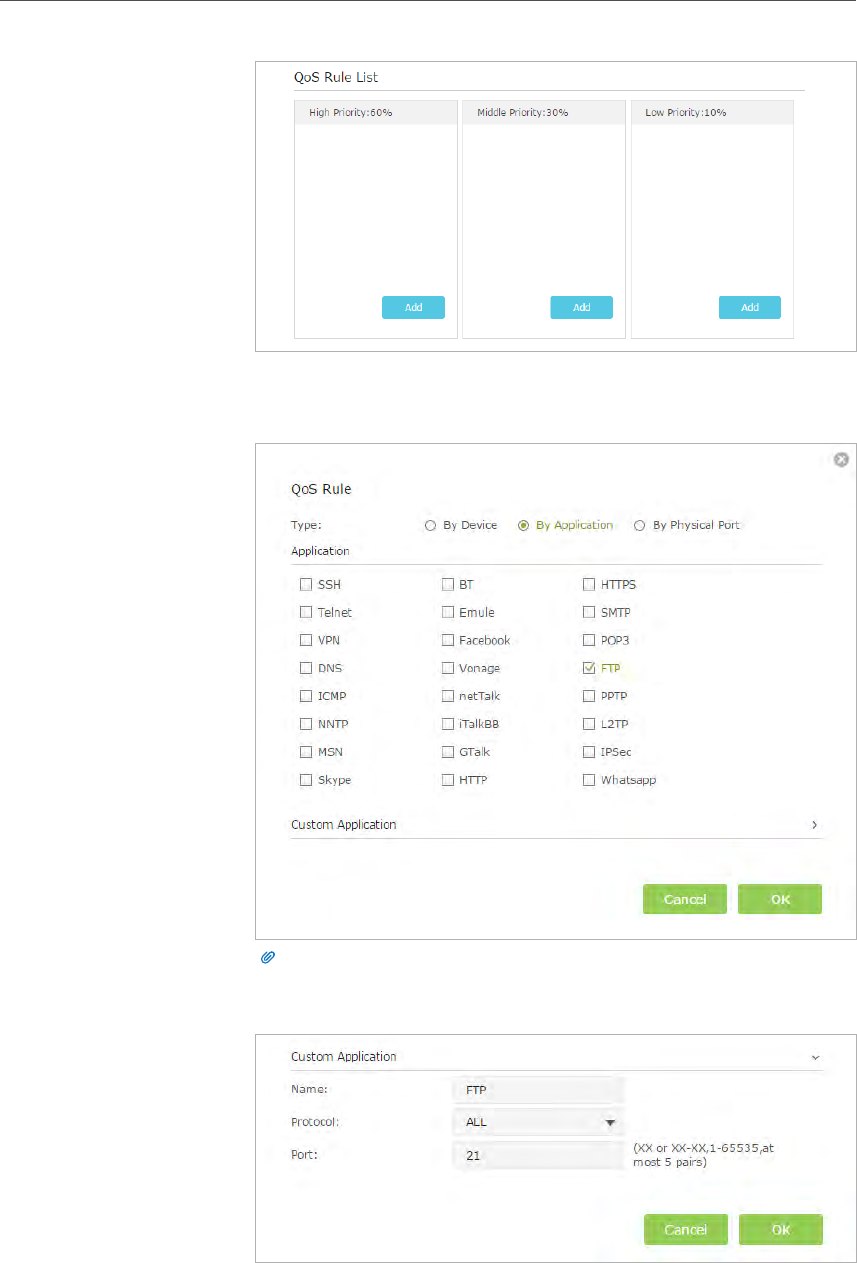
30
Chapter 7 QoS
2 ) Select By Application and select ftp in the list. Then click
OK.
Tips:
If your application isn’t listed on the screen, click Custom Application to add
application manually.
• Name: Enter a name for your applicaiton.
• Protocol: Select the protocol for your application, if your are not sure, select
ALL.
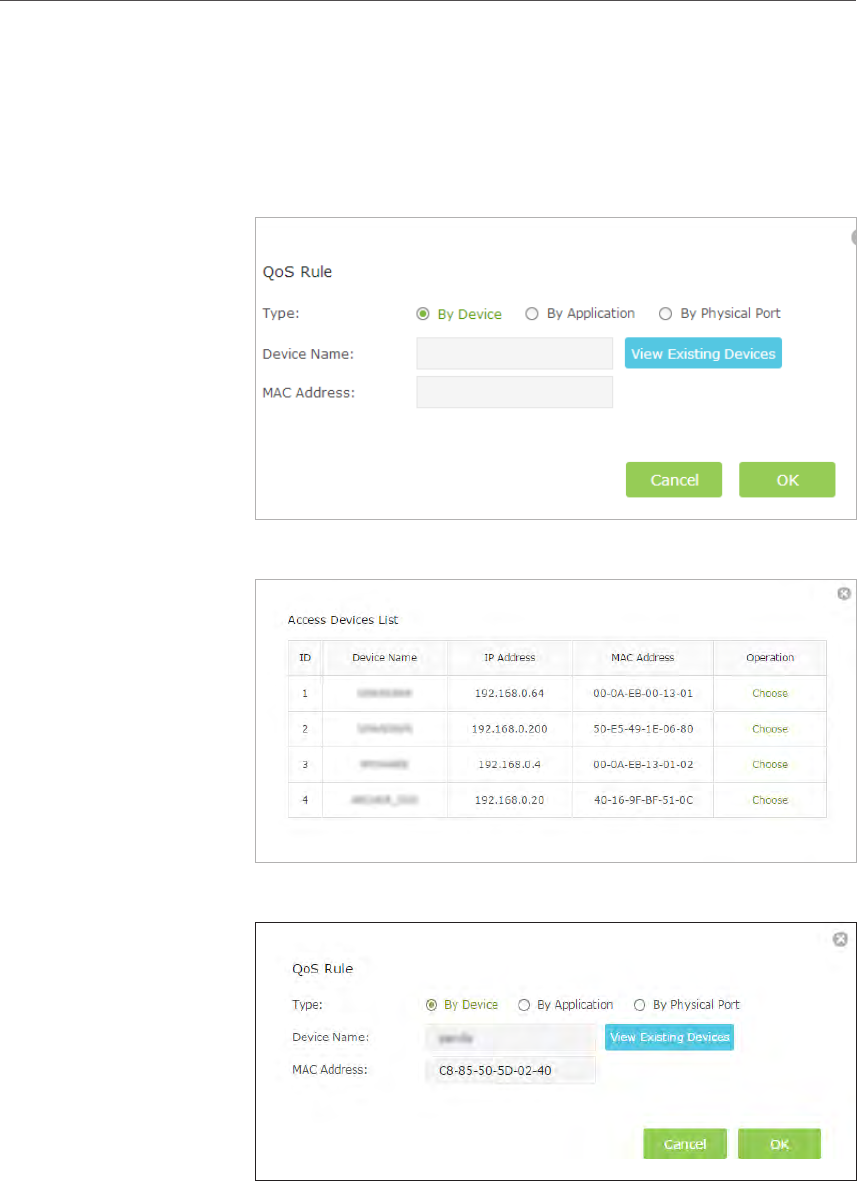
31
Chapter 7 QoS
• Port: Enter the destination port for your application, usually each application
has a fixed port, please ensure you enter the correct the port. In this case, the
destination port for ftp is 21.
3. Add a middle priority QoS rule for the phone.
1 ) Select By Device and then click View Existing Devices.
2 ) Choose the respective device from the list.
3 ) Click OK.
4. Add a low priority rule for the WIFI-GUEST: Select By Physical
Port and then select WIFI-HOST. Click OK.
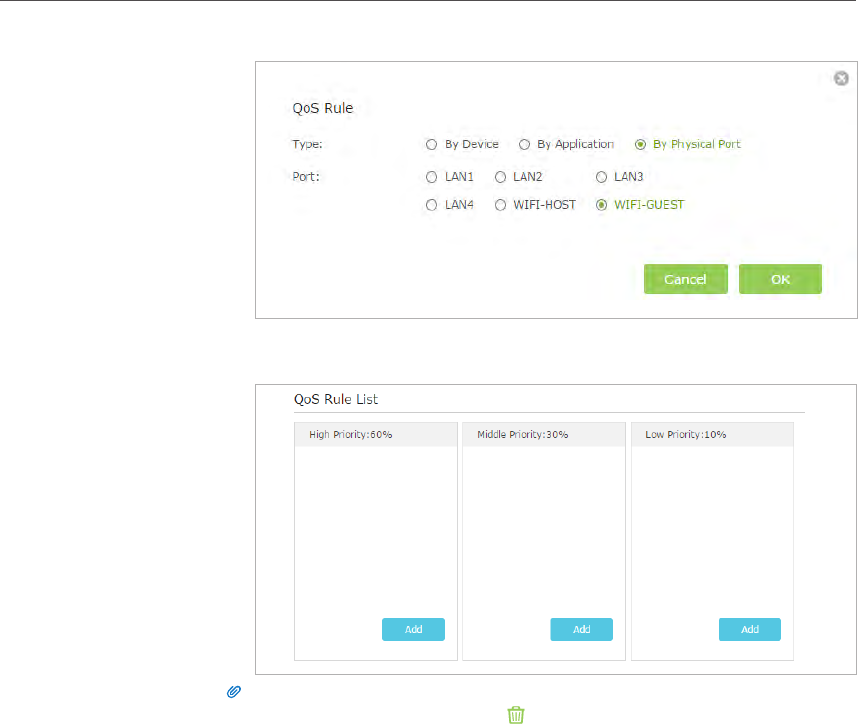
32
Chapter 7 QoS
5. The QoS rules list will display in the table.
Tips:
If you want to delete a QoS rule, click to remove the responding rule from the list.
Now QoS is implemented to Prioritize Internet Traffic.
7. 2. Update the Database
This function can help to add or update the applications of the router supports. If the
applications you need are not listed in the Application list, you can try to download the
new version and upgrade. New database versions are posted at www.tp-link.com and
can be downloaded for free.
1. Download the latest QoS database from our website (www.tp-link.com).
2. Visit http://tplinkwifi.net, and log in with the username and password you set for the
router.
3. Go to Advanced > QoS > Database. Click Browse to select the database upgrade file,
and then click Upgrade. Wait until the upgrade is completed and do not operate
during the process.
Done!

33
Chapter 7 QoS

Chapter 8
Network Security
This chapter guides you on how to protect your home network from cyber attacks
and unauthorized users by implementing these three network security functions. You
can protect your home network against DoS (Denial of Service) attacks from flooding
your network with server requests using DoS Protection, block or allow specific client
devices to access your network using Access Control, or you can prevent ARP spoofing
and ARP attacks using IP & MAC Binding.
This chapter contains the following sections:
• Protect the Network from Cyber Attacks
• Access Control
• IP & MAC Binding
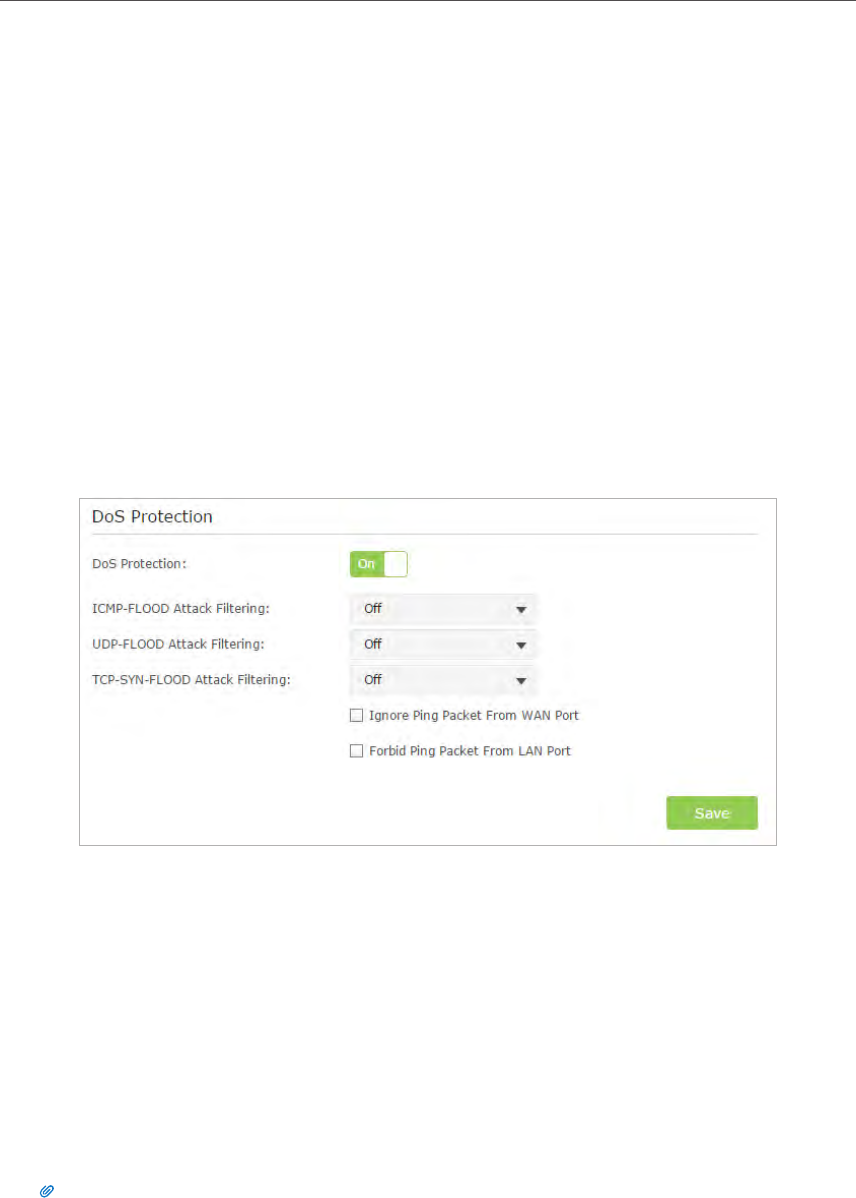
35
Chapter 8 Network Security
8. 1. Protect the Network from Cyber Attacks
The SPI (Stateful Packet Inspection) Firewall and DoS (Denial of Service) Protection
protect the router from cyber attacks.
The SPI Firewall can prevent cyber attacks and validate the traffic that is passing
through the router based on the protocol. This function is enabled by default, and it’s
recommended to keep the default settings.
DoS Protection can protect your home network against DoS attacks from flooding your
network with server requests. Follow the steps below to configure DoS Protection.
1. Visit http://tplinkwifi.net, and log in with the username and password you set for
the router.
2. Go to Advanced > Security > Settings.
3. Enable DoS Protection.
4. Set the level (Off, Low, Middle or High) of protection for ICMP-FLOOD Attack
Filtering, UDP-FlOOD Attack Filtering and TCP-SYN-FLOOD Attack Filtering.
• ICMP-FLOOD Attack Filtering — Enable to prevent the ICM (PInternet Control
Message Protocol) flood attack.
• UDP-FlOOD Attack Filtering — Enable to prevent the UDP (User Datagram
Protocol) flood attack.
• TCP-SYN-FLOOD Attack Filtering — Enable to prevent the TCP-SYN (Transmission
Control Protocol-Synchronize) flood attack.
Tips:
The level of protection is based on the number of traffic packets. The protection will be triggered immediately
when the number of packets exceeds the preset threshold value (the value can be set on Advanced > System
Tools > System Parameters > DoS Protection Level Settings), and the vicious host will be displayed in the
Blocked DoS Host List.
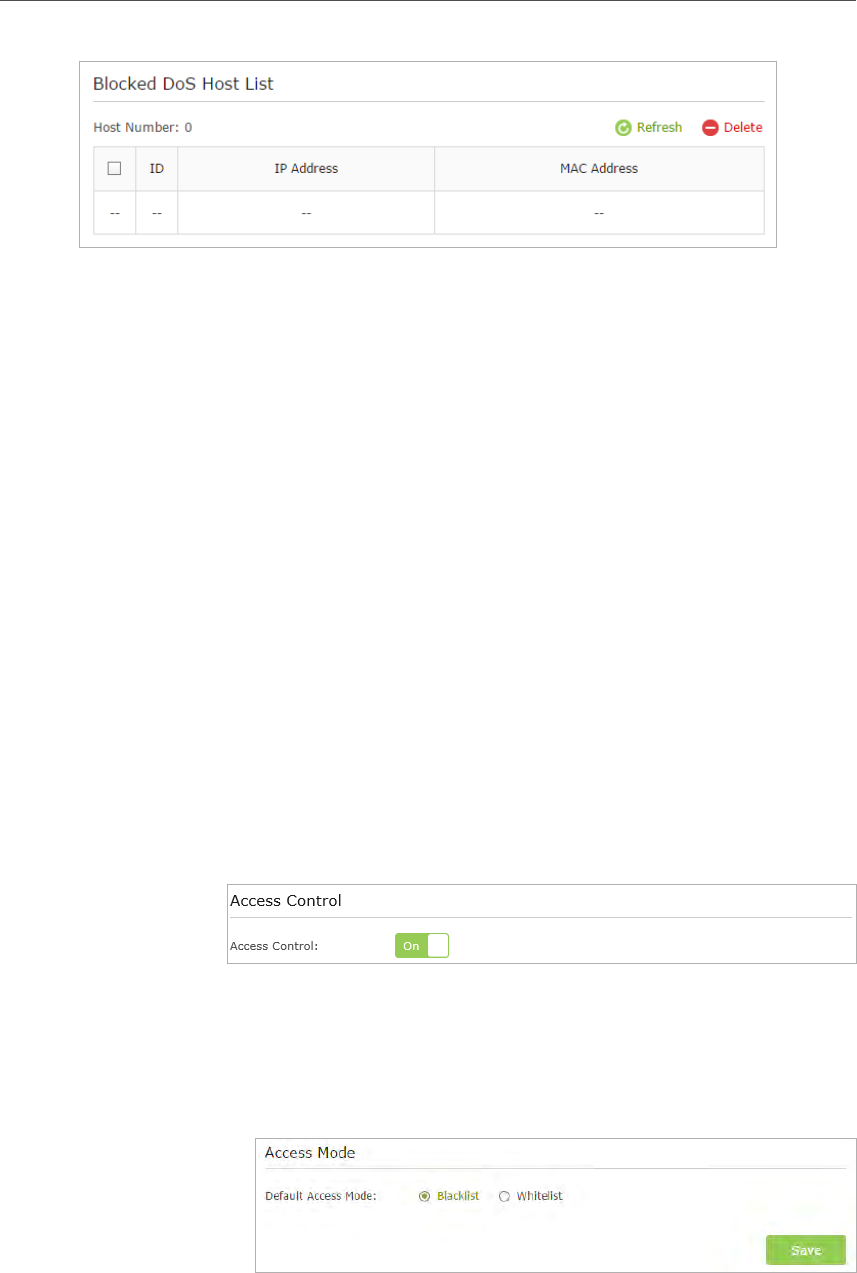
36
Chapter 8 Network Security
5. If you want to ignore the ping packets from the WAN port, select Ignore Ping Packet
From WAN Port; if you want to ignore the ping packets form the LAN port, select
Ignore Ping Packet From LAN Port.
6. Click Save.
8. 2. Access Control
Access Control is used to block or allow specific client devices to access your network
(via wired or wireless) based on a list of blocked devices (Blacklist) or a list of allowed
devices (Whitelist).
Block or allow specific client devices to access my network (via
wired or wireless).
1. Visit http://tplinkwifi.net, and log in with the username and
password you set for the router.
2. Go to Advanced > Security > Access Control.
3. Enable Access Control.
4. Select the access mode to either block (recommended) or
allow the device(s) in the list.
To block specific device(s)
1 ) Select Blacklist and click Save.
2 ) Select the device(s) to be blocked in the Devices Online
table by ticking the box.
I want to:
How can I
do that?
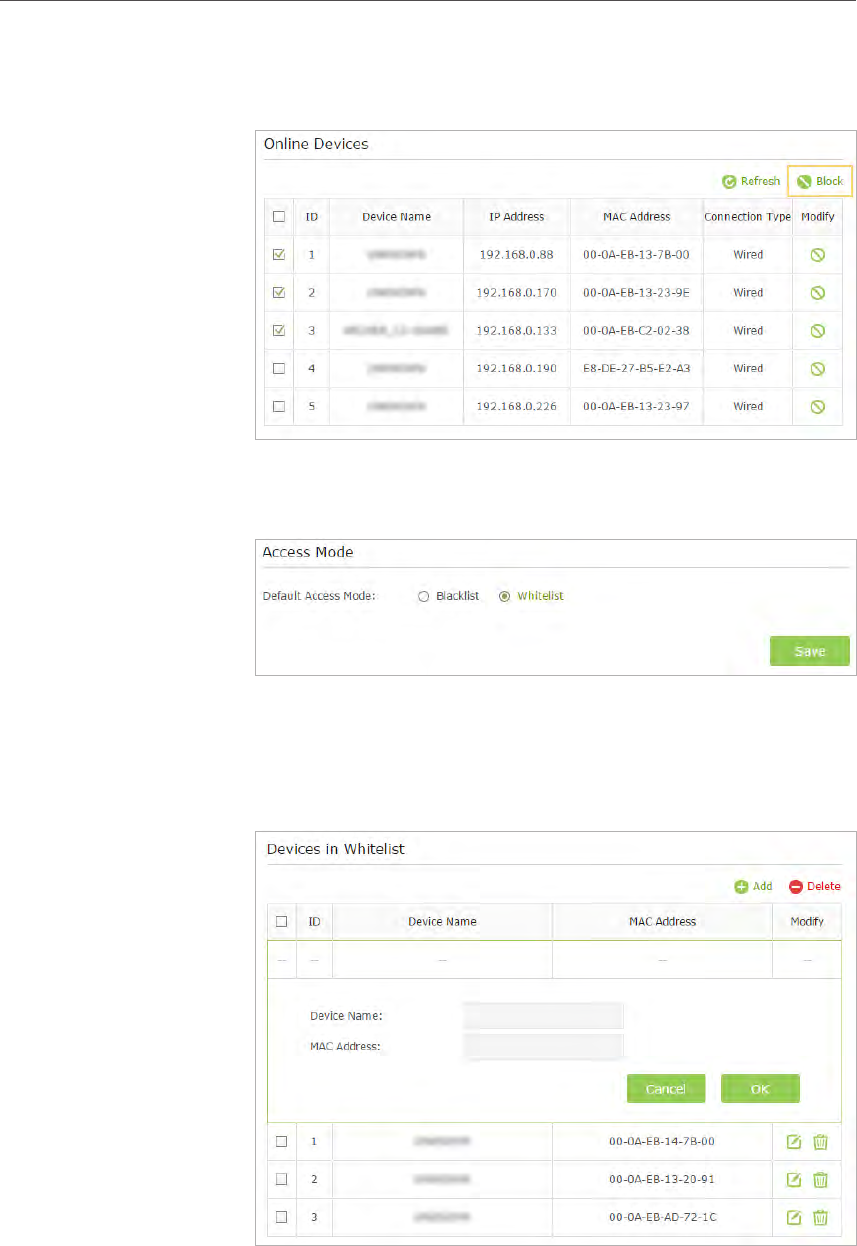
37
Chapter 8 Network Security
3 ) Click Block above the Online Devices table. The selected
devices will be added to Devices in Blacklist automatically.
To allow specific device(s)
1 ) Select Whitelist and click Save.
2 ) Click Add in the Devices in Whitelist section. Enter the
Device Name and MAC Address (You can copy and paste
the information from the Online Devices list if the device
is connected to your network).
3 ) Click OK.
Now you can block or allow specific client devices to access your
network (via wired or wireless) using the Blacklist or Whitelist.
Done!
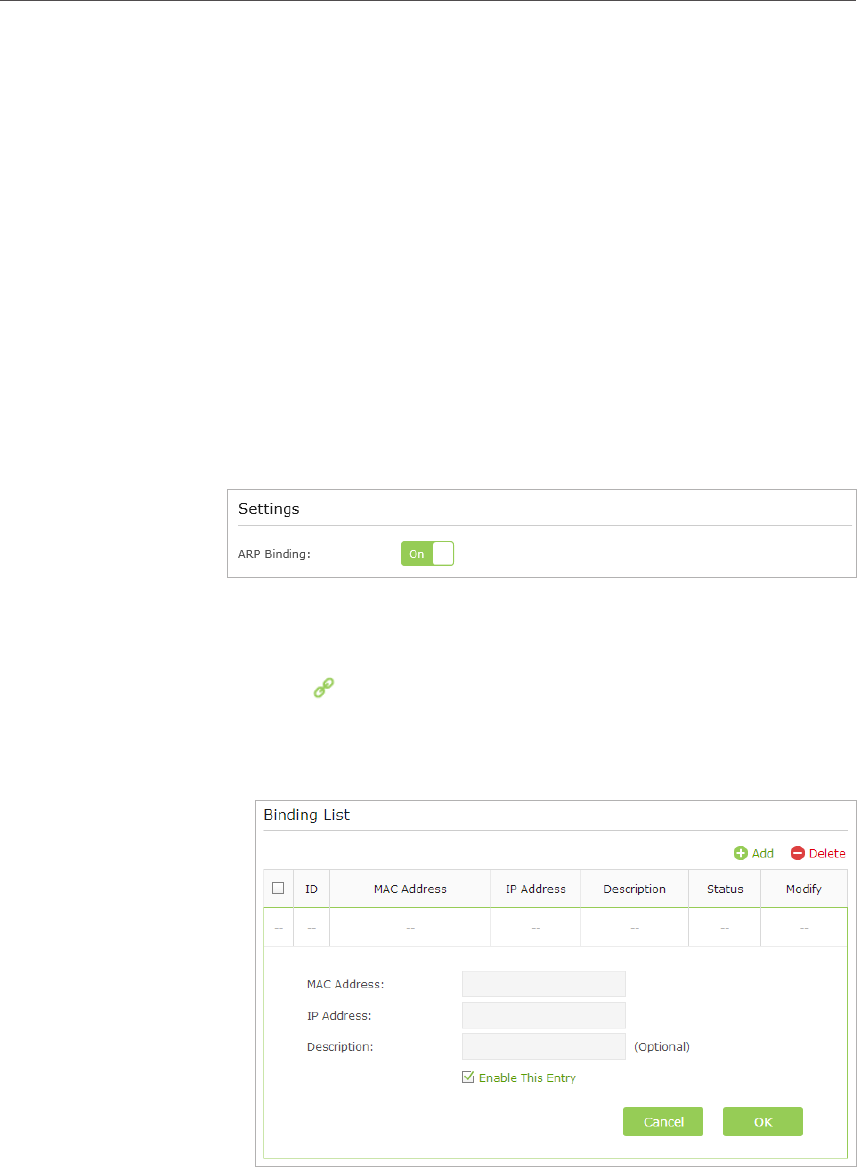
38
Chapter 8 Network Security
8. 3. IP & MAC Binding
IP & MAC Binding, namely, ARP (Address Resolution Protocol) Binding, is used to bind
network device’s IP address to its MAC address. This will prevent ARP Spoofing and
other ARP attacks by denying network access to an device with matching IP address in
the Binding list, but unrecognized MAC address.
Prevent ARP spoofing and ARP attacks.
1. Visit http://tplinkwifi.net, and log in with the username and
password you set for the router.
2. Go to Advanced > Security > IP & MAC Binding.
3. Enable ARP Binding.
4. Bind your device(s) according to your need.
To bind the connected device(s):
Click to add the corresponding device to the Binding List.
To bind the unconnected device
1 ) Click Add in Binding List section.
2 ) Enter the MAC address and IP address that you want to
bind. Enter a Description for this binding entry.
3 ) Tick the Enable This Entry check box and click OK.
Now you don’t need to worry about ARP spoofing and ARP
attacks!
I want to:
How can I
do that?
Done!

Chapter 9
NAT Forwarding
Router’s NAT (Network Address Translation) feature makes the devices in the LAN
use the same public IP address to communicate on the Internet, which protects the
local network by hiding IP addresses of the devices. However, it also brings about the
problem that external host cannot initiatively communicate with the specified device
in the local network.
With forwarding feature the router can penetrate the isolation of NAT and allows the
external hosts on the Internet to initiatively communicate with the devices in the local
network, thus to realize some special functions.
TP-LINK router includes four forwarding rules. If two or more rules are set, the priority
of implementation from high to low is Virtual Servers, Port Triggering, UPNP and DMZ.
This chapter contains the following sections:
• Share Local Resources on the Internet by Virtual Servers
• Open Ports Dynamically by Port Triggering
• Make Applications Free from Port Restriction by DMZ
• Make Xbox Online Games Run Smoothly by UPnP

40
Chapter 9 NAT Forwarding
9. 1. Share Local Resources on the Internet by Virtual
Servers
When you build up a server in the local network and want to share it on the Internet,
Virtual Servers can realize the service and provide it to the Internet users. At the same
time Virtual Servers can keep the local network safe as other services are still invisible
from the Internet.
Virtual Servers can be used for setting up public services in your local network, such
as HTTP, FTP, DNS, POP3/SMTP and Telnet. Different service uses different service port.
Port 80 is used in HTTP service, port 21 in FTP service, port 25 in SMTP service and port
110 in POP3 service. Please verify the service port number before the configuration.
Share my personal website I’ve built in local network with my
friends through the Internet.
For example, the personal website has been built on my home
PC (192.168.0.100). I hope that my friends on the Internet can
visit my website in some way. The PC is connected to the router
with the WAN IP address 218.18.232.154.
Personal Website
Home
Router
WAN: 218.18.232.154LAN
1. Assign a static IP address to your PC, for example
192.168.0.100.
2. Visit http://tplinkwifi.net, and log in with the username and
password you set for the router.
3. Go to Advanced > NAT Forwarding > Virtual Servers.
4. Click Add. Click View Existing Services and select HTTP. The
External Port, Internal Port and Protocol will be automatically
filled with contents. Enter the PC’s IP address 192.168.0.100
into the Internal IP field.
5. Click OK.
I want to:
How can I
do that?
INTERNET
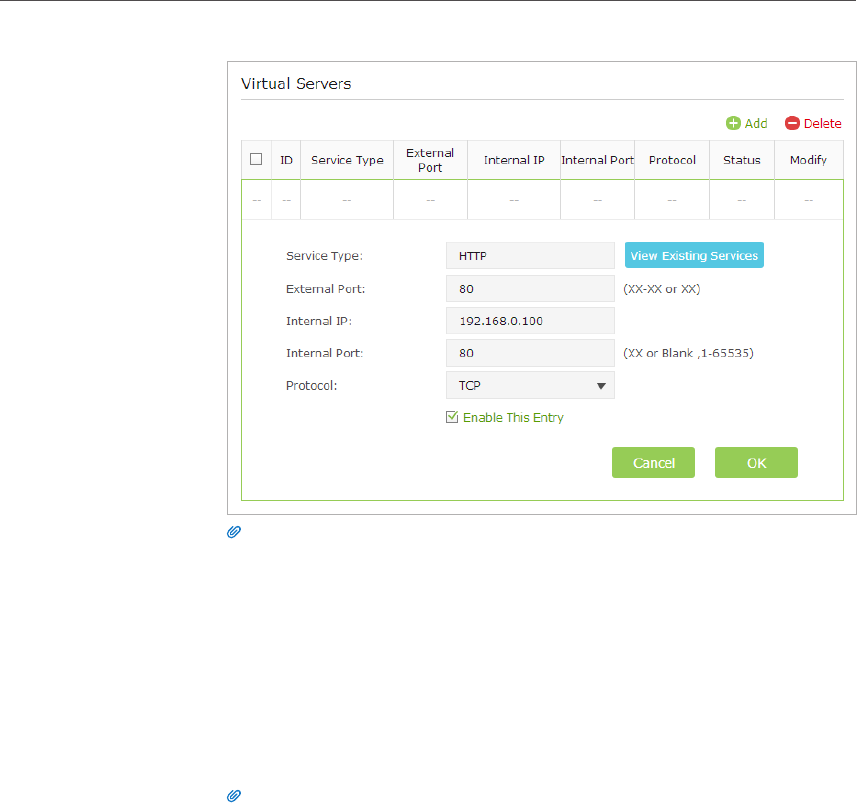
41
Chapter 9 NAT Forwarding
Tips:
1. It is recommended to keep the default settings of Internal Port and Protocol if you
are not clear about which port and protocol to use.
2. If the service you want to use is not in the Service Type, you can enter the
corresponding parameters manually. You should verify the port number that the
service needs.
3. You can add multiple virtual server rules if you want to provide several services in
a router. Please note that the External Port should not be overlapped.
Users on the Internet can enter http:// WAN IP (in this example:
http:// 218.18.232.154) to visit your personal website.
Tips:
1. WAN IP should be a public IP address. For the WAN IP is assigned dynamically by
ISP, it is recommended to apply and register a domain name for the WAN referring
to Set Up a Dynamic DNS Service Account. Then users on the Internet can use
http:// domain name to visit the website.
2. If you have changed the default External Port, you should use
http:// WAN IP: External Port or http:// domain name: External Port to visit the
website.
9. 2. Open Ports Dynamically by Port Triggering
Port Triggering can specify a triggering port and its corresponding external ports.
When a host in the local network initiates a connection to the triggering port, all the
external ports will be opened for subsequent connections. The router can record the IP
address of the host, when the data from the Internet return to the external ports, the
router can forward them to the corresponding host. Port Triggering is mainly applied
to online games, VoIPs and video players, common applications include MSN Gaming
Zone, Dialpad and Quick Time 4 players, etc.
Follow the steps below to configure the Port Triggering rules:
Done!
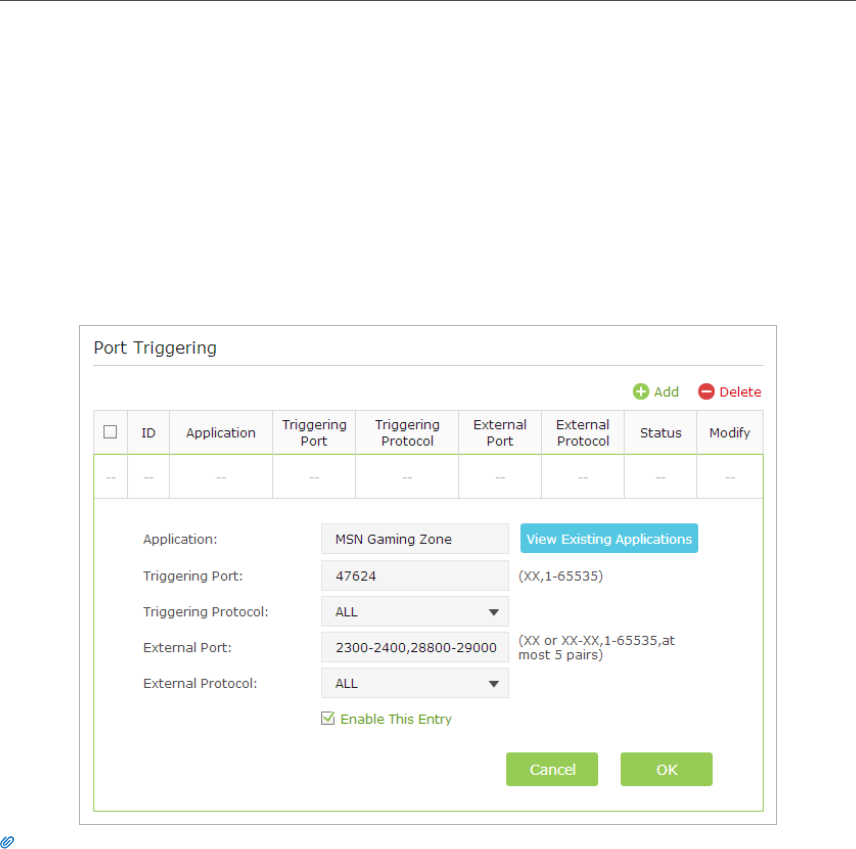
42
Chapter 9 NAT Forwarding
1. Visit http://tplinkwifi.net, and log in with the username and password you set for the
router.
2. Go to Advanced > NAT Forwarding > Port Triggering and click Add.
3. Click View Existing Applications, and select the desired application. The External Port,
Internal Port and Protocol will be automatically filled with contents. The following
picture takes application MSN Gaming Zone as an example.
4. Click OK.
Tips:
1. You can add multiple port triggering rules according to your network need.
2. The triggering ports can not be overlapped.
3. If the application you need is not listed in the Existing Applications list, please enter the parameters manually.
You should verify the external ports the application uses first and enter them into External Port field according
to the format the page displays.
9. 3. Make Applications Free from Port Restriction by
DMZ
When a PC is set to be a DMZ (Demilitarized Zone) host in the local network, it is totally
exposed to the Internet, which can realize the unlimited bidirectional communication
between internal hosts and external hosts. The DMZ host becomes a virtual server with
all ports opened. When you are not clear about which ports to open in some special
applications, such as IP camera and database software, you can set the PC to be a DMZ
host.
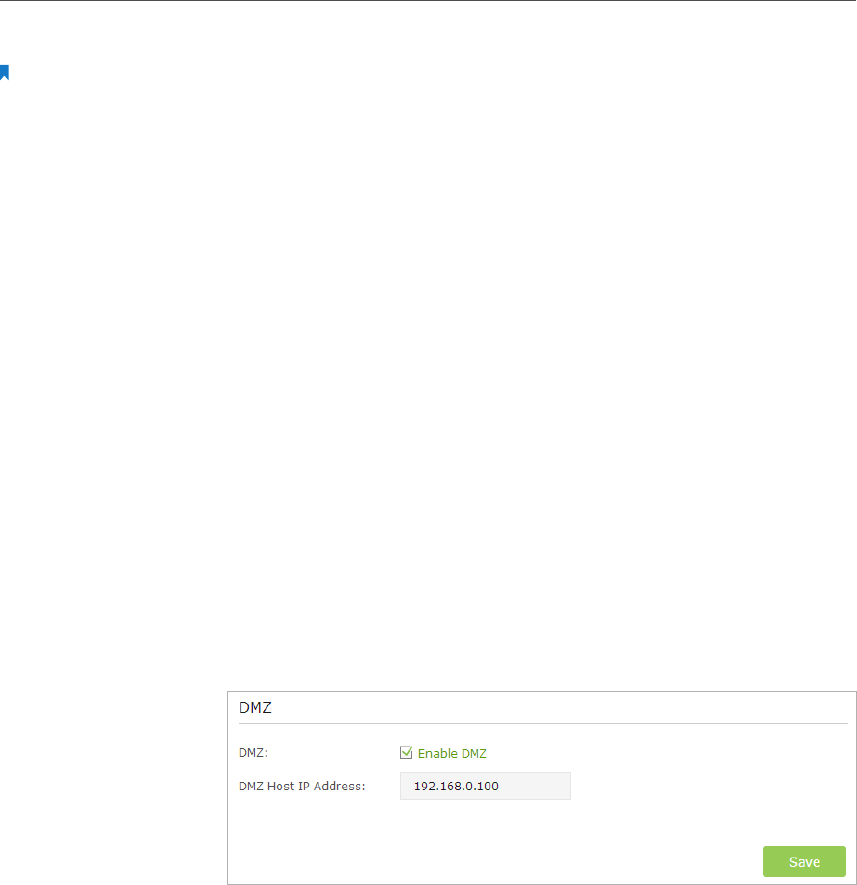
43
Chapter 9 NAT Forwarding
Note:
When DMZ is enabled, the DMZ host is totally exposed to the Internet, which may bring some potential safety
hazard. If DMZ is not in use, please disable it in time.
Make the home PC join the Internet online game without port
restriction.
For example, due to some port restriction, when playing the
online games, you can login normally but cannot join a team
with other players. To solve this problem, set your PC as a DMZ
with all ports opened.
1. Assign a static IP address to your PC, for example
192.168.0.100.
2. Visit http://tplinkwifi.net, and log in with the username and
password you set for the router.
3. Go to Advanced > NAT Forwarding > DMZ and select Enable
DMZ.
4. Enter the IP address 192.168.0.100 in the DMZ Host IP
Address filed.
5. Click Save.
The configuration is completed. You’ve set your PC to a DMZ
host and now you can make a team to game with other players.
9. 4. Make Xbox Online Games Run Smoothly by UPnP
UPnP (Universal Plug and Play) protocol allows the applications or host devices
to automatically find the front-end NAT device and send request to it to open the
corresponding ports. With UPnP enabled, the applications or host devices on both sides
of NAT device can freely communicate with each other realizing the seamless connection
of the network. You may need to enable the UPnP if you want to use applications for
multiplayer gaming, peer-to-peer connections, real-time communication (such as VoIP
or telephone conference) or remote assistance, etc.
I want to:
How can I
do that?
Done!
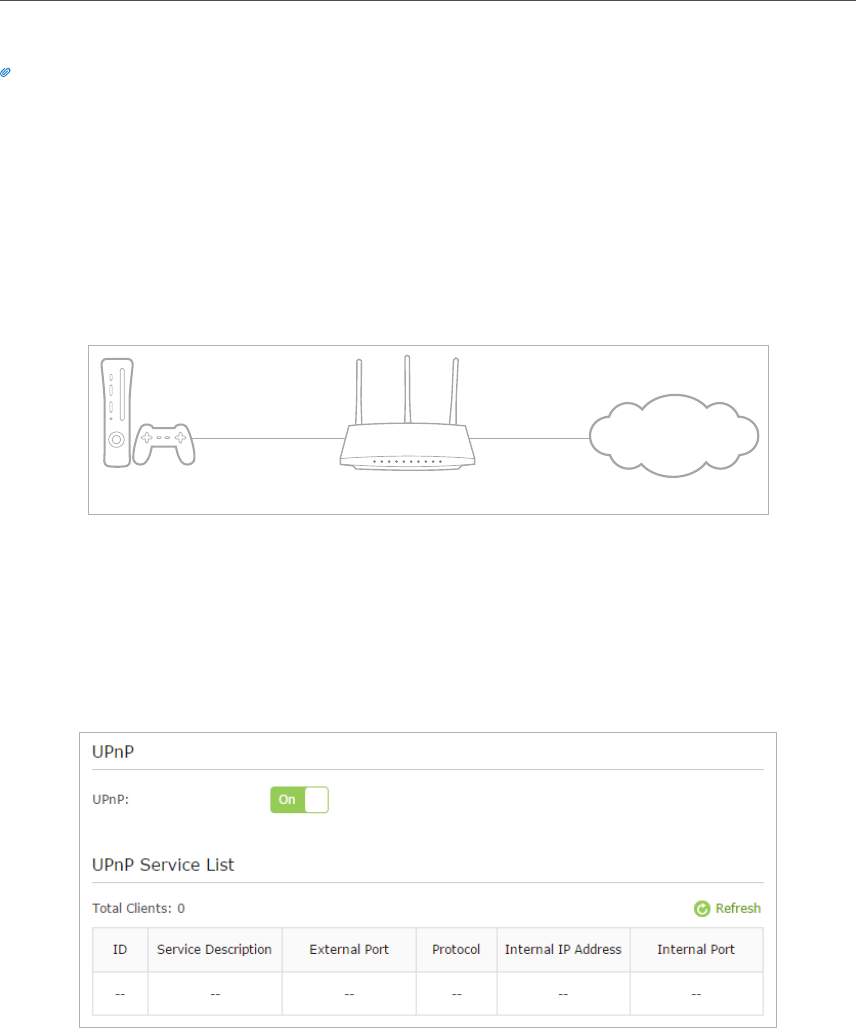
44
Chapter 9 NAT Forwarding
Tips:
1. UPnP is enabled by default in this router.
2. Only the application supporting UPnP protocol can use this feature.
3. UPnP feature needs the support of operating system (e.g. Windows Vista/ Windows 7/ Windows 8, etc. Some of
operating system need to install the UPnP components).
For example, when you connect your Xbox to the router which has connected to
the Internet to play online games, UPnP will send request to the router to open the
corresponding ports allowing the following data penetrating the NAT to transmit.
Therefore, you can play Xbox online games without a hitch.
XBOX Router
INTERNET
LAN WAN
If necessary, you can follow the steps to change the status of UPnP.
1. Visit http://tplinkwifi.net, and log in with the username and password you set for the
router.
2. Go to Advanced > NAT Forwarding > UPnP and toggle on or off according to your
needs.

Chapter 10
VPN Server
The VPN (Virtual Private Networking) Server allows you to access your home network in
a secured way through Internet when you are out of home. The router offers two ways
to setup VPN connection: OpenVPN and PPTP (Point to Point Tunneling Protocol) VPN.
OpenVPN is somewhat complex but with greater security and more stable. It is suitable
for restricted environment, such as campus network and company intranet.
PPTP VPN is more easily used and its speed is faster, it’s compatible with most operating
systems and also supports mobile devices. Its security is poor and your packets may be
cracked easily, and PPTP VPN connection may be prevented by some ISP.
This chapter contains the following sections, please choose the appropriate VPN server
connection type according to your needs.
• Use OpenVPN to Access Your Home Network
• Use PPTP VPN to Access Your Home Network
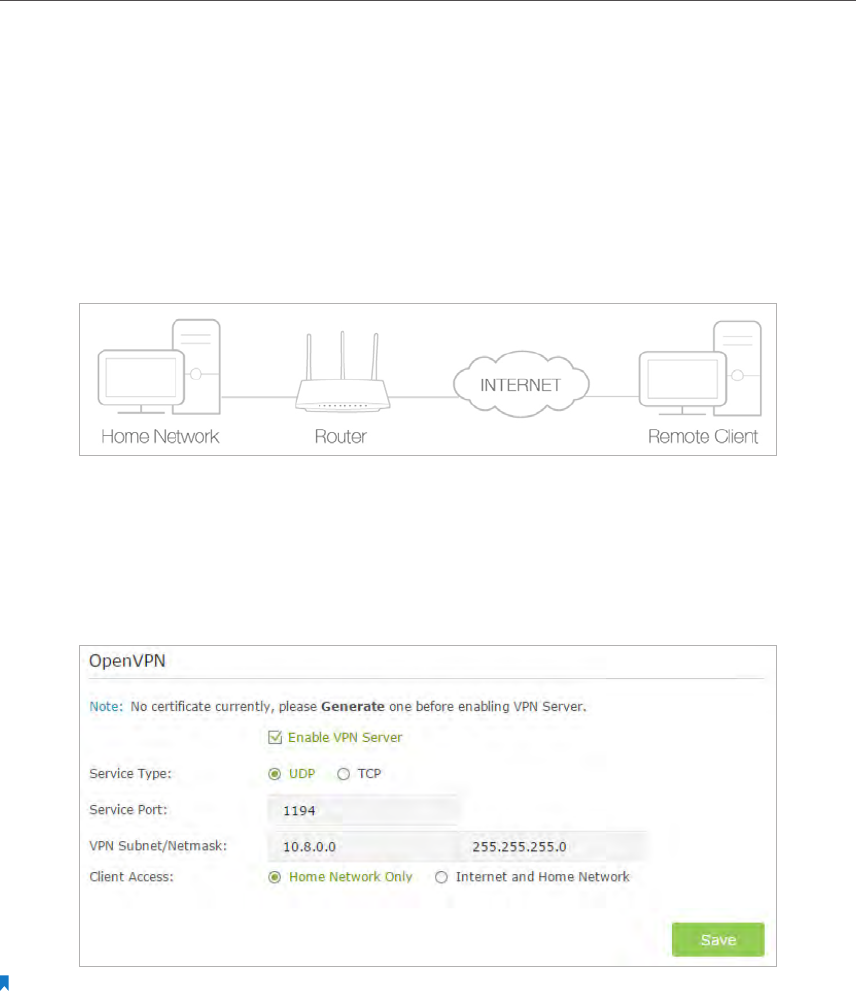
46
Chapter 10 VPN Server
10. 1. Use OpenVPN to Access Your Home Network
In the OpenVPN connection, the home network can act as a server, and the remote
client can access the server through the router which acts as an OpenVPN Server
gateway. To use the VPN feature, you should enable OpenVPN Server on your router,
and install and run VPN client software on the remote client. Please follow the steps
below to set up an OpenVPN connection.
Step1. Set up OpenVPN Server on Your Router
1. Visit http://tplinkwifi.net, and log in with the username and password you set for the
router.
2. Go to Advanced > VPN Server > OpenVPN, and select Enable VPN Server.
Note:
1. Before you enable VPN Server, we recommend you configure Dynamic DNS Service (recommended) or assign a
static IP address for router’s WAN port and synchronize your System Time with Internet.
2. The first time you configure the OpenVPN Server, you may need to Generate a certificate before you enable the
VPN Server.
3. Select the Servive Type (communication protocol) for OpenVPN Server: UDP, TCP.
4. Enter a VPN Service Port to which a VPN client connects, and the port number should
be between 1024 and 65535.
5. In VPN Subnet/Netmask field, enter the range of IP addresses that can be leased to
the client by the OpenVPN server.
6. Select your Client Access type., select Home Network Only if you only want the
remote client to access your home network, select Internet and Home Network if the
remote client also want to access Internet through VPN Server.

47
Chapter 10 VPN Server
7. Click Save.
8. Click Generate to generate a new certificate.
Note:
If you have already generated one, please skip this step, or click Generate to update the certificate.
9. Click Export to save the OpenVPN configuration file. Remote client will use this
configuration file to access your router.
Step 2. Configure OpenVPN Connection on Your Remote Client
1. Visit http://openvpn.net/index.php/download/community-downloads.html to
download the OpenVPN software, and install it on your client where you want to run
the OpenVPN client utility.
Note:
You need to install the OpenVPN client utility on each client that you plan to use for VPN connections to your router.
Mobile devices should download third-party app from Google Play or Apple App Store.
2. After the installation, copy the file exporting from your router to OpenVPN client
utility’s “config” folder (for Windows): C:\Program Files\OpenVPN\config. The path is
depending on where the OpenVPN client utility is installed on.
3. Run the OpenVPN client utility and connect it to OpenVPN Server.
10. 2. Use PPTP VPN to Access Your Home Network
PPTP VPN Server is used to create a VPN connection for remote client. To use the VPN
feature, you should enable PPTP VPN Server on your router, and configure the PPTP
connection on the remote client. Please follow the steps below to set up a PPTP VPN
connection.
Step 1. Set up PPTP VPN Server on Your Router
1. Visit http://tplinkwifi.net, and log in with the username and password you set for the
router.
2. Go to Advanced > VPN Server > PPTP VPN, and select Enable VPN Server.
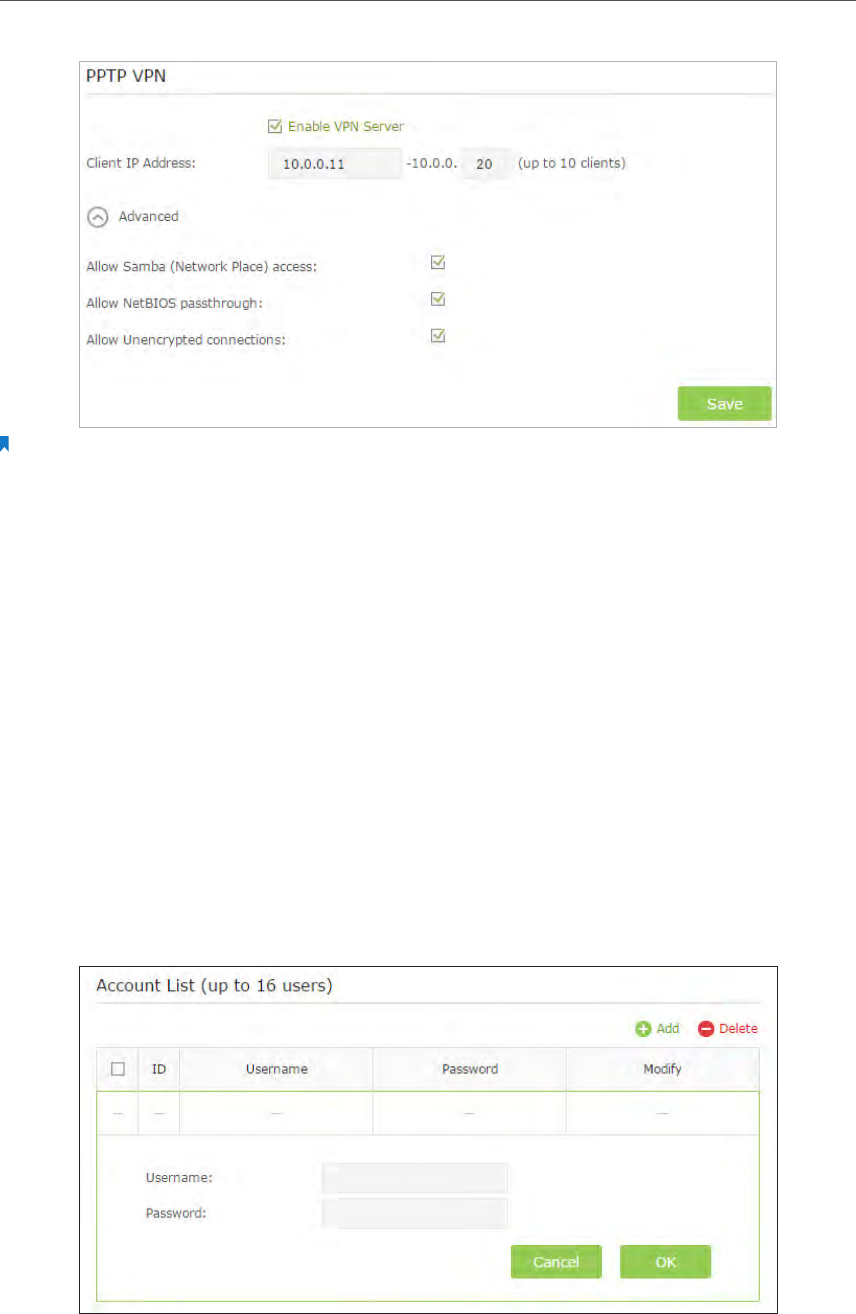
48
Chapter 10 VPN Server
Note:
Before you enable VPN Server, we recommend you configure Dynamic DNS Service (recommended) or assign a
static IP address for router’s WAN port and synchronize your System Time with Internet.
3. In the Client IP Address filed, enter the range of IP addresses (up to 10 clients) that
can be leased to the client by the PPTP VPN server.
4. Click Advanced to set the PPTP connection permission according to your needs.
• Select Allow Samba (Network Place) access to allow your VPN client to access
your local Samba server.
• Select Allow NetBIOS passthrough to allow your VPN client to access your
Samba server using NetBIOS name.
• Select Allow Unencrypted connections to allow unencrypted connections to
your VPN server.
5. Click Save.
6. Configure the PPTP VPN connection account for the remote client, you can create up
to 16 accounts.
1 ) Click Add.
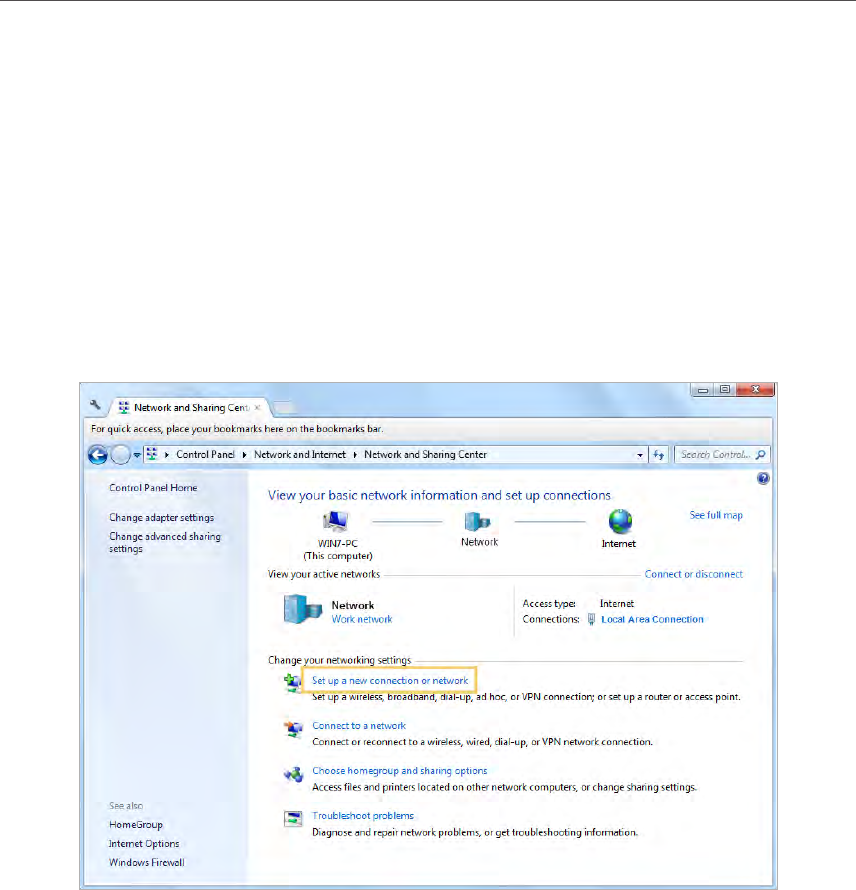
49
Chapter 10 VPN Server
2 ) Enter the Username and Password to authenticate clients to the PPTP VPN
Server.
3 ) Click OK.
Step 2. Configure PPTP VPN Connection on Your Remote Client
Remote client can use Windows built-in PPTP software or third-party PPTP software to
connect to PPTP Server. Here we use Windows built-in PPTP software as an example.
1. Go to Start > Control Panel > Network and Internet > Network and Sharing Center.
2. Select Set up a new connection or network.
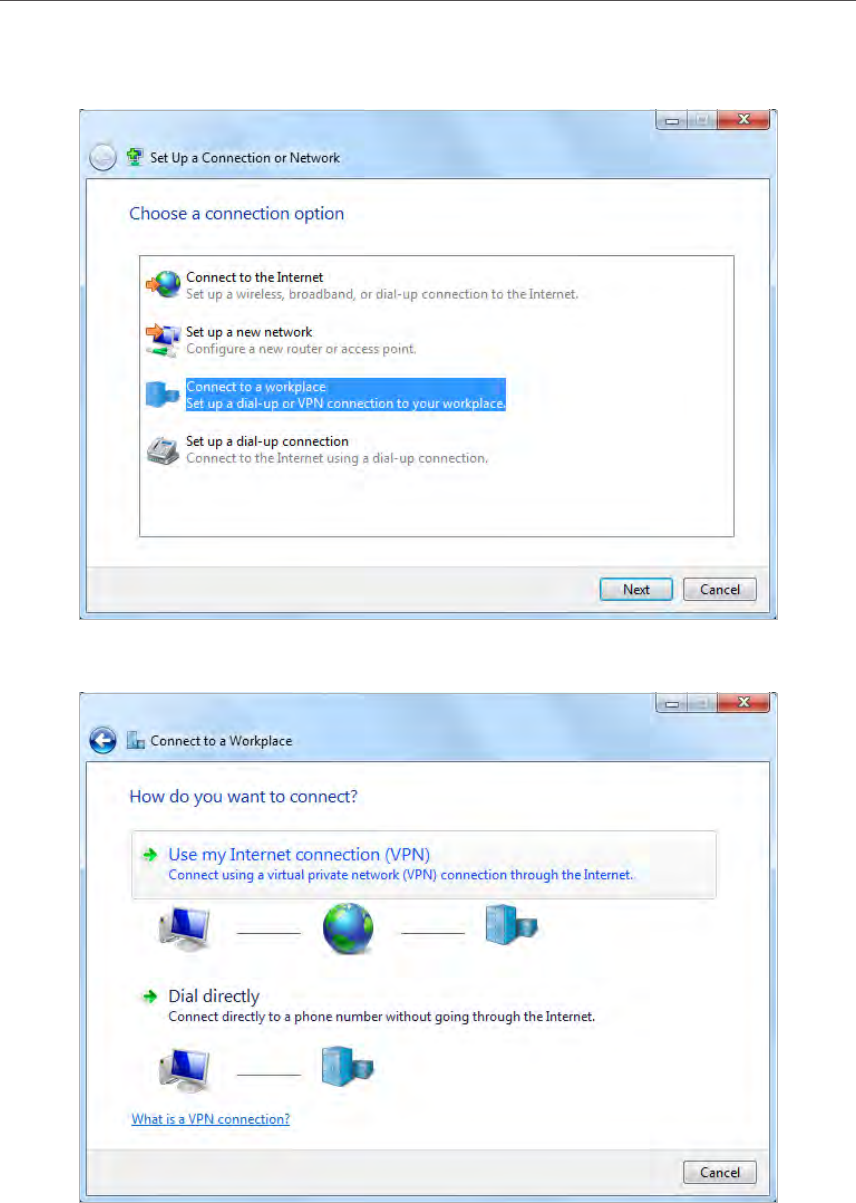
50
Chapter 10 VPN Server
3. Select Connect to a workplace and click Next.
4. Select Use my Internet connection (VPN).
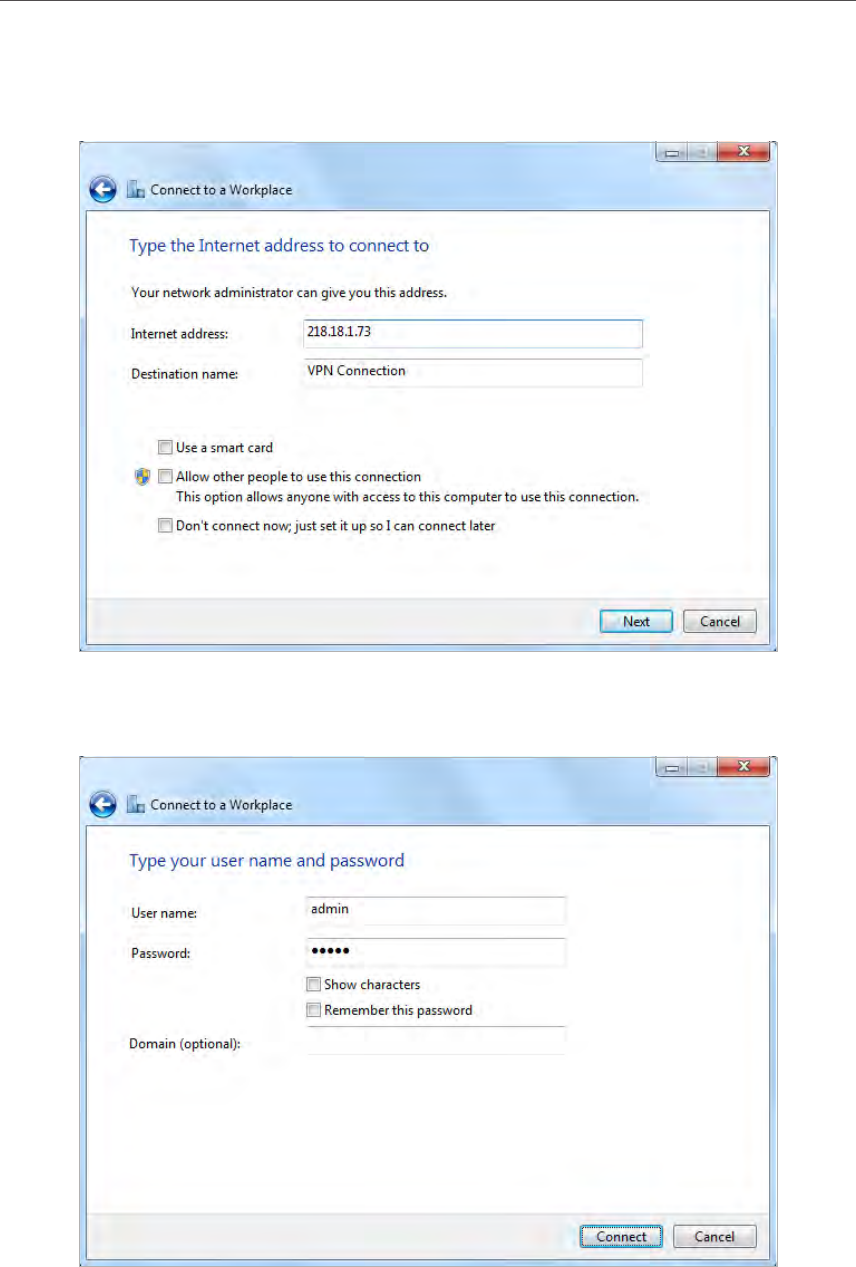
51
Chapter 10 VPN Server
5. Enter the WAN IP address of the router (for example: 218.18.1.73) in the Internet
address field. Click Next.
6. Enter the User name and Password, it’s the username and password you have set on
your router, and click Connect.
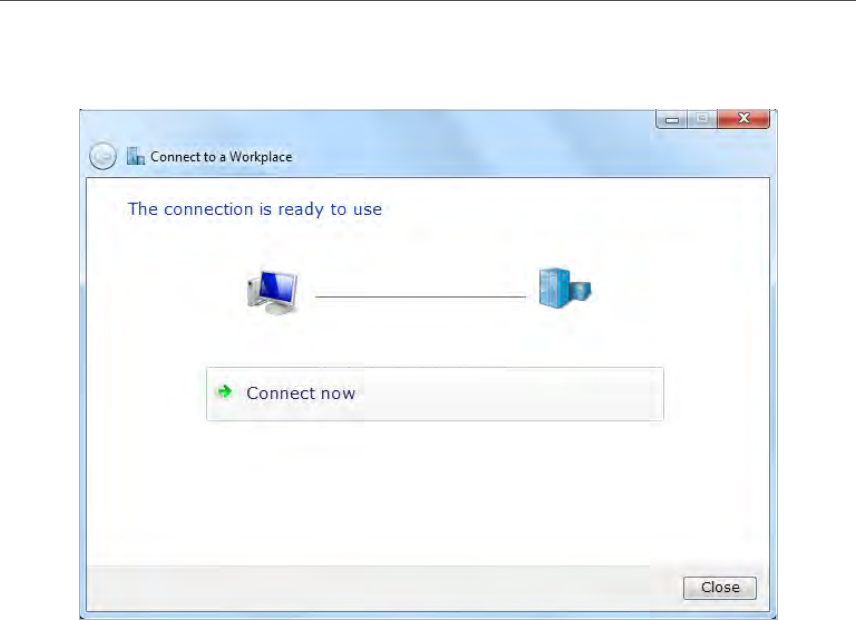
52
Chapter 10 VPN Server
7. The PPTP VPN connection is created and ready to use.

Chapter 11
Customize Your Network
Settings
This chapter guides you on how to configure advanced network features.
This chapter contains the following sections:
• Change the LAN Settings
• Configure to Support IPTV Service
• Specify DHCP Server Settings
• Set Up a Dynamic DNS Service Account
• Create Static Routes
• Specify Wireless Settings
• Use WPS for Wireless Connection
• Schedule Your Wireless Function
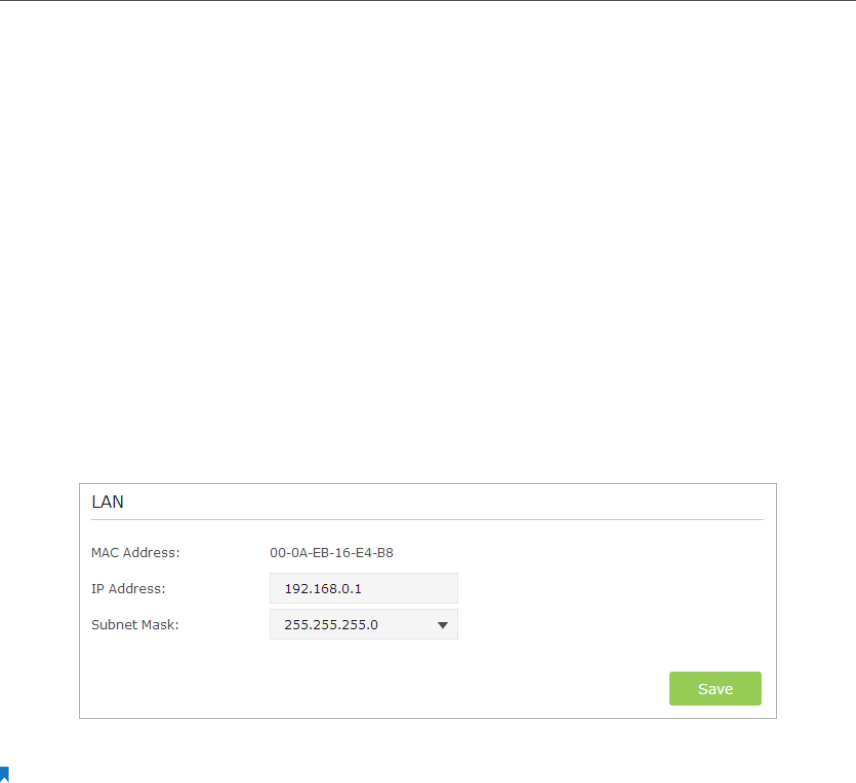
54
Chapter 11 Customize Your Network Settings
11. 1. Change the LAN Settings
The router is preset with a default LAN IP 192.168.0.1, which you can use to log in to
its web management page. The LAN IP address together with the Subnet Mask also
defines the subnet that the connected devices are on. If the IP address conflicts with
another device on your local network or your network requires a specific IP subnet, you
can change it.
1. Visit http://tplinkwifi.net, and log in with the username and password you set for the
router.
2. Go to Advanced > Network > LAN.
3. Type in a new IP Address appropriate to your needs. And leave the Subnet Mask as
the default settings.
4. Click Save.
Note:
If you have set the Virtual Server, DMZ or DHCP address reservation, and the new LAN IP address is not in the same
subnet with the old one, then you should reconfigure these features.
11. 2. Configure to Support IPTV Service
Configure IPTV setup to enable Internet/IPTV/Phone service
provided by my Internet Service Provider (ISP).
1. Visit http://tplinkwifi.net, and log in with the username and
password you set for the router.
2. Go to Advanced > Network > IPTV.
3. If your ISP provides the networking service based on IGMP
technology, e.g., British Telecom(BT) and Talk Talk in UK:
1 ) Tick the IGMP Proxy checkbox and select the IGMP
Version, either V2 or V3, as required by your ISP.
I want to:
How can
I do that?
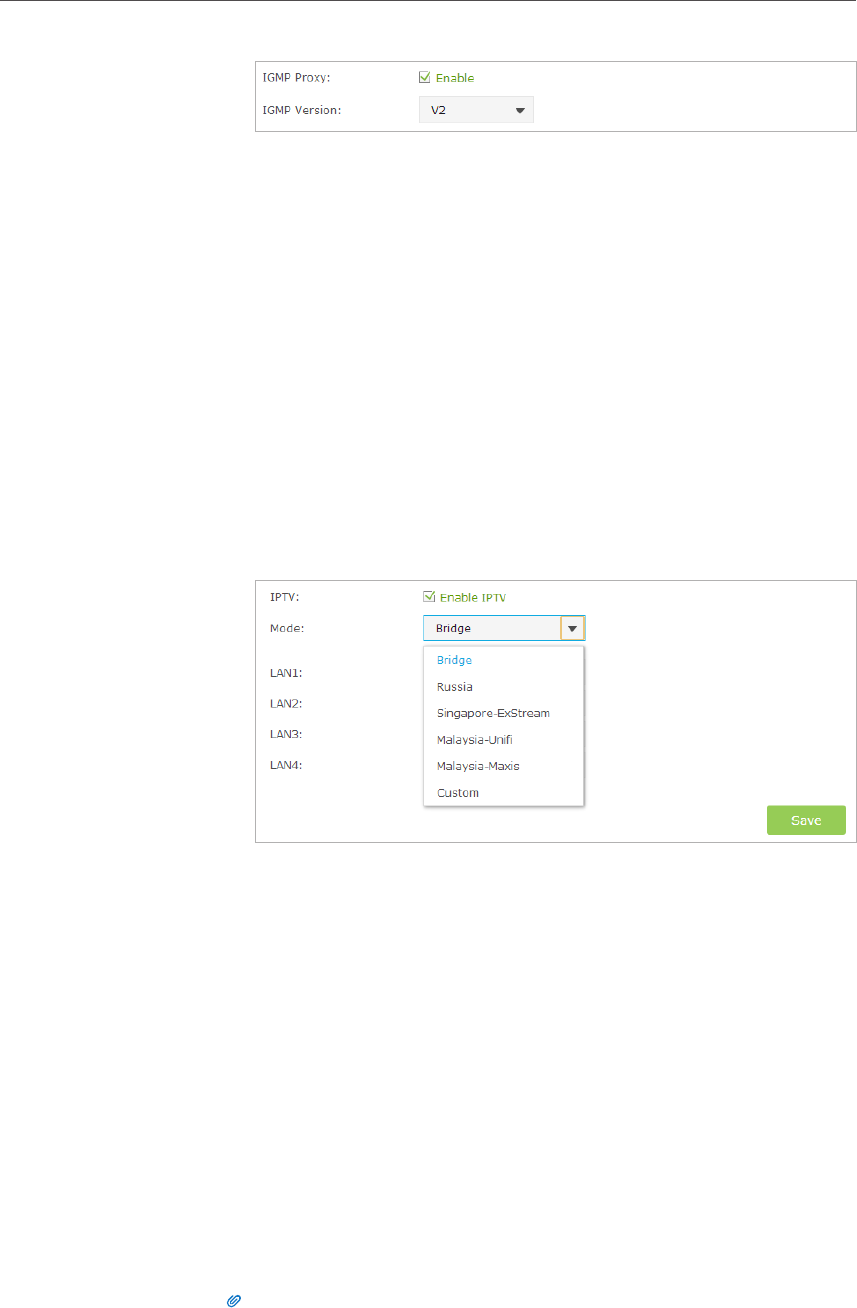
55
Chapter 11 Customize Your Network Settings
2 ) Click Save.
3 ) After configuring IGMP proxy, IPTV can work behind your
router now. You can connect your set-top box to any of
the router’s Ethernet port.
If IGMP is not the technology your ISP applies to provide
IPTV service:
1 ) Tick Enable IPTV.
2 ) Select the appropriate Mode according to your ISP.
• Select Bridge if your ISP is not listed and no other
parameters are required, and then skip to Step 4.
• Select Custom if your ISP is not listed but provides
necessary parameters.
3 ) After you have selected a mode, the necessary parameters
are predetermined. You can perform other configuration,
e.g. enter the IPTV Multicast VLAN ID and select the IPTV
Multicast VLAN Priority in Russia mode according to your
ISP.
4 ) For Russia, Singapore-ExStream, Malaysia-Unifi and
Malaysia-Maxis mode, connect the set-top box to the
predetermined LAN port. For Bridge and Custom mode,
select the LAN type and connect the set-top box to the
corresponding port.
5 ) Click Save.
Your IPTV setup is done now! You may need to configure your
set-top box before enjoying your TV.
Tips
Qos and IPTV cannot be enabled at the same time.
Done!

56
Chapter 11 Customize Your Network Settings
11. 3. Specify DHCP Server Settings
By default, the DHCP (Dynamic Host Configuration Protocol) Server is enabled and the
router acts as a DHCP server; it dynamically assigns TCP/IP parameters to client devices
from the IP Address Pool. You can change the settings of the DHCP Server if necessary,
and you can reserve LAN IP addresses for specified client devices.
1. Visit http://tplinkwifi.net, and log in with the username and password you set for the
router.
2. Go to Advanced > Network > DHCP Server.
¾To specify the IP address that the router assigns:
1. Make sure that the Enable DHCP Server checkbox is selected.
2. Enter the starting and ending IP addresses in the IP Address Pool.
3. Enter other parameters if the ISP offers, the Default Gateway is automatically filled
and is the same as the LAN IP address of the router.
4. Click Save.
¾To reserve an IP address for a specified client device:
1. Click Add in the Address Reservation section.
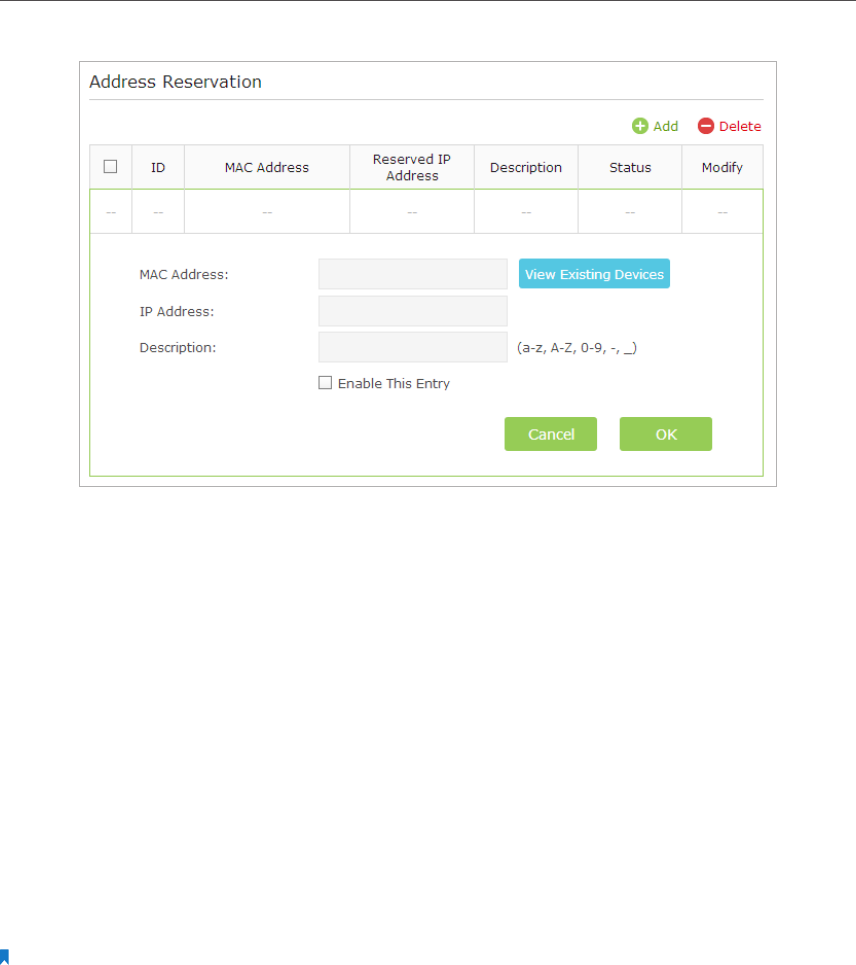
57
Chapter 11 Customize Your Network Settings
2. Click View Exsiting Devices or enter the MAC address of the client device.
3. Enter the IP address to reserve for the client device.
4. Enter the Description for this entry.
5. Tick the Enable This Entry checkbox and click OK.
11. 4. Set Up a Dynamic DNS Service Account
Most ISPs assign a dynamic IP address to the router and you can use this IP address
to access your router remotely. However, the IP address can change any time and
you don’t know when it changes. In this case, you might apply the DDNS (Dynamic
Domain Name Server) feature on the router to allow you and your friends to access
your router and local servers (FTP, HTTP, etc.) using domain name without checking and
remembering the IP address.
Note:
DDNS does not work if the ISP assigns a private WAN IP address (such as 192.168.1.x) to the router.
To set up DDNS, please follow the instructions below:
1. Visit http://tplinkwifi.net, and log in with the username and password you set for the
router.
2. Go to Advanced > Network > Dynamic DNS.
3. Select the DDNS Service Provider (NO-IP or DynDNS). If you don’t have a DDNS
account, select a service provider and click Go to register.
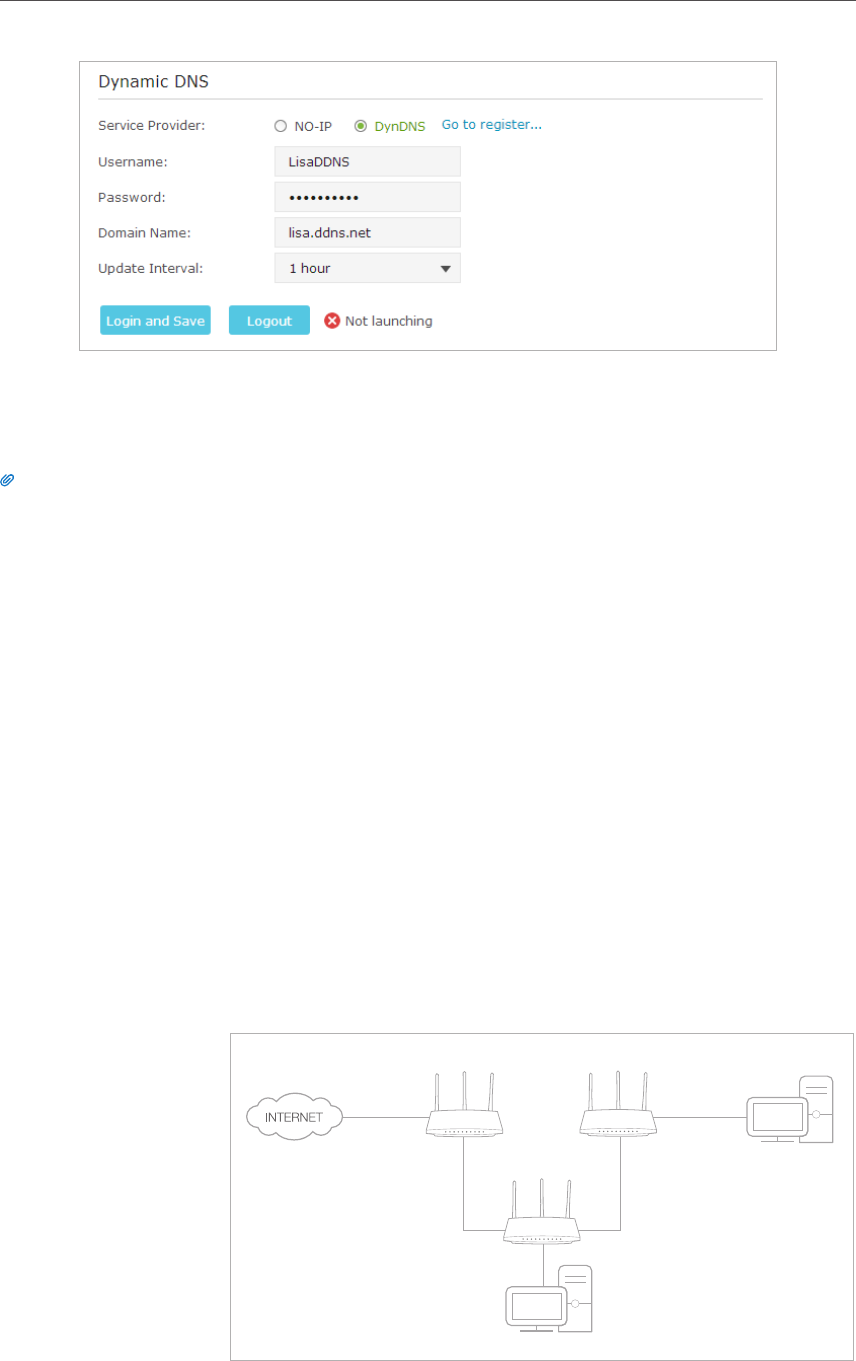
58
Chapter 11 Customize Your Network Settings
4. Enter the username, password and domain name of the account (such as
lisadns.ddns.net).
5. Click Login and Save.
Tips:
If you want to use a new DDNS account, please logout first, and then login with the new account.
11. 5. Create Static Routes
Static routing is a form of routing that is configured manually by a network administrator
or a user by adding entries into a routing table. The manually-configured routing
information guides the router in forwarding data packets to the specific destination.
Visit multiple networks and servers at the same time.
For example, in a small office, my PC can surf the Internet, but
I also want to visit my company’s network. Now I have a switch
and another router. I connect the devices as shown in the
following figure so that the physical connection between my
PC and my company’s server is established. To surf the Internet
and visit my company’s network at the same time, I need to
configure the static routing.
PC 1
PC 2
Router 2
Router 1
Router 3
LAN: 192.168.0.1
192.168.0.100
LAN: 192.168.0.2
WAN: 172.30.30.100
172.30.30.1
I want to:
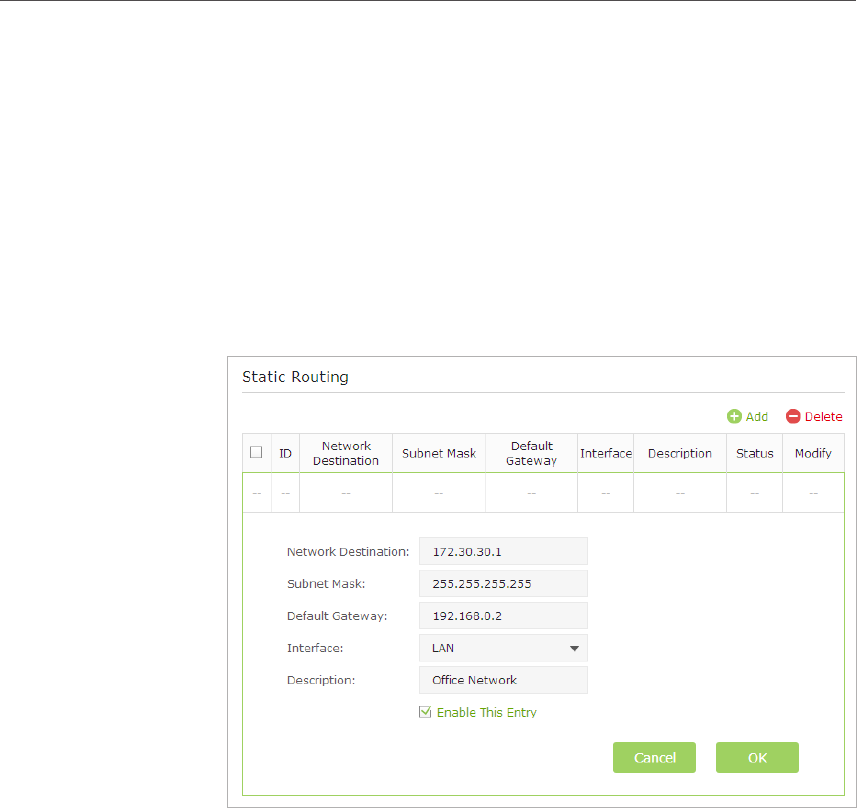
59
Chapter 11 Customize Your Network Settings
1. Change the router’s LAN IP addresses to two different IP
addresses on the same subnet. Disable Router 2’s DHCP
function.
2. Visit http://tplinkwifi.net, and log in with the username and
password you set for the router.
3. Go to Network > Advanced Routing.
4. Click Add and finish the settings according to the following
explanations:
Network Destination: The destination IP address that you want
to assign to a static route. This IP address cannot be on the same
subnet with the WAN IP or LAN IP of the router. In the example,
the IP address of the company network is the destination IP
address, so here enter 172.30.30.1.
Subnet Mask: Determines the destination network with the
destination IP address. If the destination is a single IP address,
enter 255.255.255.255; otherwise, enter the subnet mask of
the corresponding network IP. In the example, the destination
network is a single IP, so here enter 255.255.255.255.
Default Gateway: The IP address of the gateway device to which
the data packets will be sent. This IP address must be on the
same subnet with the router’s IP which sends out data. In the
example, the data packets will be sent to the LAN port of Router
2 and then to the Server, so the default gateway should be
192.168.0.2.
How can
I do that?

60
Chapter 11 Customize Your Network Settings
Interface: Determined by the port (WAN/LAN) that sends out
data packets. In the example, the data are sent to the gateway
through the LAN port, so LAN should be selected.
Description: Enter a description for this static routing entry.
5. Click OK.
6. Check the System Routing Table below. If you can find the
entry you’ve set, the static routing is set successfully.
Open a web browser on your PC. Enter the company server’s IP
address to visit the company network.
11. 6. Specify Wireless Settings
The router’s wireless network name (SSID) and password, and security option are preset
in the factory. The preset SSID and password can be found on the label of the router.
You can customize the wireless settings according to your needs.
Visit http://tplinkwifi.net, and log in with the username and password you set for the
router.
¾To enable or disable the wireless function:
1. Go to Basic > Wireless.
2. The wireless radio is enabled by default, if you want to disable the wireless function of
the router, just clear the Enable Wireless Radio checkbox. In this case, all the wireless
settings will be invalid.
¾To change the wireless network name (SSID) and wireless password:
1. Go to Basic > Wireless.
2. Create a new SSID in Network Name (SSID) and customize the password for the
network in Password. The value is case-sensitive.
Note:
If you change the wireless settings with a wireless device, you will be disconnected when the settings are effective.
Please write down the new SSID and password for future use.
Done!
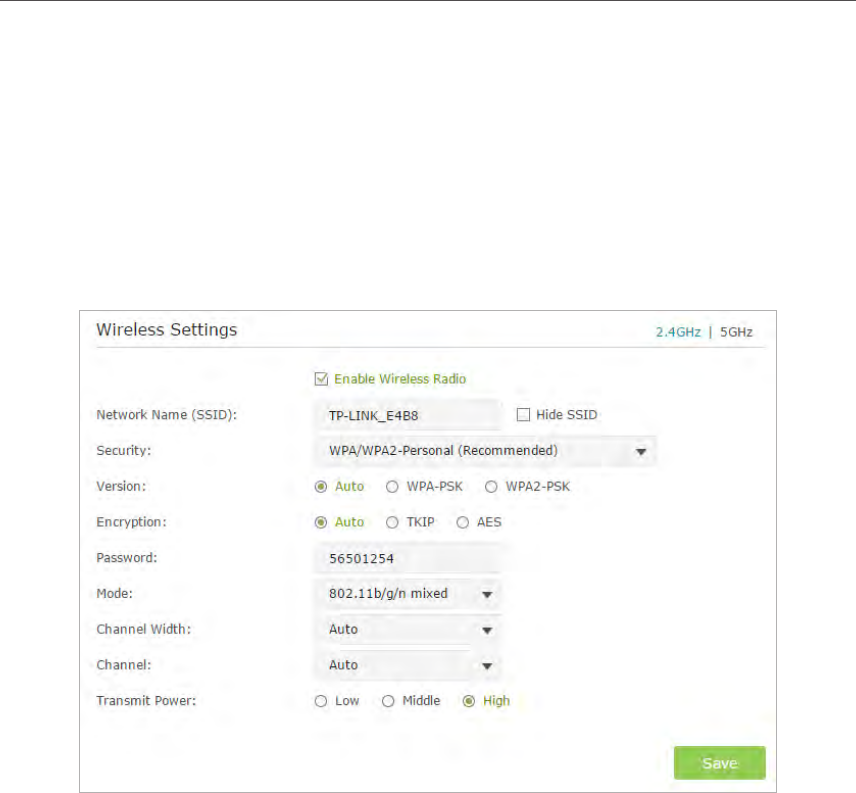
61
Chapter 11 Customize Your Network Settings
¾To hide SSID:
1. Go to Basic > Wireless.
2. Select Hide SSID, and your SSID won’t display when you scan for local wireless
networks on your wireless device and you need to manually join the network.
¾To change the security option:
1. Go to Advanced > Wireless > Wireless Settings.
2. Select the wireless network 2.4GHz or 5GHz.
3. Select an option from the Security drop-down list. We recommend you don’t change
the default settings unless necessary. If you select other options, configure the
related parameters according to the help page.
In addition
• Mode — Select a transmission mode according to your wireless client devices. It is
recommended to just leave it as default.
• Channel Width — Select a channel width (bandwidth) for the wireless network.
• Channel — Select an operating channel for the wireless network. It is recommended
to leave the channel to Auto, if you are not experiencing the intermittent wireless
connection issue.
• Transmit Power — Select either High, Middle or Low to specify the data transmit power.
The default and recommended setting is High.
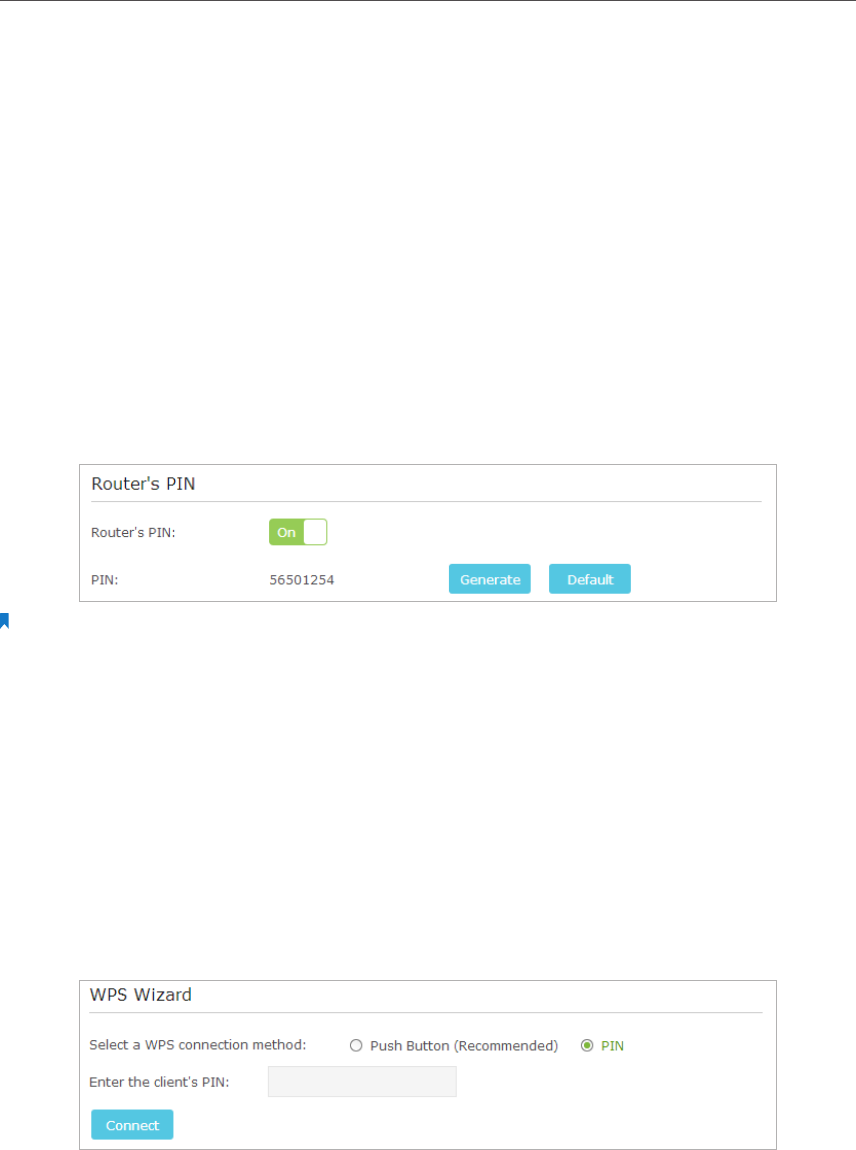
62
Chapter 11 Customize Your Network Settings
11. 7. Use WPS for Wireless Connection
Wi-Fi Protected Setup (WPS) provides an easier approach to set up a security-protected
Wi-Fi connection.
1. Visit http://tplinkwifi.net, and log in with the username and password you set for the
router.
2. Go to Advanced > Wireless > WPS .
11. 7. 1. Set the Router’s PIN
Router’s PIN is enabled by default to allow wireless devices to connect to the router
using the PIN. You can use the default one or generate a new one.
Note:
1. If you want to enable/disable the WPS feature, go to System Tools > System Parameters > WPS, select or clear the
Enable WPS check box.
2. PIN (Personal Identification Number) is an eight-character identification number preset to each router. WPS
supported devices can connect to your router with the PIN. The default PIN is printed on the label of the router.
11. 7. 2. Use the WPS Wizard for Wi-Fi Connections
1. Select a setup method:
• Push Button(Recommended): Click Connect on the screen. Within two
minutes, press the WPS button on the client device.
• PIN: Enter the client’s PIN, and click Connect.
2. Success will appear on the above screen and the WPS LED on the router will keep on
for five minutes if the client has been successfully added to the network.
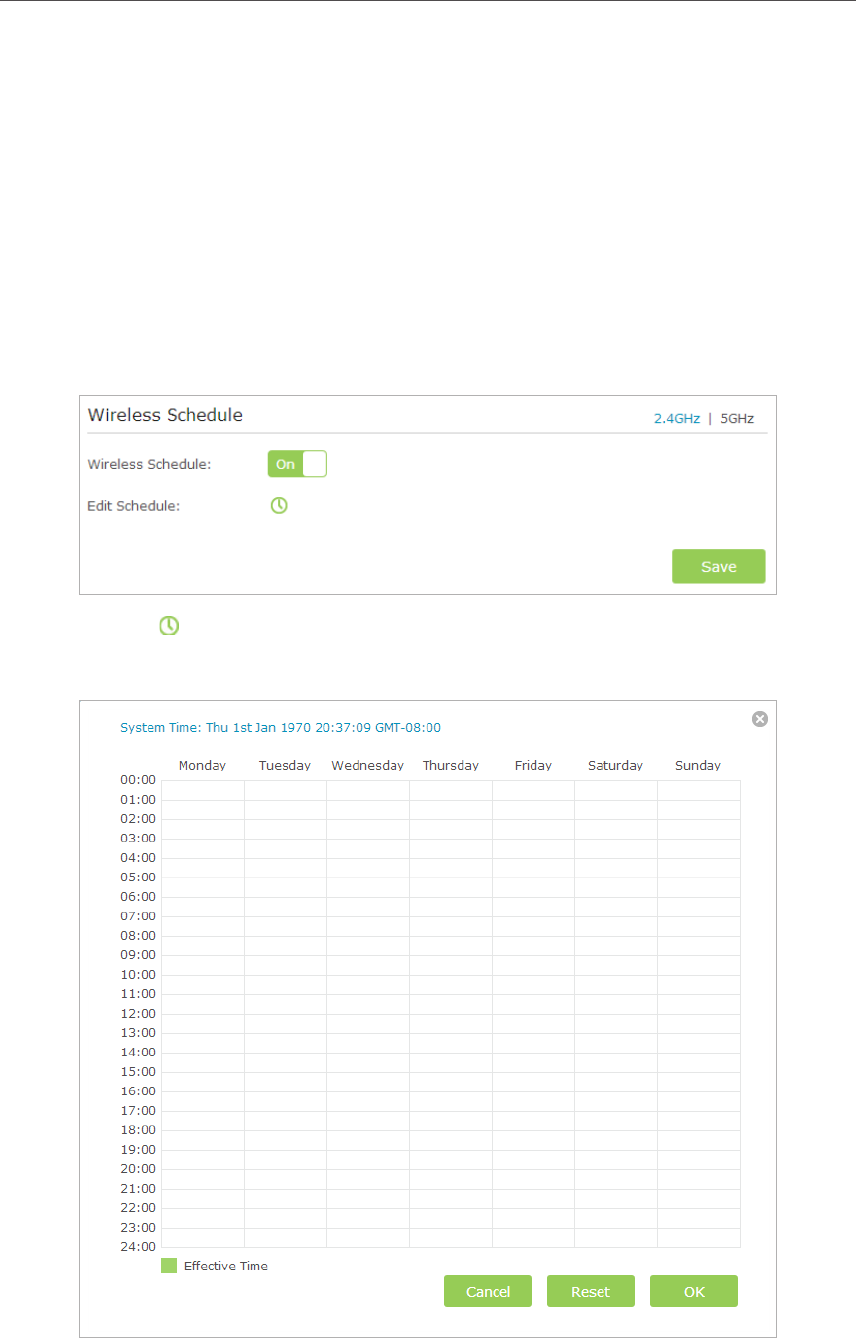
63
Chapter 11 Customize Your Network Settings
11. 8. Schedule Your Wireless Function
The wireless network can be automatically off at a specific time when you do not need
the wireless connection.
1. Visit http://tplinkwifi.net, and log in with the username and password you set for the
router.
2. Go to Advanced > Wireless > Wireless Schedule.
3. Select 2.4GHz or 5GHz to change the corresponding settings.
4. Toggle On to enable the Wireless Schedule feature.
5. Click the icon to set the Effective Time. Drag the cursor over the cells to choose the
period during which you need the wireless off automatically, and click OK.

64
Chapter 11 Customize Your Network Settings
6. Click Save.
7. If you also want to set wireless off time for other band(s), please repeat the steps
above.
Note:
1. The Effective Time Schedule is based on the time of the router. You can go to Advanced > System Tools > Time
Settings to modify the time.
2. The wireless LED will be off if the corresponding wireless network is disabled.
3. The wireless network will be automatically turned on after the time period you set.

Chapter 12
Manage the Router
This chapter will show you the configuration for managing and maintaining your router.
This chapter includes the following sections:
• Set Up System Time
• Test the Network Connectivity
• Upgrade the Firmware
• Backup and Restore Configuration Settings
• Change the Administrator Account
• Password Recovery
• Local Management
• Remote Management
• System Log
• Monitor the Internet Traffic Statistics
• Control LEDs
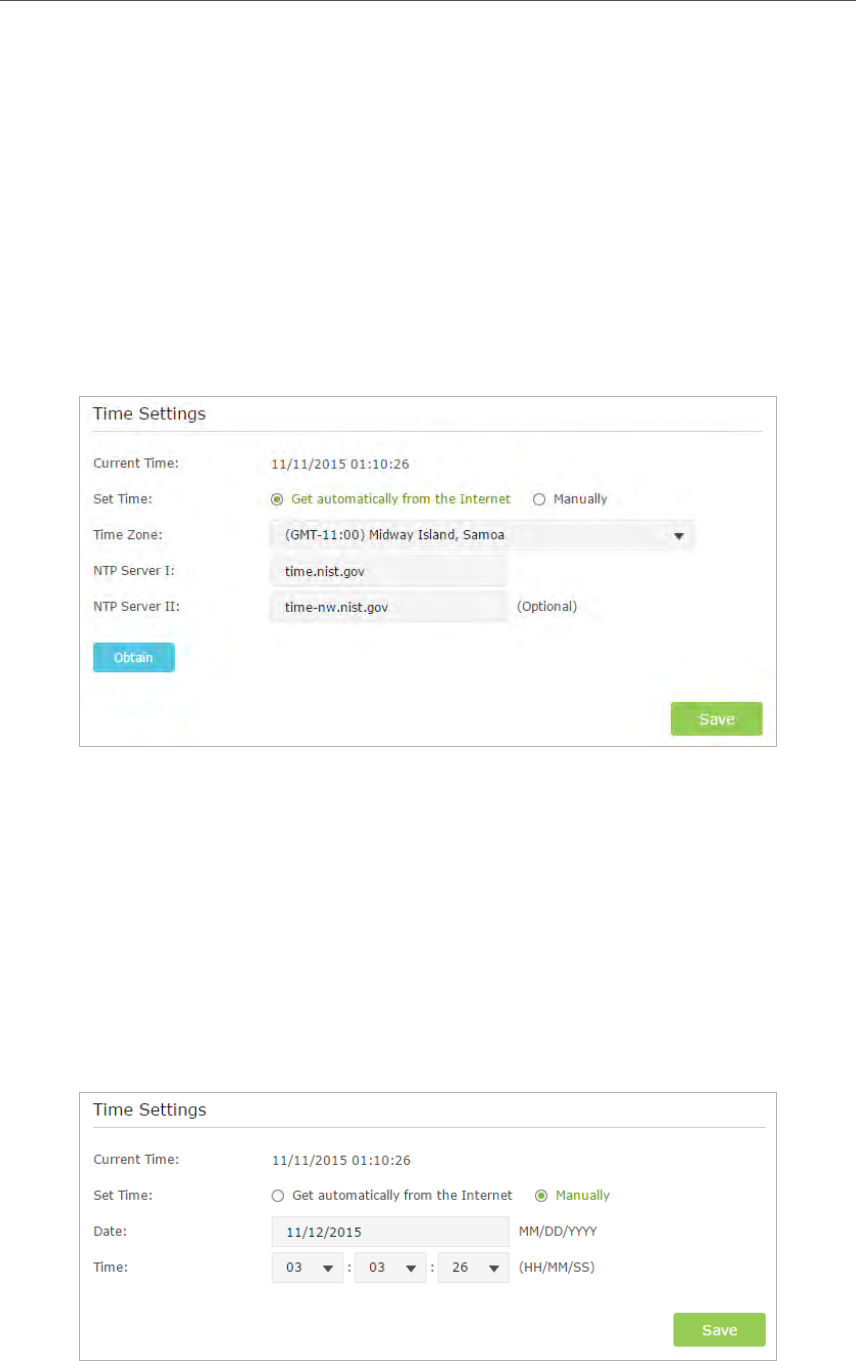
66
Chapter 12 Manage the Router
12. 1. Set Up System Time
System time is the time displayed while the router is running. The system time you
configure here will be used for other time-based functions like Parental Controls. You
can choose the way you prefer to obtain the system time.
Visit http://tplinkwifi.net, and log in with the username and password you set for the
router. Go to Advanced > System Tools > Time Settings.
¾To get time from the Internet:
1. In the Set Time field, select Get automatically from the Internet.
2. Select your local Time Zone from the drop-down list.
3. In the NTP Server I fileld, enter the IP address or domain name of your desired NTP
Server.
4. In the NTP Server II fileld, enter the IP address or domain name of the second NTP
Server. (Optional)
5. Click Obtain to get the current Internet time and click Save.
¾To manually set the date and time:
1. In the Set Time field, select Manually.
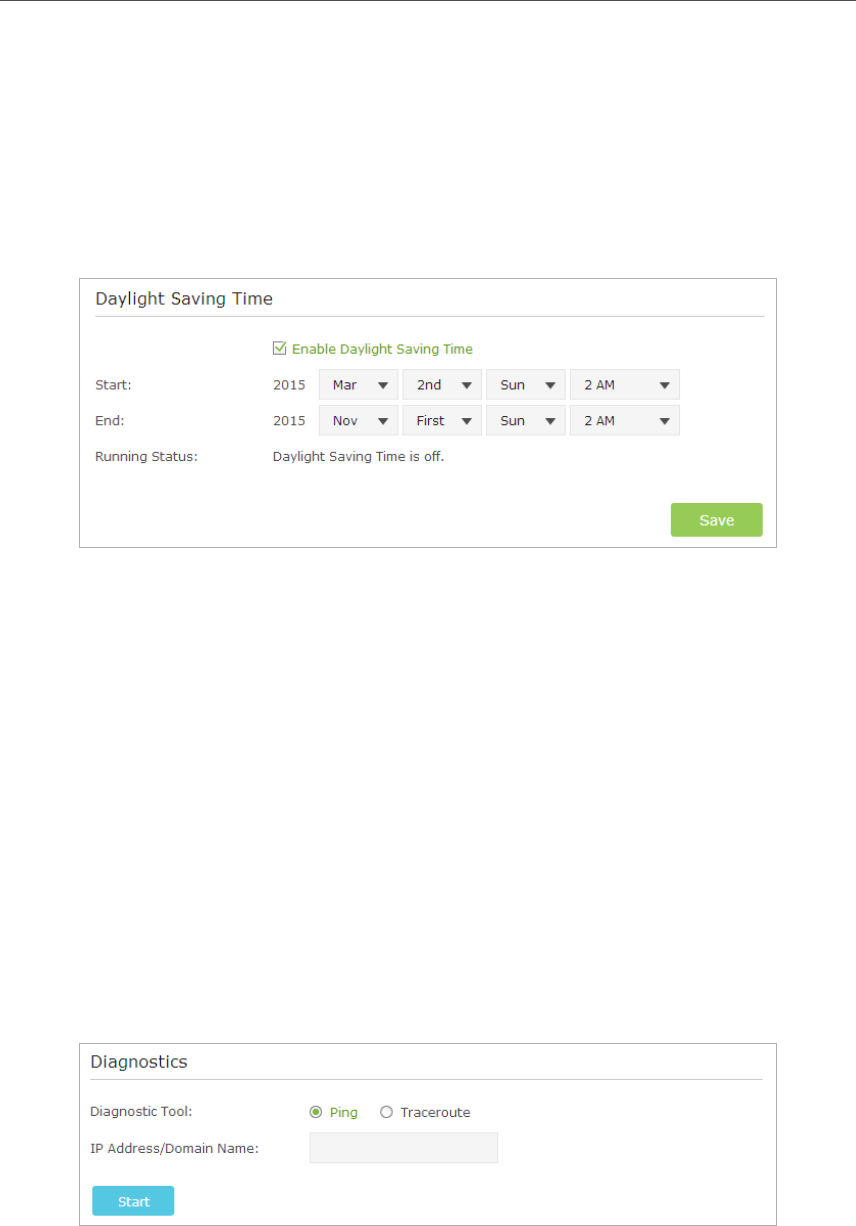
67
Chapter 12 Manage the Router
2. Set the current Date (In MM/DD/YYYY format).
3. Set the current Time (In HH/MM/SS format).
4. Click Save.
¾To set up Daylight Saving Time:
1. Select Enable Daylight Saving Time.
2. Select the correct Start date and time when daylight saving time starts at your local
time zone.
3. Select the correct End date and time when daylight saving time ends at your local
time zone.
4. Click Save.
12. 2. Test the Network Connectivity
Diagnostics is used to test the connectivity between the router and the host or other
network devices.
1. Visit http://tplinkwifi.net, and log in with the username and password you set for the
router.
2. Go to Advanced > System Tools > Diagnostics.
3. Enter the information with the help of page tips:
1 ) Choose Ping or Traceroute as the diagnostic tool to test the connectivity;
• Ping is used to test the connectivity between the router and the tested host,
and measure the round-trip time.
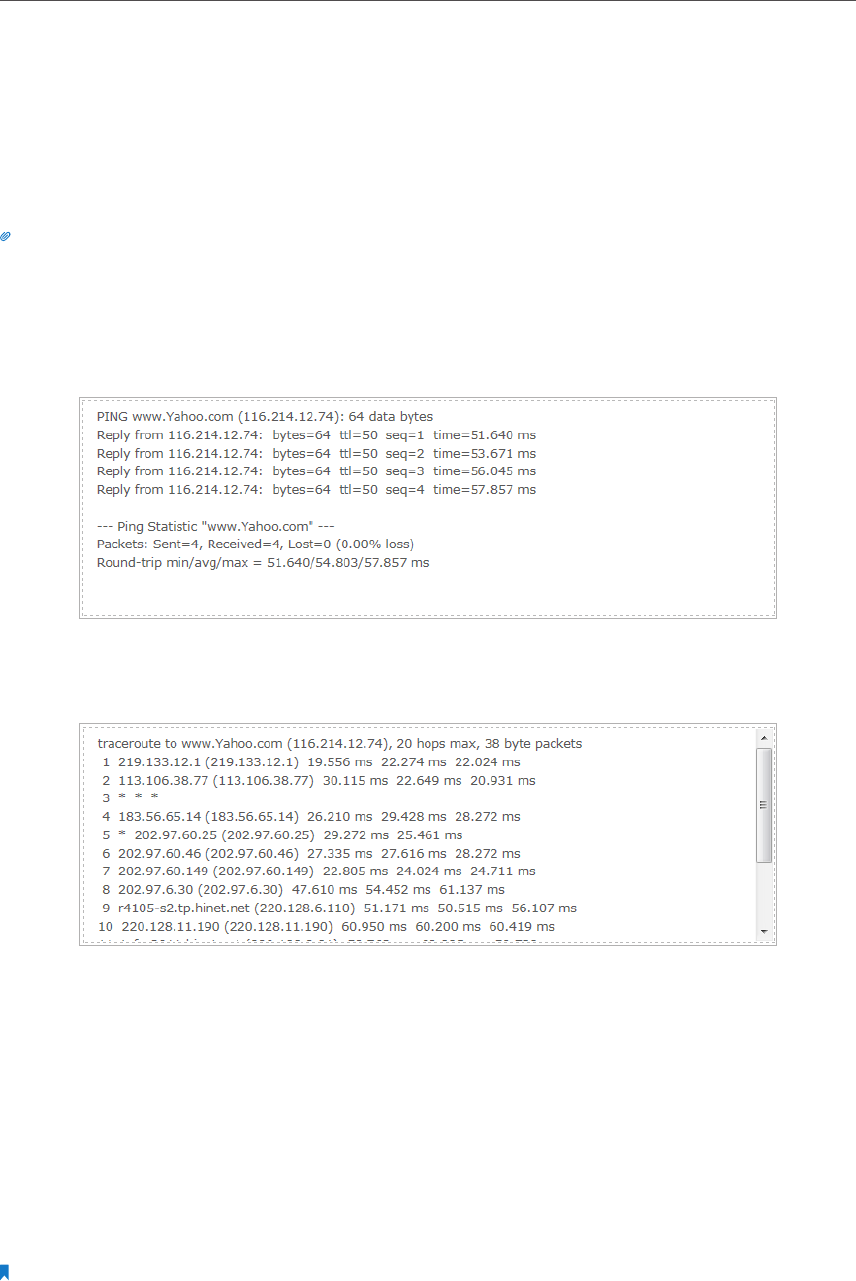
68
Chapter 12 Manage the Router
• Traceroute is used to display the route (path) your router has passed to reach
the tested host, and measure transit delays of packets across an Internet
Protocol network.
2 ) Enter the IP Address or Domain Name of the tested host.
4. Click Start to begin the diagnostics.
Tips:
Click Advanced, you can modify the ping count, ping packet size or the Traceroute Max TTL. It’s recommended to
keep the default value.
The figure below indicates the proper connection between the router and the Yahoo
server (www.Yahoo.com) tested through Ping.
The figure below indicates the proper connection between the router and the Yahoo
server (www.Yahoo.com) tested through Traceroute.
12. 3. Upgrade the Firmware
TP-LINK aims at providing better network experience for users.
We will inform you throught the web management page if there’s any update firmware
available for your router. Also, the latest firmware will be released at TP-LINK official
website, you can download it from the Support page of our website www.tp-link.com
for free.
Note:
1. Make sure you remove all attached USB storage devices from the router before the firmware upgrade to prevent
data loss.
2. Backup your router configuration before firmware upgrade.
3. Do NOT turn off the router during the firmware upgrade.
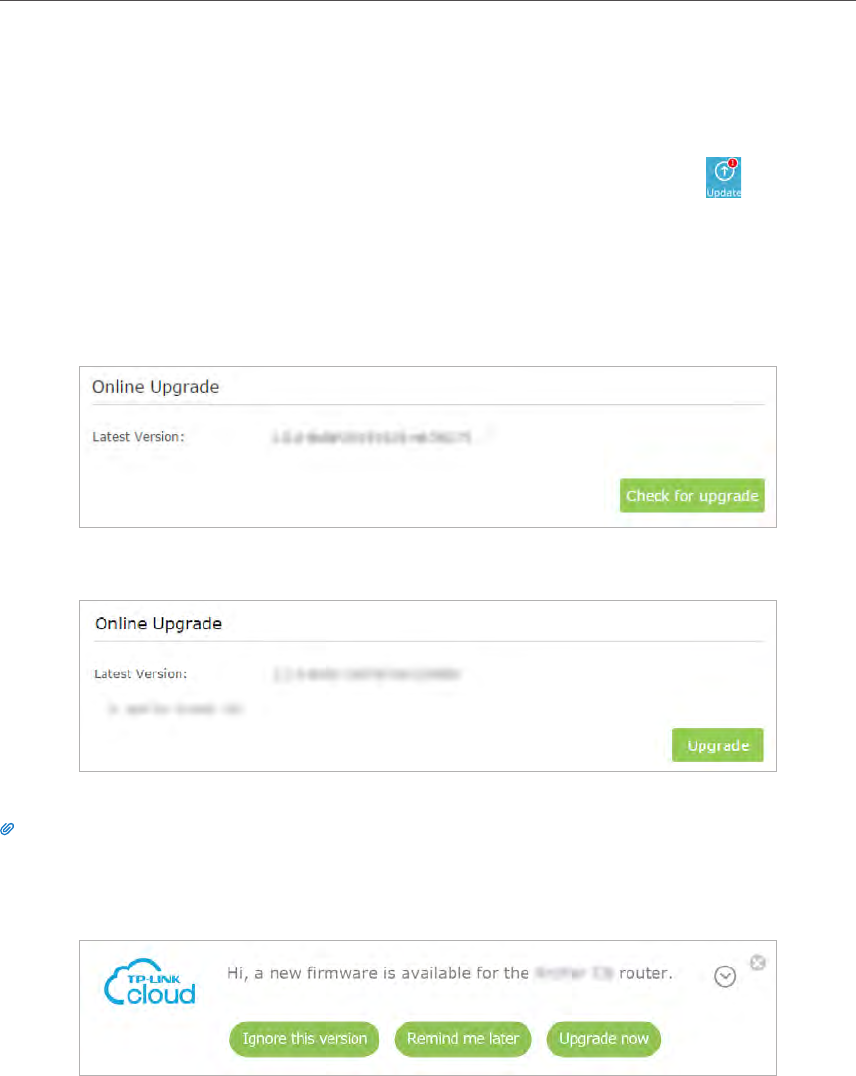
69
Chapter 12 Manage the Router
12. 3. 1. Online Upgrade
1. Visit http://tplinkwifi.net, and log in with the username and password you’ve set for
the router.
2. When the latest firmware is available for your router, the update icon will display
in the top-right corner of the page. Click the icon to go to the Firmware Upgrade
page.
Alternatively, you can go to Advanced > System Tools > Firmware Upgrade, and click
Check for upgrade to see whether the latest firmware is released.
3. Focus on the Online Upgrade section, and click Upgrade.
4. Wait a few moments for the upgrade and reboot to complete.
Tips:
If there’s a new and important firmware update for your router, you will see the notification (similar as shown below)
on your computer as long as a web browser is opened. Click Upgrade now, and log into the web management page
with the username and password you set for the router. You will see the Firmware Upgrade page.
12. 3. 2. Local Upgrade
1. Download the latest firmware file for the router from www.tp-link.com.
2. Visit http://tplinkwifi.net, and log in with the username and password you set for the
router.
3. Go to Advanced > System Tools > Firmware Upgrade.
4. Focus on the Device Information section. Make sure the downloaded firmware file is
matched with the Hardware Version.
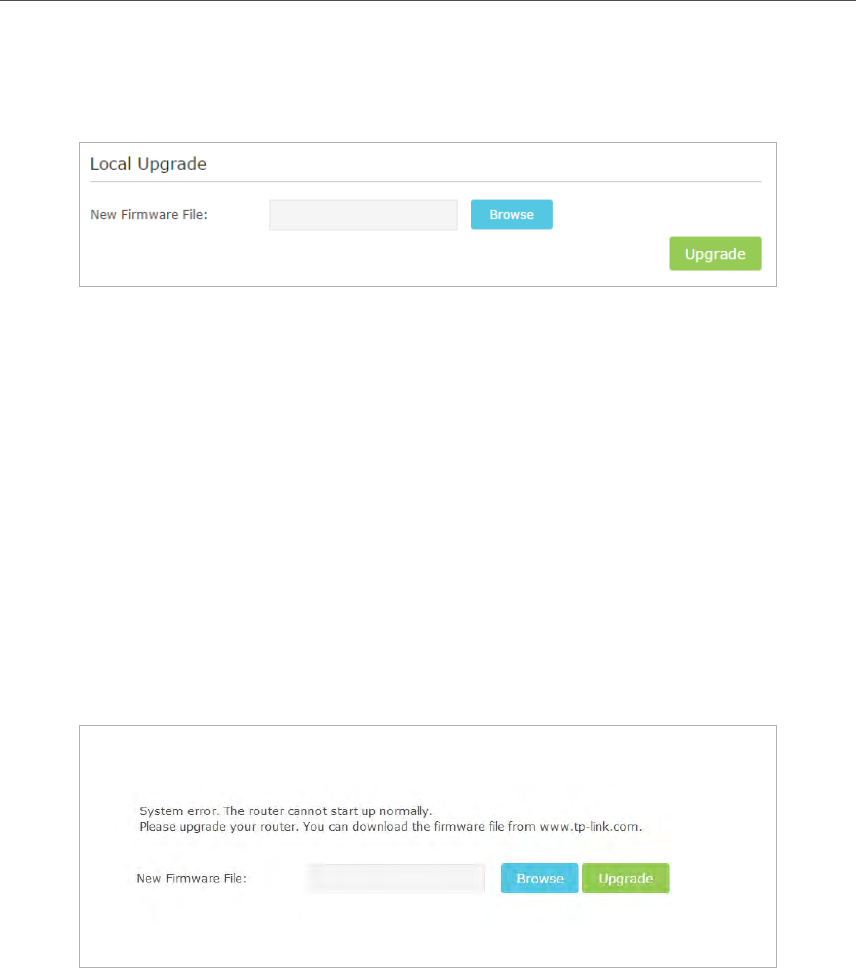
70
Chapter 12 Manage the Router
5. Focus on the Local Upgrade section. Click Browse to locate the downloaded new
firmware file, and click Upgrade.
6. Wait a few moments for the upgrade and reboot to complete.
12. 3. 3. Restore Interrupted Upgrade after Power Failure
If your router cannot start up after an upgrade interruption due to power failure, do
follow the steps below to restore the interrupted upgrade. Otherwise, your router
cannot work again.
1. Make sure you have the latest firmware file in your computer. If not, try another way
to connect your computer to the Internet and download the latest firmware file from
www.tp-link.com.
2. Connect your computer to the router with an Ethernet cable.
3. Visit http://tplinkwifi.net and you will see the following upgrade page.
4. Click Browse and select the downloaded firmware file.
5. Click Upgrade and wait for a few minutes until the router completes the upgrading
and restarts.
12. 4. Backup and Restore Configuration Settings
The configuration settings are stored as a configuration file in the router. You can
backup the configuration file to your computer for future use and restore the router to
a previous settings from the backup file when needed. Moreover, if necessary you can
erase the current settings and reset the router to the default factory settings.
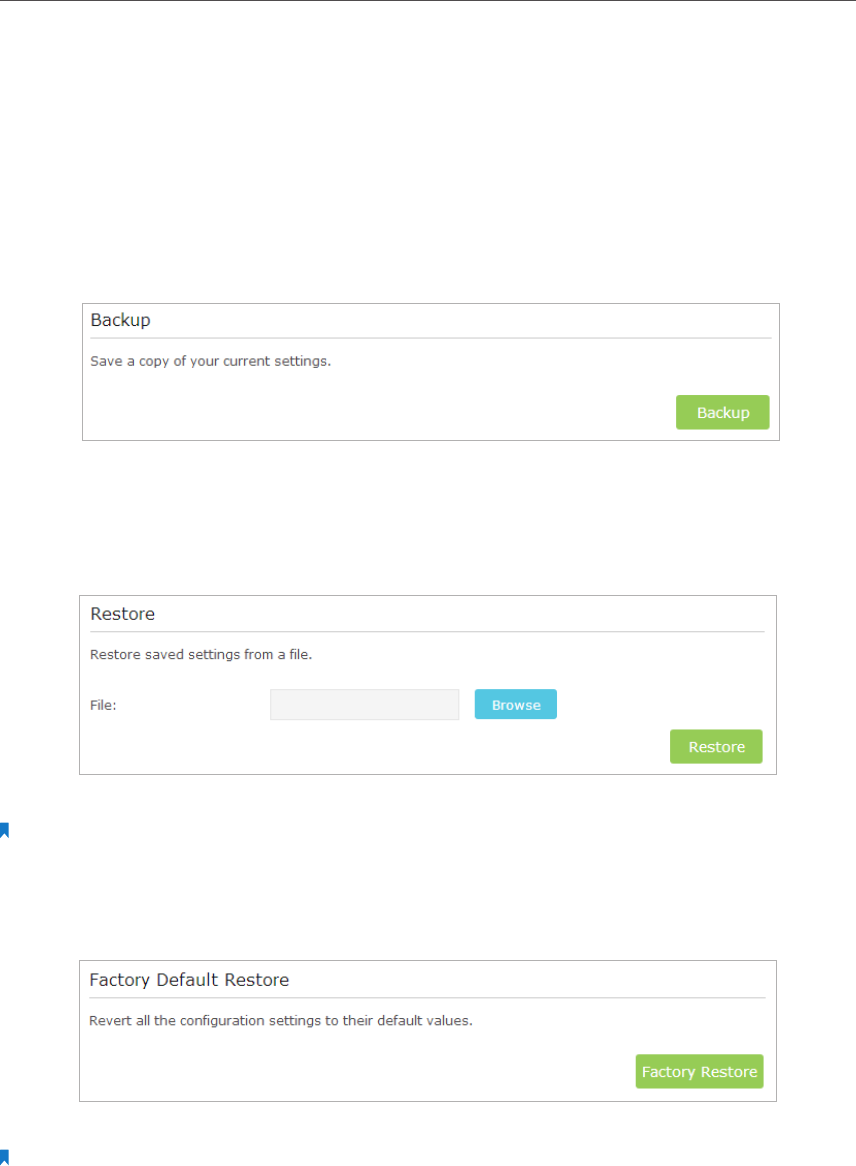
71
Chapter 12 Manage the Router
1. Visit http://tplinkwifi.net, and log in with the username and password you set for the
router.
2. Go to Advanced > System Tools > Backup & Restore.
¾To backup configuration settings:
Click Backup to save a copy of the current settings to your local computer. A ‘.bin’ file of
the current settings will be stored to your computer.
¾To restore configuration settings:
1. Click Browse to locate the backup configuration file stored on your computer, and
click Restore.
2. Wait a few moments for the restoring and rebooting.
Note: During the restoring process, do not turn off or reset the router.
¾To reset the router to factory default settings:
1. Click Factory Restore to reset the router.
2. Wait a few moments for the resetting and rebooting.
Note:
1. During the resetting process, do not turn off or reset the router.
2. We strongly recommend you backup the current configuration settings before resetting the router.
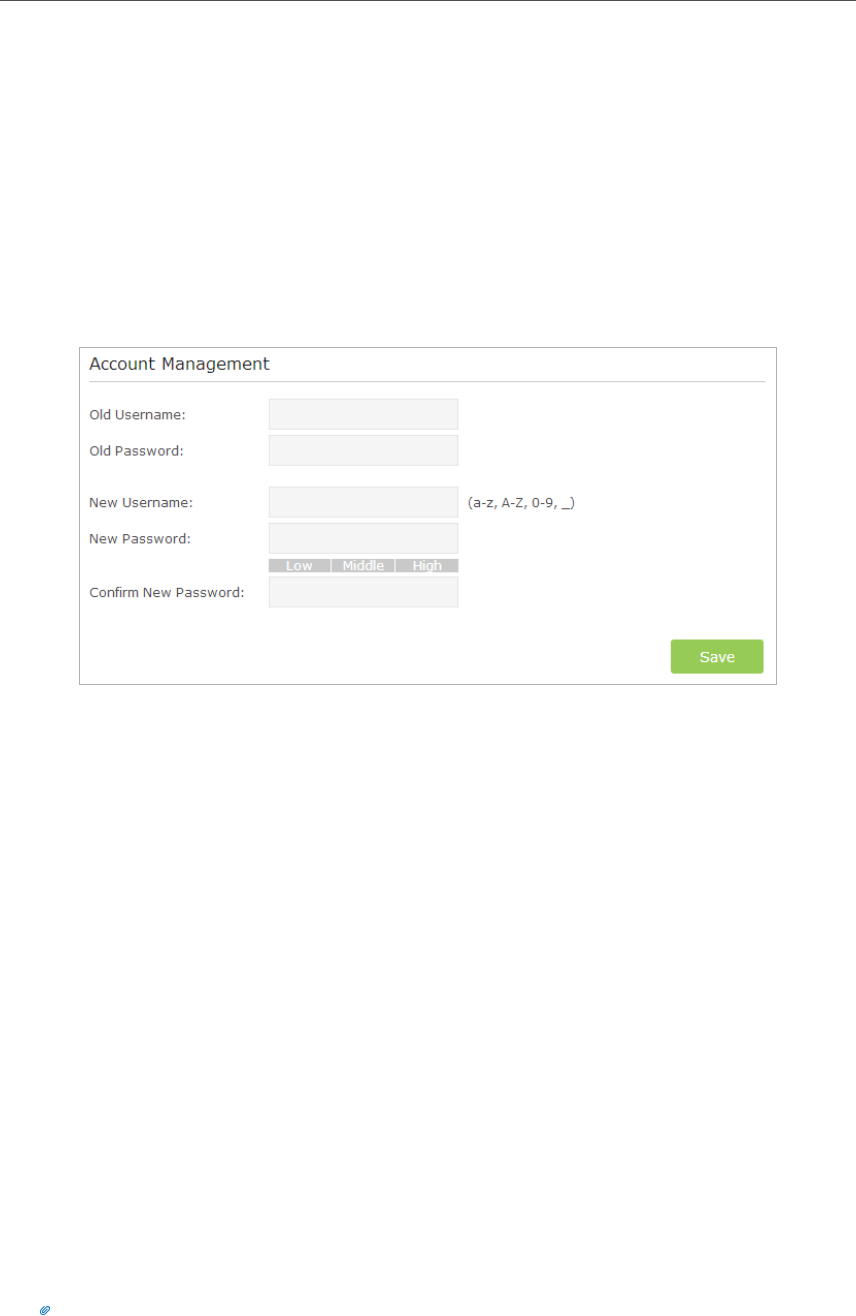
72
Chapter 12 Manage the Router
12. 5. Change the Administrator Account
The account management feature allows you to change your login username and
password of the web management page.
1. Visit http://tplinkwifi.net, and log in with the username and password you set for the
router.
2. Go to Advanced > System Tools > Administration and focus on the Account
Management section.
3. Enter the old username and old password. Enter the new username and enter the
new password twice (both case-sensitive). Click Save.
4. Use the new username and password for the following logins.
12. 6. Password Recovery
This feature allows you to recover your default login username and password in case
you forget them.
1. Visit http://tplinkwifi.net, and log in with the username and password you set for the
router.
2. Go to Advanced > System Tools > Administration and focus on the Password Recovery
section.
3. Select the Enable Password Recovery checkbox.
4. Specify a mailbox (From) for sending the recovery letter and enter its SMTP Server
address. Specify a mailbox (To) for receiving the recovery letter. If the mailbox (From)
to send the recovery letter requires encryption, select Enable Authentication and
enter its username and password.
Tips:
• SMTP server is available for users in most webmail systems. For example, the SMTP server address of Gmail
is smtp.gmail.com. You can refer to their Help page to learn the SMTP server address.
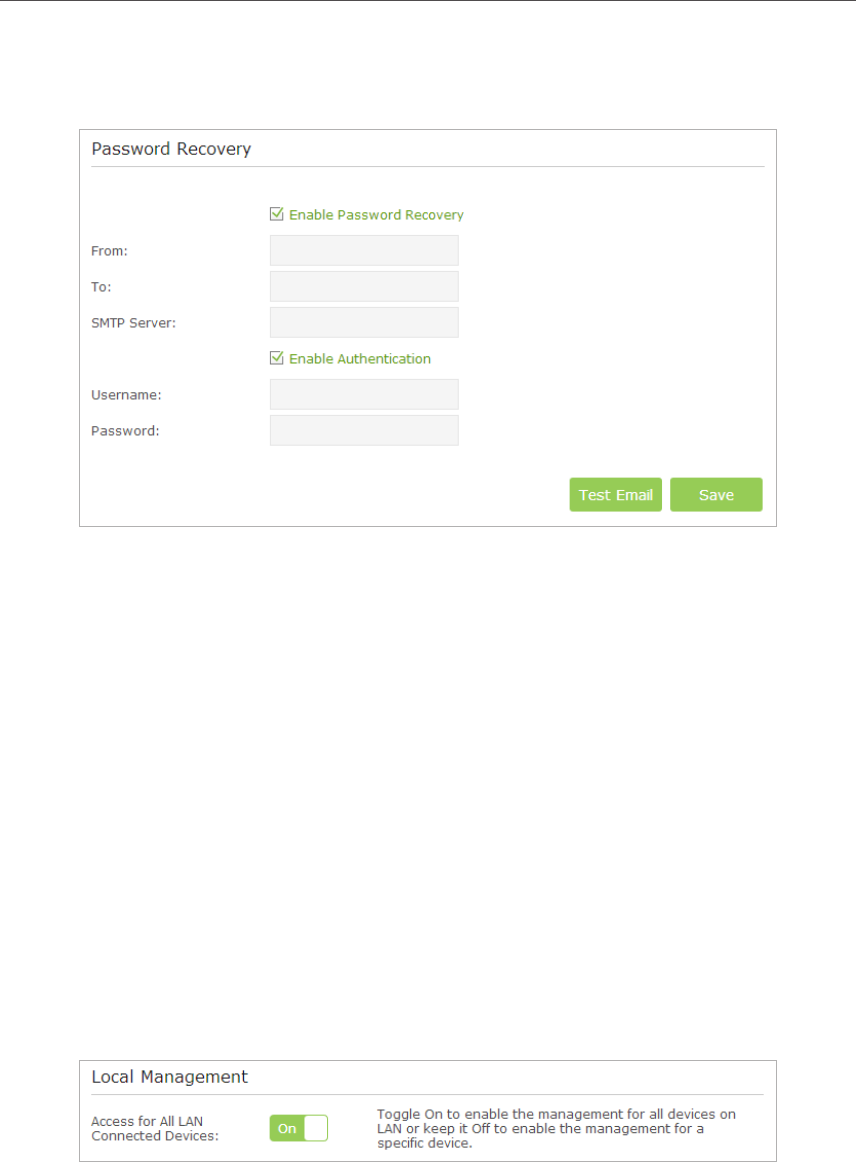
73
Chapter 12 Manage the Router
• Generally, Enable Authentication should be selected if the login of the mailbox requires username and
password.
5. Click Save.
You can click Test Email to test whether the configuration is successful. To recover the
default login username and password, please refer to FAQ.
12. 7. Local Management
This feature allows you to limit the number of client devices on your LAN from accessing
the router by using the MAC address-based authentication.
1. Visit http://tplinkwifi.net, and log in with the username and password you set for the
router.
2. Go to Advanced > System Tools > Administration and complete the settings In Local
Management section according to your needs.
• Allow all LAN connected devices to manage the router:
Toggle on Access for All LAN Connected Devices.
• Allow specific devices to manage the router:
1 ) Toggle off Access for All LAN Connected Devices.
2 ) Click Add.
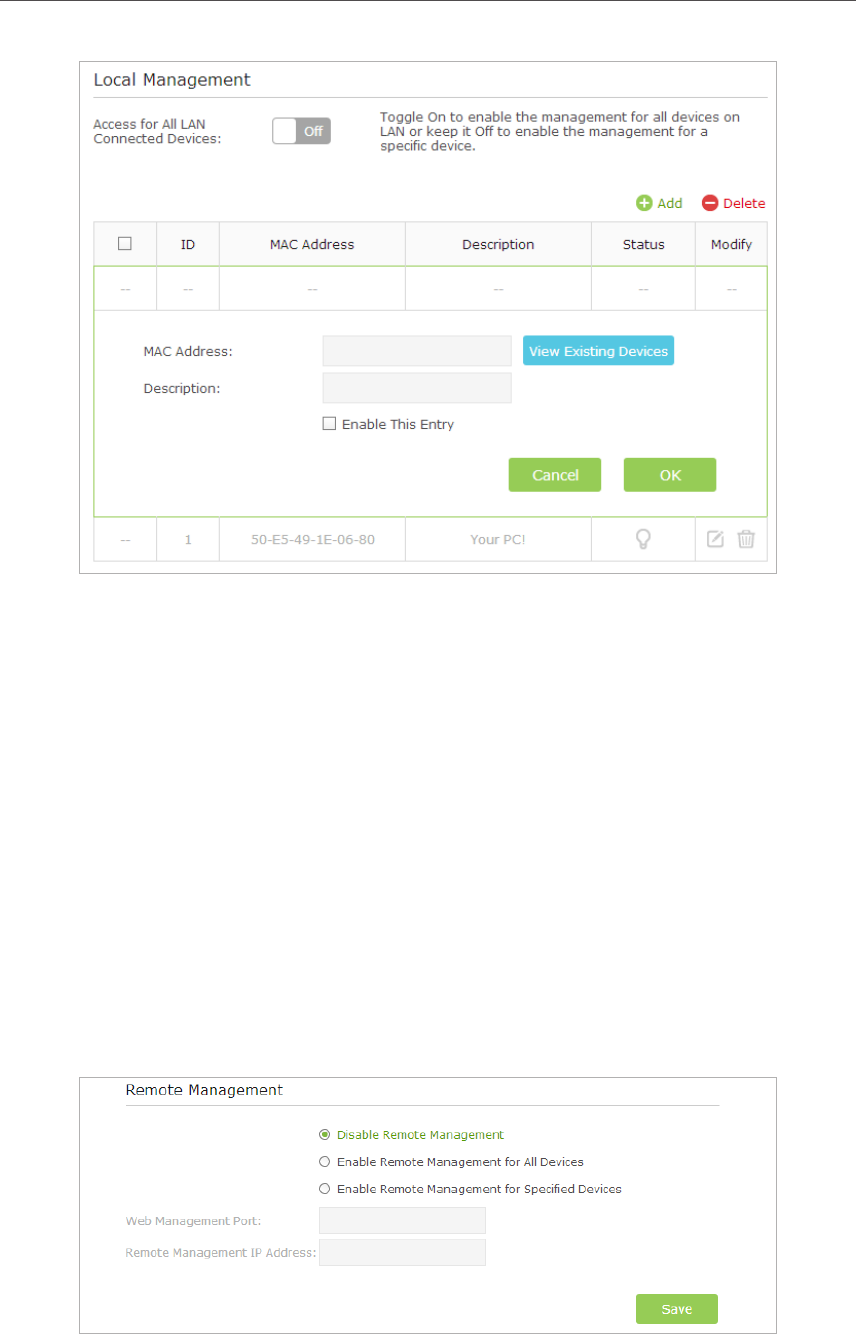
74
Chapter 12 Manage the Router
3 ) Click View Existing Devices and select the device to manage the router from
the Existing Devices list, or enter the MAC address of the device manually.
4 ) Specify a Description for this entry.
5 ) Tick the Enable This Entry checkbox.
6 ) Click OK.
12. 8. Remote Management
This feature allows you to control remote devices’ authority to manage the router.
1. Visit http://tplinkwifi.net, and log in with the username and password you set for the
router.
2. Go to Advanced > System Tools > Administration and complete the settings in
Remote Management section according to your needs.

75
Chapter 12 Manage the Router
• Forbid all devices to manage the router remotely: Select Disable Remote
Management and click Save.
• Allow all devices to manage the router remotely:
1 ) Select Enable Remote Management for All Devices.
2 ) Enter Web Management Port (1024-65535 or 80).
3 ) Click Save.
Devices on the Internet can log in to http://Router’s WAN IP address:port number (such as
http://113.116.60.229:1024) to manage the router.
Tips:
1. You can find the WAN IP address of the router on Basic > Network Maps > Internet.
2. The router’s WAN IP is usually a dynamic IP. Please refer to Set Up a Dynamic DNS Service Account if you want to log
in to the router through a domain name.
• Allow specific devices to manage the router remotely:
1 ) Select Enable Remote Management for Specified Devices.
2 ) Enter Web Management Port (1024-65535 or 80).
3 ) In Remote Management IP address, enter the IP address of the remote device
to manage the router.
4 ) Click Save.
Devices using this WAN IP can manage the router by logging in to http://Router’s WAN
IP:port number (such as http://113.116.60.229:1024).
Tips:
The router’s WAN IP is usually a dynamic IP. Please refer to Set Up a Dynamic DNS Service Account if you want to log
in to the router through a domain name.
12. 9. System Log
When the router does not work properly, you can save the system log and send it to the
technical support for troubleshooting.
¾To Save the System Log in Local:
1. Visit http://tplinkwifi.net, and log in with the username and password you set for the
router.
2. Go to Advanced > System Tools > System Log.
3. Choose the type and level of the system logs according to your need.
4. Click Save Log to save the system logs to local.
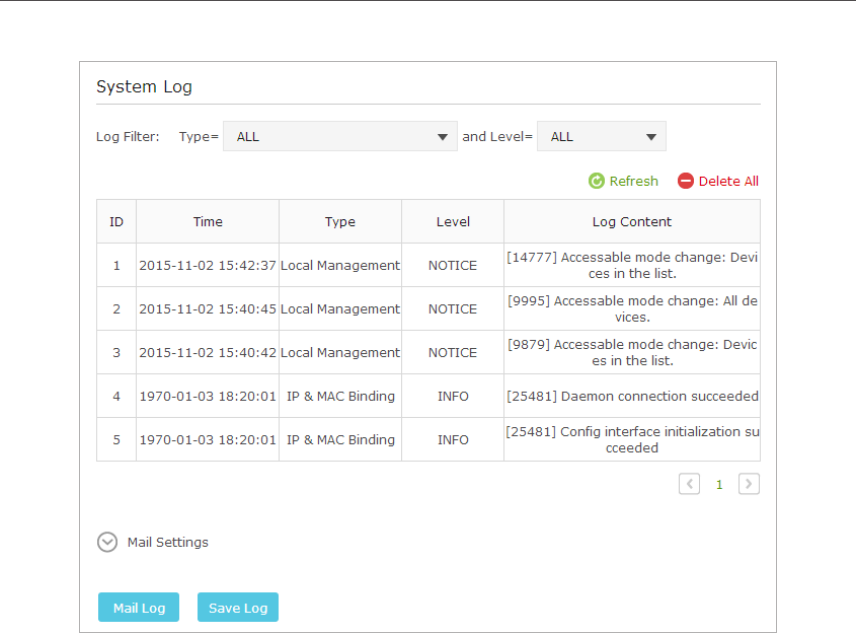
76
Chapter 12 Manage the Router
¾To Send the System Log to a Mailbox at a Fixed Time:
For example, I want to check my router’s working status at a fixed time every day,
however, it’s too troublesome to log in to the web interface every time I want to go
checking. It would be great if the system logs could be sent to my mailbox at 8 a.m.
every day.
1. Visit http://tplinkwifi.net, and log in with the username and password you set for the
router.
2. Go to Advanced > System Tools > System Log.
3. Click Mail Settings.
4. Enter the information with the help of page tips:
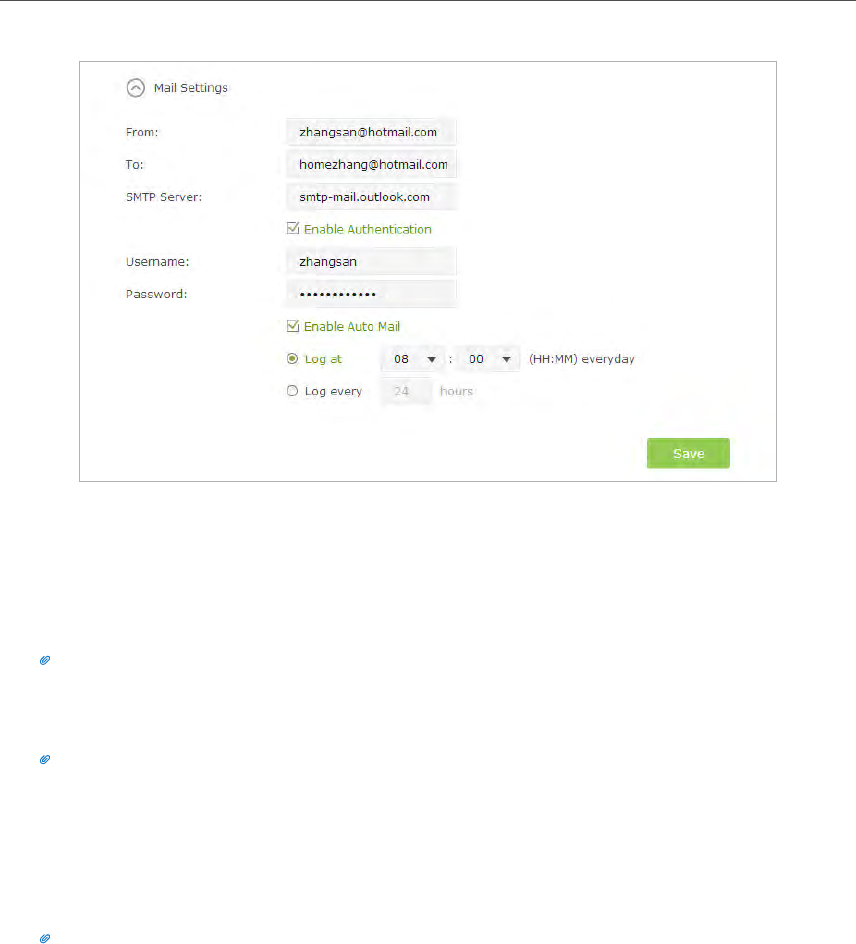
77
Chapter 12 Manage the Router
1 ) From: Enter the email address used for sending the system log.
2 ) To: Enter the recipient’s email address, which can be the same as or different
from the sender’s email address.
3 ) SMTP Server: Enter the SMTP server address.
Tips: SMTP server is available for users in most webmail systems. For example, the SMTP server address of
Hotmail is smtp-mail.outlook.com. You can refer to their Help page to learn the SMTP server address.
4 ) Select Enable Authentication.
Tips: Generally, Enable Authentication should be selected if the login of the mailbox requires username and
password.
5 ) Username: Enter the email address used for sending the system log.
6 ) Password: Enter the password to login the sender’s email address.
7 ) Select Enable Auto Mail.
Tips: The router will send the system log to the designated email address if this option is enabled.
8 ) Set a fixed time. The recipient will receive the system log sent at this time every
day.
5. Click Save.
12. 10. Monitor the Internet Traffic Statistics
The Traffic Statistics page displays the network traffic of the LAN, WAN and WLAN sent
and received packets, allows you to monitor the volume of Internet traffic statistics.
1. Visit http://tplinkwifi.net, and log in with the username and password you set for the
router.
2. Go to Advanced > System Tools > Traffic Statistics.
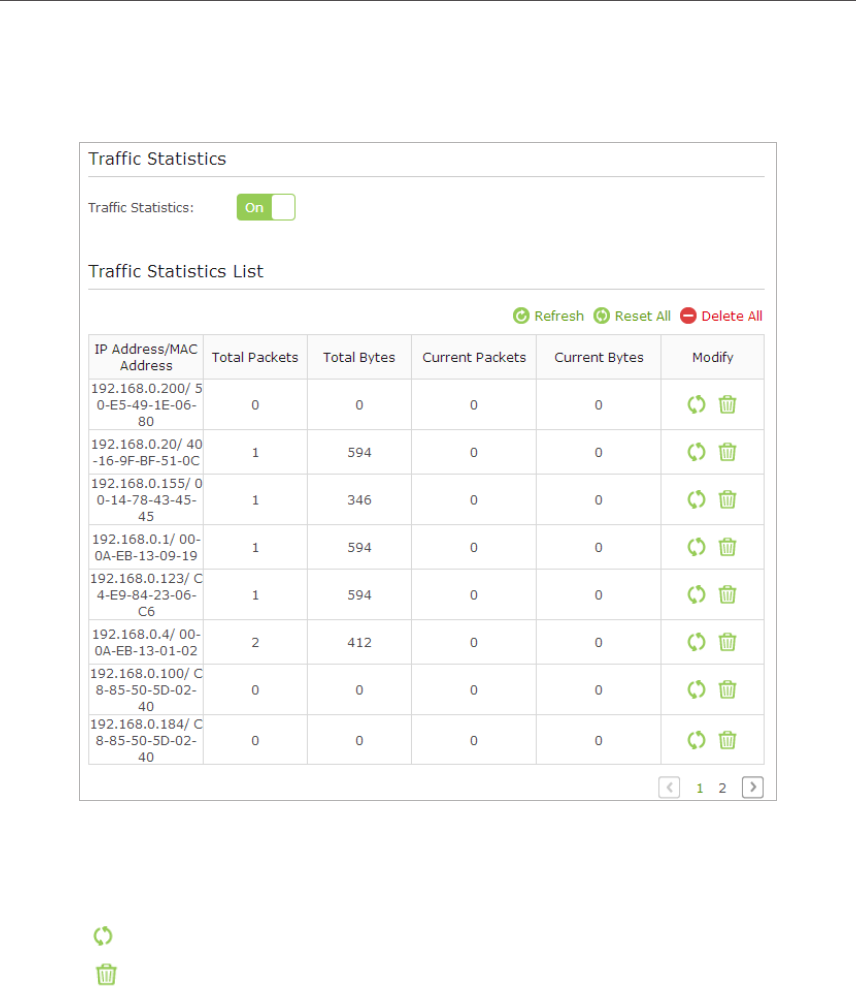
78
Chapter 12 Manage the Router
3. Toggle on Traffic Statistics, and then you can monitor the traffic statistics in Traffic
Statistics List section.
Click Refresh to update the statistic information on the page.
Click Reset All to reset all statistic values in the list to zero.
Click Delete All to delete all statistic information in the list.
Click to reset the statistic information of the specific device.
Click to delete the specific device item in the list.
12. 11. Control LEDs
The router LEDs indicate router activities and behavior. You can turn on or turn off the
LEDs from the web management page.
¾To turn on or off the LEDs:
• Press the LED button on the router (if available) about 2 seconds to turn on or
off the LEDs.
• Visit http://tplinkwifi.net, and log in with the username and password you set
for the router. Click the LED icon on the top right of the page.
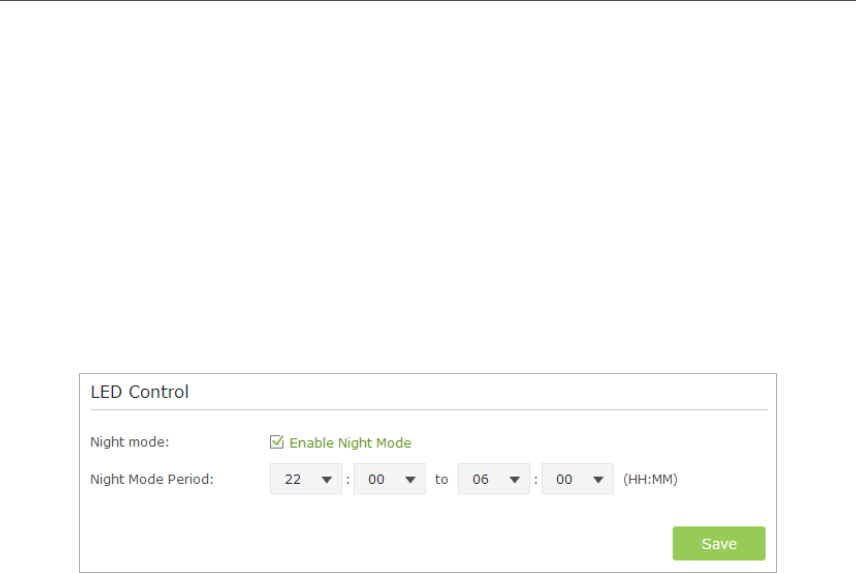
79
Chapter 12 Manage the Router
¾To turn off LEDs during Night Mode Period:
1 ) Visit http://tplinkwifi.net, and log in with the username and password you set
for the router.
2 ) Go to Advanced > System Tools > System Parameters.
3 ) In the LED Control section, select the Enable Night Mode checkbox.
4 ) Specify a time period in the Night Mode Period according to your need, and the
LEDs will be off during this period.
5 ) Click Save to make the settings effective.

80
FAQ
Q1. What can I do if I forgot my wireless password?
The default wireless password is printed on the label of the router. If the password has
been altered, please connect your computer to the router using a cable and follow the
steps below:
1. Visit http://tplinkwifi.net.
2. Go to Advanced > Wireless > Wireless Settings to retrieve or reset your wireless
password.
Q2. What can I do if I forgot my login password of the web management
page?
The default username and password of the web management page are admin (in
lowercase). If your router supports Password Recovery and you have enabled it,
please follow the steps below to reset the password without resetting the router:
Note: Make sure the Internet access is available before using this method.
1. Visit http://tplinkwifi.net.
2. Click Forgot password > Send Code, the verification code will be sent to the mailbox
you set.
3. Log into your mailbox to copy the verification code.
4. Paste the verification code on the window which pops up in Step 2.
5. Click Confirm (the default login username and password will be reset as admin after
the click).
6. Use admin (in lowercase) as both username and password to login.
Tips: Please refer to Password Recovery to learn how to configure Password Recovery.
If you have altered the username and password but Password Recovery is disabled:
1. Reset the router to factory default settings: press and hold the Reset button for about
7 seconds and then release;
2. Visit http://tplinkwifi.net, enter admin (in lowercase) as both username and password
to login.
Note: You’ll need to reconfigure the router to surf the Internet once the router is reset, and please mark down your
new password for future use.
Q3. I cannot log into the router’s web management page, what can I do?
This can happen for a variety of reasons. Please try the methods below to login again.
• Make sure the router connect to the computer correctly and the corresponding LED
indicator(s) light up.
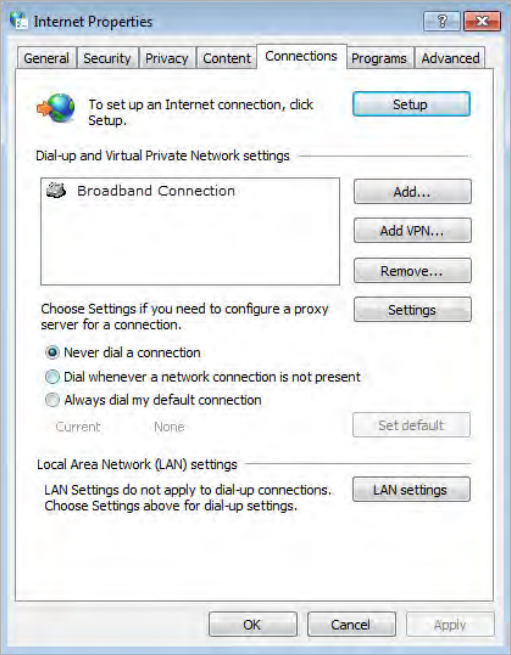
81
• Make sure the IP address of your computer is configured as Obtain an IP address
automatically and Obtain DNS server address automatically.
• Make sure you enter the correct IP address to login: http://tplinkwifi.net.
• Check your computer’s settings:
1 ) Go to Start > Control Panel > Network and Internet, and click View network status
and tasks.
2 ) Click Internet Options on the bottom left.
3 ) Click Connections and select Never dial a connection.
4 ) Click LAN settings and deselect the following three options and click OK.
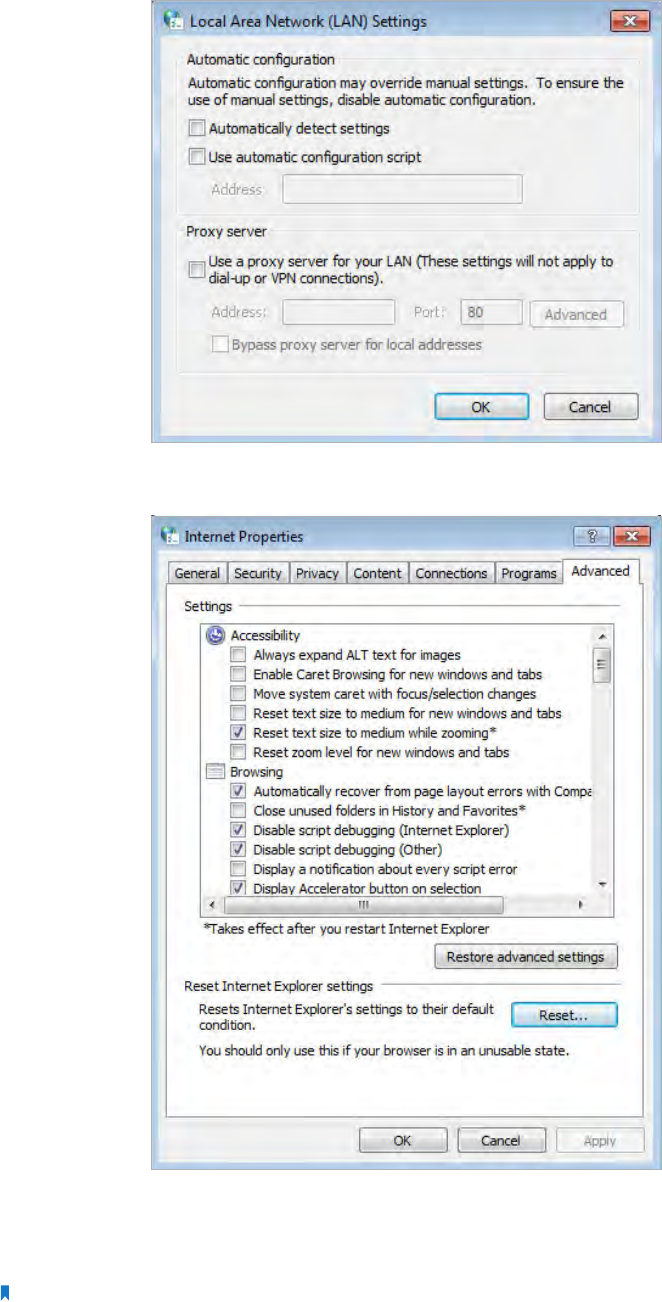
82
5 ) Go to Advanced > Restore advanced settings, click OK to save the settings.
• Use another web browser or computer to login again.
• Reset the router to factory default settings and try again. If login still fails, please
contact the technical support.
Note: You’ll need to reconfigure the router to surf the Internet once the router is reset.
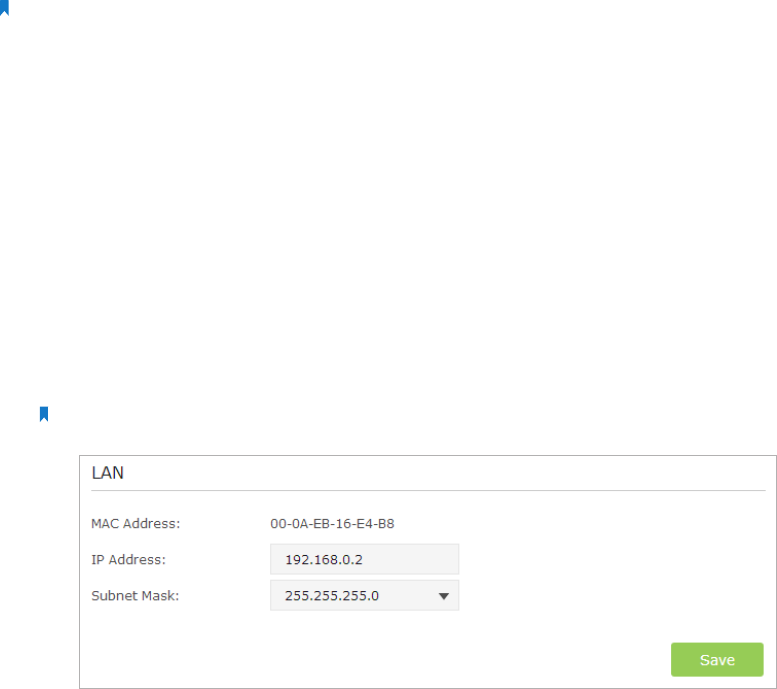
83
Q4. How to use the WDS Bridging function to extend my wireless
network?
For example, my house covers a large area. The wireless coverage of the router I’m using
(the root router) is limited. I want to use an extended router to extend the wireless
network of the root router.
Note:
• WDS bridging only requires configuration on the extended router.
• WDS bridging function can be enabled either in 2.4GHz frequency or 5GHz frequency for a dual-band router. We
use the WDS bridging function in 2.4GHz frequency as example.
1. Visit http://tplinkwifi.net, and log into with the username and password you set for
the router.
2. Configure the IP address of the router:
1 ) Go to Advanced > Network > LAN, configure the IP address of the extended
router to be in the same subnet with the root router; (For example, the IP
address of the root router is 192.168.0.1, the IP address of the extended router
can be 192.168.0.2~192.168.0.254. We take 192.168.0.2 as example.)
2 ) Click Save.
Note: Log into the web management page again if the IP address of the router is altered.
3. Survey the SSID to be bridged:
1 ) Go to Advanced > System Tools > System Parameters and focus on the 2.4GHz
WDS section, click Enable WDS Bridging.
2 ) Click Survey, locate the root router’s SSID and click Choose (Here we take
TP-LINK_2512 as example).
3 ) If the root router has wireless password, you should enter the wireless password
of the root router.
4 ) Click Save.

84
4. Disable DHCP:
1 ) Go to Network > DHCP Server.
2 ) Deselect Enable DHCP Server and click Save.
Now you can go to Advanced > Status > Wireless to check the WDS status. When the
WDS status is Run, it means WDS bridging is successfully built.
Q5. I cannot access the Internet even though the configuration is
finished, what can I do?
1. Visit http://tplinkwifi.net.
2. Go to Advanced > Status to check Internet status:
As the follow picture shows, if IP Address is a valid one, please try the methods
below and try again:
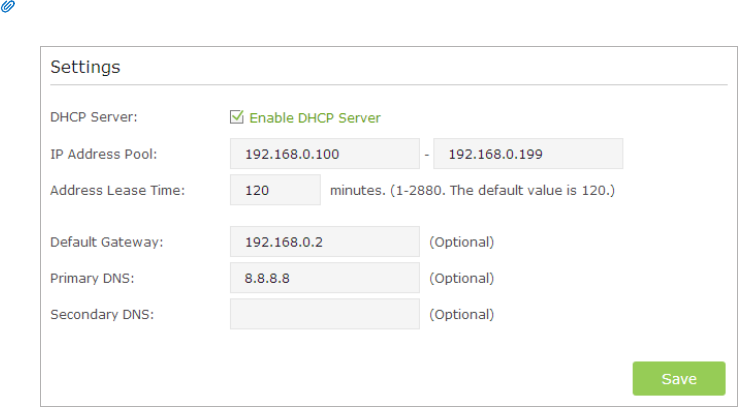
85
• Your computer might not recognize any DNS server addresses, please manually
configure DNS server.
1 ) Go to Advanced > Network > DHCP Server.
2 ) Enter 8.8.8.8 as Primary DNS, click Save.
Tips: 8.8.8.8 is a safe and public DNS server operated by Google.
• Power cycle the modem and the TP-LINK router.
1 ) Power off your modem and TP-LINK router, leave them off for 1 minute.
2 ) Power on your modem first, wait about 2 minutes until it gets a solid cable or
Internet light.
3 ) Power back TP-LINK router.
4 ) Wait another 1 or 2 minutes and check the Internet access.
• Reset the router to factory default settings and reconfigure the router.
• Upgrade the firmware of the router.
• Check the TCP/IP settings on the particular device if all other devices can get Internet
from the router.
As the picture below shows, if the IP Address is 0.0.0.0, please try the methods below
and try again:
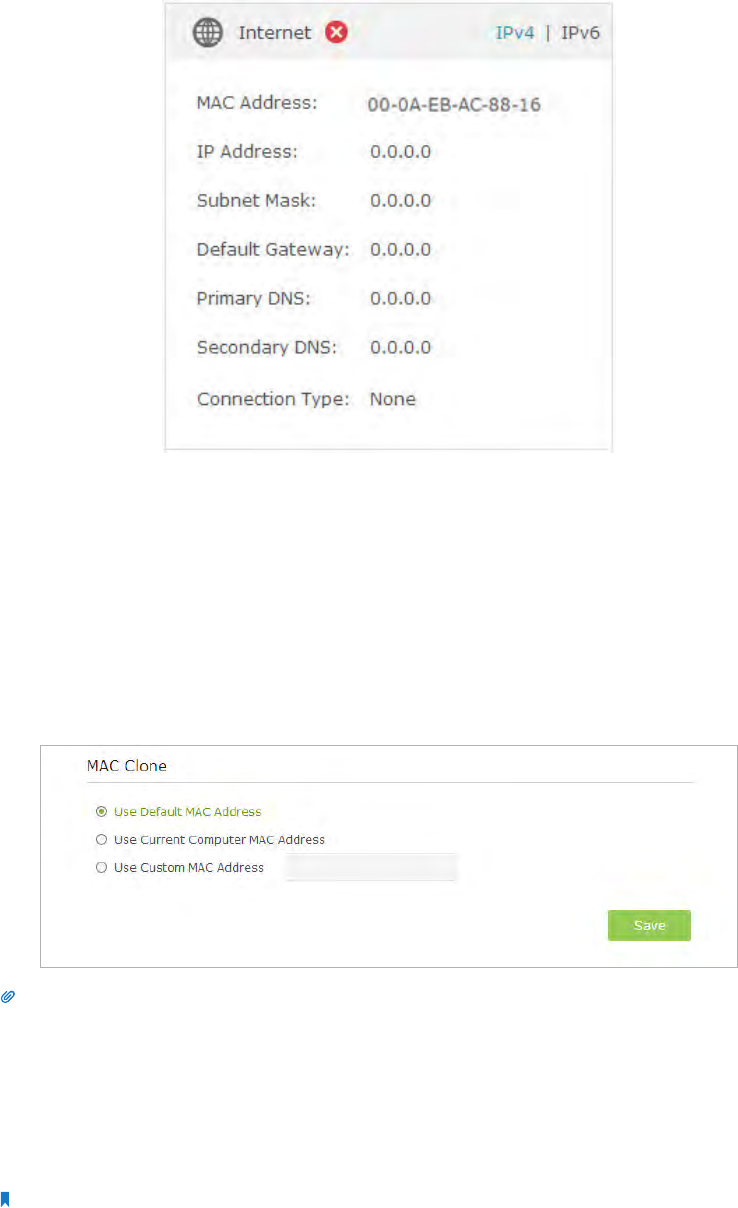
86
• Make sure the physical connection between the router and the modem is proper
• Clone the MAC address of your computer.
1 ) Visit http://tplinkwifi.net, and log in with the username and password you set
for the router.
2 ) Go to Advanced > Network > Internet and focus on the MAC Clone section.
3 ) Choose an option to your need (Enter the MAC address if Use Custom MAC
Address is selected), and click Save.
Tips:
• Some ISP will register the MAC address of your computer when you access the Internet for the first time
through their Cable modem, if you add a router into your network to share your Internet connection, the
ISP will not accept it as the MAC address is changed, so we need to clone your computer’s MAC address to
the router.
• The MAC addresses of a computer in wired connection and wireless connection are different.
• Modify the LAN IP address of the router.
Note:
Most TP-LINK routers use 192.168.0.1/192.168.1.1 as their default LAN IP address, it may conflict with the IP
range of your existent ADSL modem/router. If so, the router is not able to communicate with your modem
and cause you can’t access the Internet. To resolve this problem, we need to change the LAN IP address of the
router to avoid such conflict, for example, 192.168.2.1.
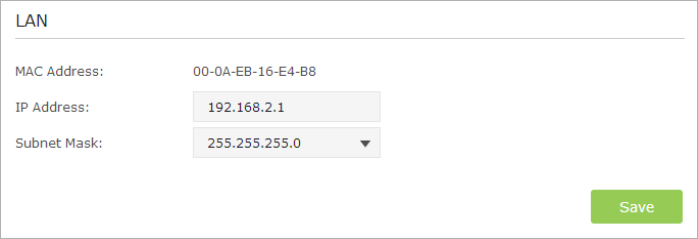
87
1 ) Visit http://tplinkwifi.net, and log in with the username and password you set
for the router.
2 ) Go to Advanced > Network > LAN.
3 ) Modify the LAN IP address as the follow picture shows. Here we take 192.168.2.1
as an example.
4 ) Click Save.
• Power cycle the modem and the TP-LINK router.
1 ) Power off your modem and TP-LINK router, leave them off for 1 minute.
2 ) Power on your modem first, wait about 2 minutes until it get a solid cable or
Internet light.
3 ) Power back TP-LINK router.
4 ) Wait another 1 or 2 minutes and check the Internet access.
• Double check the Internet Connection Type.
1 ) Confirm your Internet Connection Type, which can be learned from the ISP.
2 ) Visit http://tplinkwifi.net, and log in with the username and password you set
for the router.
3 ) Go to Advanced > Network > Internet.
4 ) Select your Internet Connection Type and fill in other parameters with the help
of page tips.
5 ) Click Save.
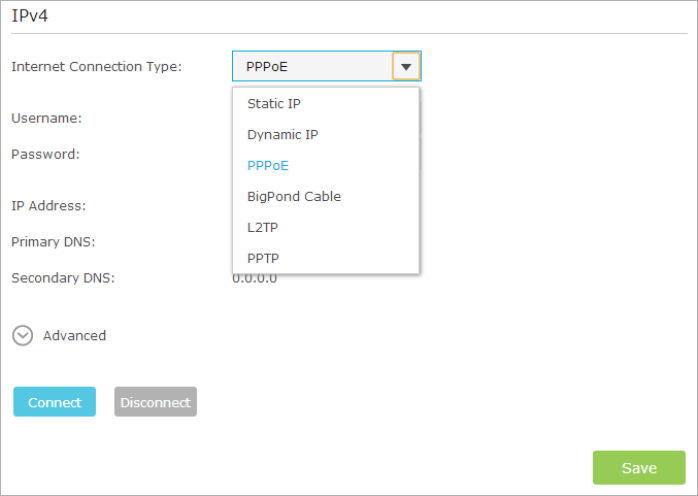
88
6 ) Power cycle the modem and the TP-LINK router again.
• Please upgrade the firmware of the router.
If you’ve tried every method above but cannot access the Internet, please contact the
technical support.
Q6. I cannot find my wireless network or I cannot connect the wireless
network, what can I do?
If you fail to find any wireless network, please follow the steps below:
• Make sure the wireless function of your device is enabled if you’re using a laptop
with built-in wireless adapter. You can refer to the relevant document or contact the
laptop manufacturer.
• Make sure the wireless adapter driver is installed successfully and the wireless adapter
is enabled.
• On Windows 7
1 ) If you see the message No connections are available, it is usually because the
wireless function is disabled or blocked somehow.
2 ) Clicking on Troubleshoot and windows might be able to fix the problem by
itself.
• On Windows XP
1 ) If you see the message Windows cannot configure this wireless connection, this
is usually because windows configuration utility is disabled or you are running
another wireless configuration tool to connect the wireless.
2 ) Exit the wireless configuration tool (the TP-LINK Utility, for example).
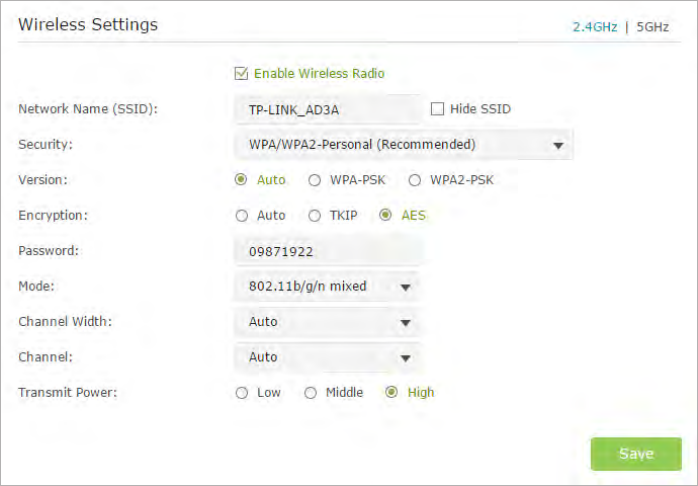
89
3 ) Select and right click on My Computer on desktop, select Manage to open
Computer Management window.
4 ) Expand Services and Applications > Services, find and locate Wireless Zero
Configuration in the Services list on the right side.
5 ) Right click Wireless Zero Configuration, and then select Properties.
6 ) Change Startup type to Automatic, click on Start button and make sure the
Service status is Started. And then click OK.
If you can find other wireless network except your own, please follow the steps
below:
• Check the WLAN LED indicator on your wireless router/modem.
• Make sure your computer/device is still in the range of your router/modem, move
closer if it is currently too far away.
• Go to Advanced > Wireless > Wireless Settings, and check the wireless settings, double
check your Wireless Network Name and SSID is not hided.
If you can find your wireless network but fail to connect, please follow the steps
below:
• Authenticating problem/password mismatch:
1 ) Sometimes you will be asked to type in a PIN number when you connect to
the wireless network for the first time. This PIN number is different from the
Wireless Password/Network Security Key, usually you can only find it on the
label of your router.
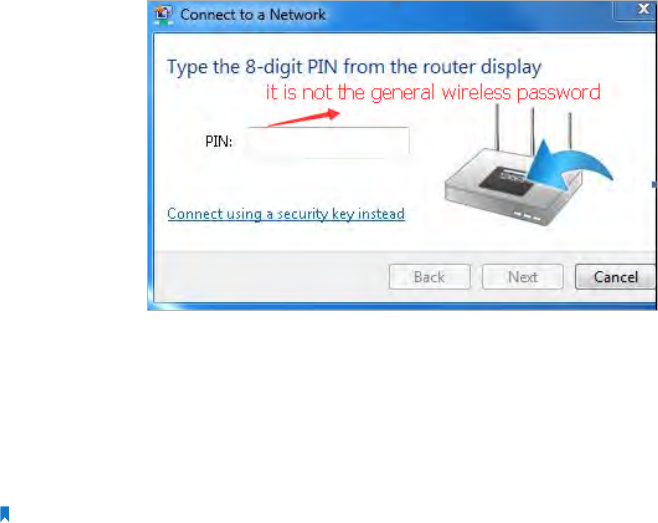
90
2 ) If you cannot find the PIN or PIN failed, you may choose Connecting using a
security key instead, and then type in the Wireless Password/Network Security
Key.
3 ) If it continues to show note of Network Security Key Mismatch, it is suggested
to confirm the wireless password of your wireless router.
Note: Wireless Password/Network Security Key is case sensitive.
• Windows unable to connect to XXXX / Can not join this network / Taking longer
than usual to connect to this network:
• Check the wireless signal strength of your network, if it is weak (1~3 bars),
please move the router closer and try again.
• Change the wireless Channel of the router to 1,6,or 11 to reduce interference
from other networks.
• Re-install or update the driver for your wireless adapter of the computer.

91
COPYRIGHT & TRADEMARKS
Specifications are subject to change without notice. is a registered trademark
of TP-LINK TECHNOLOGIES CO., LTD. Other brands and product names are trademarks
or registered trademarks of their respective holders.
No part of the specifications may be reproduced in any form or by any means or
used to make any derivative such as translation, transformation, or adaptation
without permission from TP-LINK TECHNOLOGIES CO., LTD. Copyright © 2016 TP-LINK
TECHNOLOGIES CO., LTD. All rights reserved.

92
FCC STATEMENT
This equipment has been tested and found to comply with the limits for a Class B
digital device, pursuant to part 15 of the FCC Rules. These limits are designed to provide
reasonable protection against harmful interference in a residential installation. This
equipment generates, uses and can radiate radio frequency energy and, if not installed
and used in accordance with the instructions, may cause harmful interference to radio
communications. However, there is no guarantee that interference will not occur in a
particular installation. If this equipment does cause harmful interference to radio or
television reception, which can be determined by turning the equipment off and on,
the user is encouraged to try to correct the interference by one or more of the following
measures:
• Reorient or relocate the receiving antenna.
• Increase the separation between the equipment and receiver.
• Connect the equipment into an outlet on a circuit different from that to which the
receiver is connected.
• Consult the dealer or an experienced radio/ TV technician for help.
This device complies with part 15 of the FCC Rules. Operation is subject to the following
two conditions:
1. This device may not cause harmful interference.
2. This device must accept any interference received, including interference that may
cause undesired operation.
Any changes or modifications not expressly approved by the party responsible for
compliance could void the user’s authority to operate the equipment.
Note: The manufacturer is not responsible for any radio or TV interference caused by
unauthorized modifications to this equipment. Such modifications could void the
user’s authority to operate the equipment.
FCC RF Radiation Exposure Statement
This equipment complies with FCC RF radiation exposure limits set forth for an
uncontrolled environment. This device and its antenna must not be co-located or
operating in conjunction with any other antenna or transmitter.
“To comply with FCC RF exposure compliance requirements, this grant is applicable to
only Mobile Configurations. The antennas used for this transmitter must be installed to
provide a separation distance of at least 20 cm from all persons and must not be co—
located or operating in conjunction with any other antenna or transmitter.”
The device is restricted in indoor environment only.
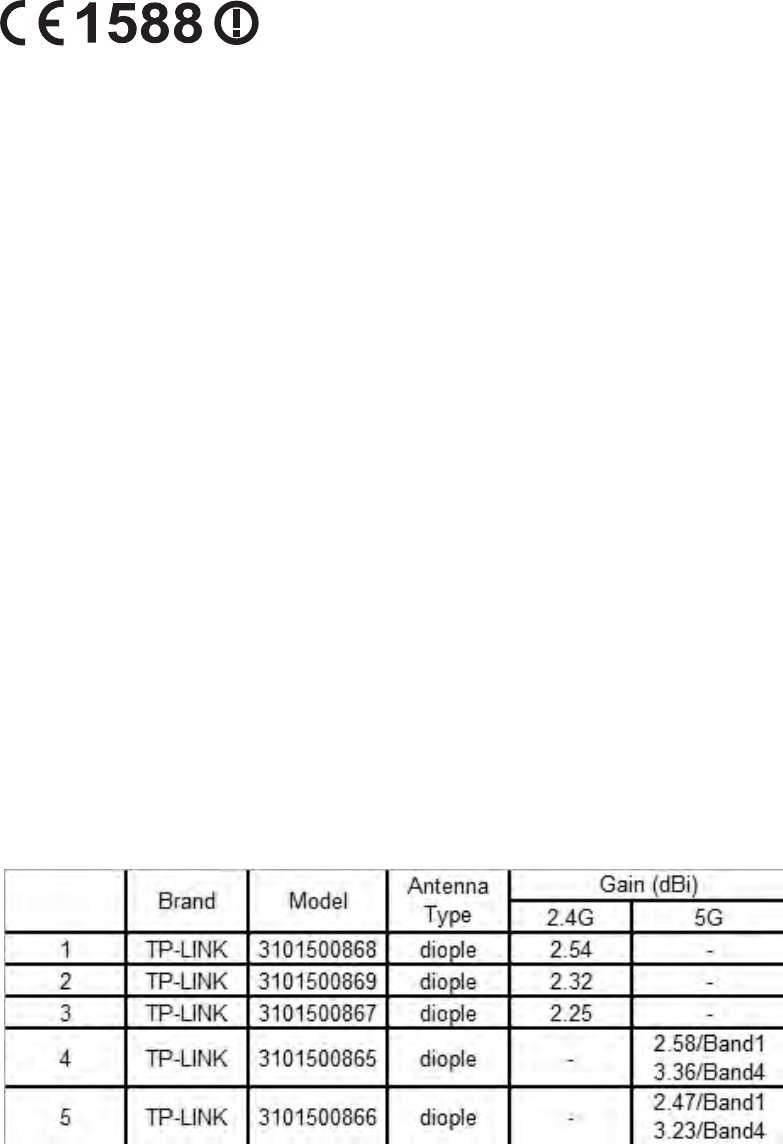
93
For product available in the USA/Canada market, only channel 1~11 can be operated.
Selection of other channels is not possible.
CE Mark Warning
This is a class B product. In a domestic environment, this product may cause radio
interference, in which case the user may be required to take adequate measures.
RF Exposure Information
This device meets the EU requirements (1999/519/EC) on the limitation of exposure of
the general public to electromagnetic fields by way of health protection.
The device complies with RF specifications when the device used at 20 cm from your
body.
Restricted to indoor use.
Canadian Compliance Statement
This device complies with Industry Canada license-exempt RSS standard(s). Operation
is subject to the following two conditions:
1. This device may not cause interference, and
2. This device must accept any interference, including interference that may cause
undesired operation of the device.
Cet appareil est conforme aux norms CNR exemptes de licence d’Industrie Canada. Le
fonctionnement est soumis aux deux conditions suivantes:
1. cet appareil ne doit pas provoquer d’interférences et
2. cet appareil doit accepter toute interférence, y compris celles susceptibles de
provoquer un fonctionnement non souhaité de l’appareil.
This radio transmitter 8853A-C60 has been approved by Industry Canada to operate with the antenna
types listed below with the maximum permissible gain indicated. Antenna types not included in
this list, having a gain greater than the maximum gain indicated for that type, are strictly
Le présent émetteur radio 8853A-C60 a été approuvé par Industrie Canada pour fonctionner avec
les types d’antenne énumérés ci-dessous et ayant un gain admissible maximal et l’impédance
requise pour chaque type d’antenne. Les types d’antenne non inclus dans cette liste, ou dont
le gain est supérieur au gain maximal indiqué, sont strictement interdits pour l’exploitation
de l’émetteur.
94
Déclaration d’exposition aux radiations:
Cet équipement est conforme aux limites d’exposition aux rayonnements IC établies
pour un environnement non contrôlé. Cet équipement doit être installé et utilisé avec
un minimum de 20 cm de distance entre la source de rayonnement et votre corps.
Industry Canada Statement
CAN ICES-3 (B)/NMB-3(B)
Korea Warning Statements:
당해 무선설비는 운용중 전파혼신 가능성이 있음.
NCC Notice & BSMI Notice:
注意!
依據 低功率電波輻射性電機管理辦法
第十二條 經型式認證合格之低功率射頻電機,非經許可,公司、商號或使用者均
不得擅自變更頻率、加大功率或變更原設計之特性或功能。
第十四條 低功率射頻電機之使用不得影響飛航安全及干擾合法通行;經發現有干
擾現象時,應立即停用,並改善至無干擾時方得繼續使用。前項合法通信,指依
電信規定作業之無線電信。低功率射頻電機需忍受合法通信或工業、科學以及醫
療用電波輻射性電機設備之干擾。
減少電磁波影響,請妥適使用。
安全諮詢及注意事項
• 請使用原裝電源供應器或只能按照本產品注明的電源類型使用本產品。
• 清潔本產品之前請先拔掉電源線。請勿使用液體、噴霧清潔劑或濕布進行
清潔。
• 注意防潮,請勿將水或其他液體潑灑到本產品上。
• 插槽與開口供通風使用,以確保本產品的操作可靠並防止過熱,請勿堵塞
或覆蓋開口。
Caution:
The device for operation in the band 5150–5250 MHz is only for indoor use to reduce
the potential for harmful interference to co-channel mobile satellite systems;
Avertissement:
Le dispositif fonctionnant dans la bande 5150-5250 MHz est réservé uniquement pour
une utilisation à l’intérieur afin de réduire les risques de brouillage préjudiciable aux
systèmes de satellites mobiles utilisant les mêmes canaux;
Radiation Exposure Statement:
This equipment complies with IC radiation exposure limits set forth for an uncontrolled
environment. This equipment should be installed and operated with minimum distance
20cm between the radiator & your body.

95
Safety Information
• When product has power button, the power button is one of the way to shut off the
product; when there is no power button, the only way to completely shut off power
is to disconnect the product or the power adapter from the power source.
• Don’t disassemble the product, or make repairs yourself. You run the risk of electric
shock and voiding the limited warranty. If you need service, please contact us.
• Avoid water and wet locations.
• Adapter shall be installed near the equipment and shall be easily accessible.
• The plug considered as disconnect device of adapter.
• Use only power supplies which are provided by manufacturer and in the original
packing of this product. If you have any questions, please don’t hesitate to contactus
us.
For EU/EFTA, this product can be used in the following countries:
AT BE BG CH CY CZ DE DK
EE ES FI FR GB GR HR HU
IE IS IT LI LT LU LV MT
NL NO PL PT RO SE SI SK
Explanations of the symbols on the product label
Symbol Explanation
DC voltage
RECYCLING
This product bears the selective sorting symbol for Waste electrical and electronic equipment
(WEEE). This means that this product must be handled pursuant to European directive 2012/19/
EU in order to be recycled or dismantled to minimize its impact on the environment.
User has the choice to give his product to a competent recycling organization or to the retailer
when he buys a new electrical or electronic equipment.
• 請勿將本產品置放於靠近熱源的地方。除非有正常的通風,否則不可放在
密閉位置中。
• 請不要私自打開機殼,不要嘗試自行維修本產品,請由授權的專業人士進
行此項工作。
Продукт сертифіковано згідно с правилами системи УкрСЕПРО на відповідність
вимогам нормативних документів та вимогам, що передбачені чинними
законодавчими актами України.

Archer C60
User Guide
AC1350 Wireless Dual Band Router
REV1.0.0 1910011738
Contents
|
About This Guide…………………………………………………………………………………… |
1 |
Chapter 1. Get to Know About Your Router. . . . . . . . . . . . . . . . . . . . . . . . . . 2
1. 1. Product Overview . . . . . . . . . . . . . . . . . . . . . . . . . . . . . . . . . . . . . . . . . . . . . . . . . . . . . . . . . . 3
1. 2. Panel Layout. . . . . . . . . . . . . . . . . . . . . . . . . . . . . . . . . . . . . . . . . . . . . . . . . . . . . . . . . . . . . . . . 3
1. 2. 1.Top View . . . . . . . . . . . . . . . . . . . . . . . . . . . . . . . . . . . . . . . . . . . . . . . . . . . . . . . . . . . . . 3
1. 2. 2.The Back Panel . . . . . . . . . . . . . . . . . . . . . . . . . . . . . . . . . . . . . . . . . . . . . . . . . . . . . . . 4
Chapter 2. Connect the Hardware . . . . . . . . . . . . . . . . . . . . . . . . . . . . . . . . . . 6
2. 1. Position Your Router . . . . . . . . . . . . . . . . . . . . . . . . . . . . . . . . . . . . . . . . . . . . . . . . . . . . . . . . 7
2. 2. Connect Your Router . . . . . . . . . . . . . . . . . . . . . . . . . . . . . . . . . . . . . . . . . . . . . . . . . . . . . . . . 7
Chapter 3. Log into Your Router . . . . . . . . . . . . . . . . . . . . . . . . . . . . . . . . . . .10 Chapter 4. Set Up Internet Connection. . . . . . . . . . . . . . . . . . . . . . . . . . . . .12
4. 1. Use Quick Setup Wizard . . . . . . . . . . . . . . . . . . . . . . . . . . . . . . . . . . . . . . . . . . . . . . . . . . . .13 4. 2. Manually Set up Your Internet Connection . . . . . . . . . . . . . . . . . . . . . . . . . . . . . . . . .13 4. 3. Set Up an IPv6 Internet Connection . . . . . . . . . . . . . . . . . . . . . . . . . . . . . . . . . . . . . . . .17
Chapter 5. Guest Network. . . . . . . . . . . . . . . . . . . . . . . . . . . . . . . . . . . . . . . . .21
|
5. 1. |
Create a Network for Guests . . . . . . . . . . . . . . . . . . . . . . . . . . . . . . . . . . . . . . . . . . . . . . . |
22 |
|
5. 2. |
Customize Guest Network Options . . . . . . . . . . . . . . . . . . . . . . . . . . . . . . . . . . . . . . . . . |
23 |
Chapter 6. Parental Controls . . . . . . . . . . . . . . . . . . . . . . . . . . . . . . . . . . . . . .24
Chapter 7. QoS . . . . . . . . . . . . . . . . . . . . . . . . . . . . . . . . . . . . . . . . . . . . . . . . . . .28
7. 1. Prioritize Internet Traffic with QoS . . . . . . . . . . . . . . . . . . . . . . . . . . . . . . . . . . . . . . . . . .29
Chapter 8. Network Security . . . . . . . . . . . . . . . . . . . . . . . . . . . . . . . . . . . . . .33
8. 1. Protect the Network from Cyber Attacks . . . . . . . . . . . . . . . . . . . . . . . . . . . . . . . . . . . .34 8. 2. Access Control . . . . . . . . . . . . . . . . . . . . . . . . . . . . . . . . . . . . . . . . . . . . . . . . . . . . . . . . . . . . .35 8. 3. IP & MAC Binding . . . . . . . . . . . . . . . . . . . . . . . . . . . . . . . . . . . . . . . . . . . . . . . . . . . . . . . . . .37
Chapter 9. NAT Forwarding . . . . . . . . . . . . . . . . . . . . . . . . . . . . . . . . . . . . . . .38
9. 1. Share Local Resources on the Internet by Virtual Servers . . . . . . . . . . . . . . . . . . . .39 9. 2. Open Ports Dynamically by Port Triggering . . . . . . . . . . . . . . . . . . . . . . . . . . . . . . . . .40 9. 3. Make Applications Free from Port Restriction by DMZ . . . . . . . . . . . . . . . . . . . . . . .41 9. 4. Make Xbox Online Games Run Smoothly by UPnP . . . . . . . . . . . . . . . . . . . . . . . . . . 42
Chapter 10.VPN Server . . . . . . . . . . . . . . . . . . . . . . . . . . . . . . . . . . . . . . . . . . . .44
10. 1. Use OpenVPN to Access Your Home Network . . . . . . . . . . . . . . . . . . . . . . . . . . . . . . .45 10. 2. Use PPTP VPN to Access Your Home Network . . . . . . . . . . . . . . . . . . . . . . . . . . . . . . .46
Chapter 11.Customize Your Network Settings. . . . . . . . . . . . . . . . . . . . . . .52
11. 1. Change the LAN Settings. . . . . . . . . . . . . . . . . . . . . . . . . . . . . . . . . . . . . . . . . . . . . . . . . . .53 11. 2. Configure to Support IPTV Service. . . . . . . . . . . . . . . . . . . . . . . . . . . . . . . . . . . . . . . . . .53 11. 3. Specify DHCP Server Settings . . . . . . . . . . . . . . . . . . . . . . . . . . . . . . . . . . . . . . . . . . . . . .55 11. 4. Set Up a Dynamic DNS Service Account . . . . . . . . . . . . . . . . . . . . . . . . . . . . . . . . . . . .56 11. 5. Create Static Routes. . . . . . . . . . . . . . . . . . . . . . . . . . . . . . . . . . . . . . . . . . . . . . . . . . . . . . . .57 11. 6. Specify Wireless Settings . . . . . . . . . . . . . . . . . . . . . . . . . . . . . . . . . . . . . . . . . . . . . . . . . . .59 11. 7. Use WPS for Wireless Connection . . . . . . . . . . . . . . . . . . . . . . . . . . . . . . . . . . . . . . . . . . .61
11. 7. 1.Set the Router’s PIN. . . . . . . . . . . . . . . . . . . . . . . . . . . . . . . . . . . . . . . . . . . . . . . . .61 11. 7. 2.Use the WPS Wizard for Wi-Fi Connections. . . . . . . . . . . . . . . . . . . . . . . . . . .61
Chapter 12.Manage the Router . . . . . . . . . . . . . . . . . . . . . . . . . . . . . . . . . . . .62
12. 1. Set Up System Time . . . . . . . . . . . . . . . . . . . . . . . . . . . . . . . . . . . . . . . . . . . . . . . . . . . . . . . .63 12. 2. Test the Network Connectivity . . . . . . . . . . . . . . . . . . . . . . . . . . . . . . . . . . . . . . . . . . . . .64 12. 3. Upgrade the Firmware . . . . . . . . . . . . . . . . . . . . . . . . . . . . . . . . . . . . . . . . . . . . . . . . . . . . .65 12. 3. 1.Online Upgrade . . . . . . . . . . . . . . . . . . . . . . . . . . . . . . . . . . . . . . . . . . . . . . . . . . . .66 12. 3. 2.Local Upgrade. . . . . . . . . . . . . . . . . . . . . . . . . . . . . . . . . . . . . . . . . . . . . . . . . . . . . .66 12. 3. 3.Restore Interrupted Upgrade after Power Failure . . . . . . . . . . . . . . . . . . . .67
12. 4. Backup and Restore Configuration Settings . . . . . . . . . . . . . . . . . . . . . . . . . . . . . . . . .67 12. 5. Change the Administrator Account . . . . . . . . . . . . . . . . . . . . . . . . . . . . . . . . . . . . . . . . .69 12. 6. Password Recovery . . . . . . . . . . . . . . . . . . . . . . . . . . . . . . . . . . . . . . . . . . . . . . . . . . . . . . . .69 12. 7. Local Management . . . . . . . . . . . . . . . . . . . . . . . . . . . . . . . . . . . . . . . . . . . . . . . . . . . . . . . .70 12. 8. Remote Management. . . . . . . . . . . . . . . . . . . . . . . . . . . . . . . . . . . . . . . . . . . . . . . . . . . . . .71 12. 9. System Log . . . . . . . . . . . . . . . . . . . . . . . . . . . . . . . . . . . . . . . . . . . . . . . . . . . . . . . . . . . . . . . .72 12. 10. Monitor the Internet Traffic Statistics . . . . . . . . . . . . . . . . . . . . . . . . . . . . . . . . . . . . . . .74 12. 11. Control LEDs. . . . . . . . . . . . . . . . . . . . . . . . . . . . . . . . . . . . . . . . . . . . . . . . . . . . . . . . . . . . . . .75
|
FAQ |
……………………………………………………………………………………………………….77 |

About This Guide
This guide is a complementation of Quick Installation Guide. The Quick Installation Guide instructs you on quick Internet setup, and this guide provides details of each function and shows you the way to configure these functions appropriate to your needs.
When using this guide, please notice that features of the router may vary slightly depending on the model and software version you have, and on your location, language, and Internet service provider. All screenshots, images, parameters and descriptions documented in this guide are used for demonstration only.
Conventions
In this guide the following conventions are used:
|
Convention |
Description |
|
|
Blue Italic |
Hyperlinks are in blue italic. You can click to redirect to a website or a specific section. |
|
|
Blue |
Contents to be emphasized and texts on the web page are in blue, including the |
|
|
menus, items, buttons, etc. |
||
The menu structures to show the path to load the corresponding page. For example,
>Advanced > Wireless > MAC Filtering means the MAC Filtering function page is under the Wireless menu that is located in the Advanced tab.
|
Note: |
Ignoring this type of note might result in a malfunction or damage to the device. |
|||
|
Tips: |
Indicates important information that helps you make better use of your device. |
|||
|
• |
click to edit the corresponding entry. |
|
|
symbols on the web |
• |
click to delete the corresponding entry. |
|
page |
• click to enable or disable the corresponding entry. |
|
|
• |
click to view more information about items on the page. |
More Info
•The latest software, management app and utility can be found at Download Center at http://www.tp-link.com/support.
•The Quick Installation Guide (QIG) can be found where you find this guide or inside the package of the router.
•Specifications can be found on the product page at http://www.tp-link.com.
•A Technical Support Forum is provided for you to discuss our products at http://forum.tp-link.com.
•Our Technical Support contact information can be found at the Contact Technical Support page at http://www.tp-link.com/support.
1

Chapter 1
Get to Know About Your Router
This chapter introduces what the router can do and shows its appearance. This chapter contains the following sections:
•Product Overview
•Panel Layout
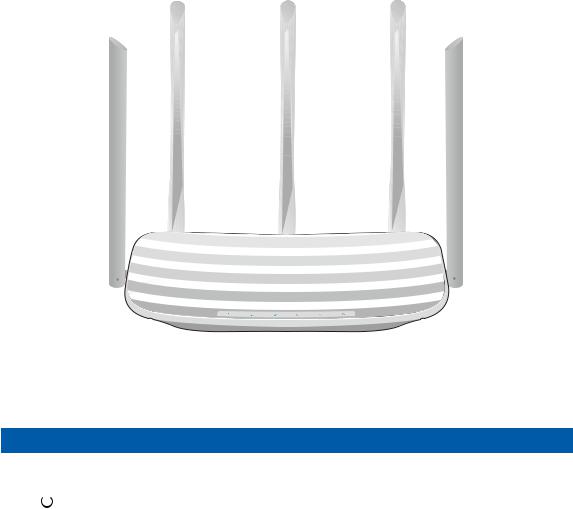
|
Chapter 1 |
Get to Know About Your Router |
1. 1. Product Overview
The TP-LINK router is designed to fully meet the need of Small Office/Home Office (SOHO) networks and the users demanding higher networking performance. The powerful antennas ensure continuous Wi-Fi signal to all your devices while boosting widespread coverage throughout your home, and the built-in Ethernet ports supply high-speed connection to your wired devices.
Moreover, it is simple and convenient to set up and use the TP-LINK router due to its intuitive web interface and the powerful Tether app.
1. 2. Panel Layout
1. 2. 1. Top View
The router’s LEDs (view from left to right) are located on the front panel. You can check the router’s working status by following the LED Explanation table.
LED Explanation
|
Name |
Status |
Indication |
||
|
On |
System initialization completes. |
|||
|
(Power) |
Flashing |
System initialization or firmware upgrade is in process. Do not |
||
|
disconnect or power off the router. |
||||
|
Off |
Power is off. |
|||
3
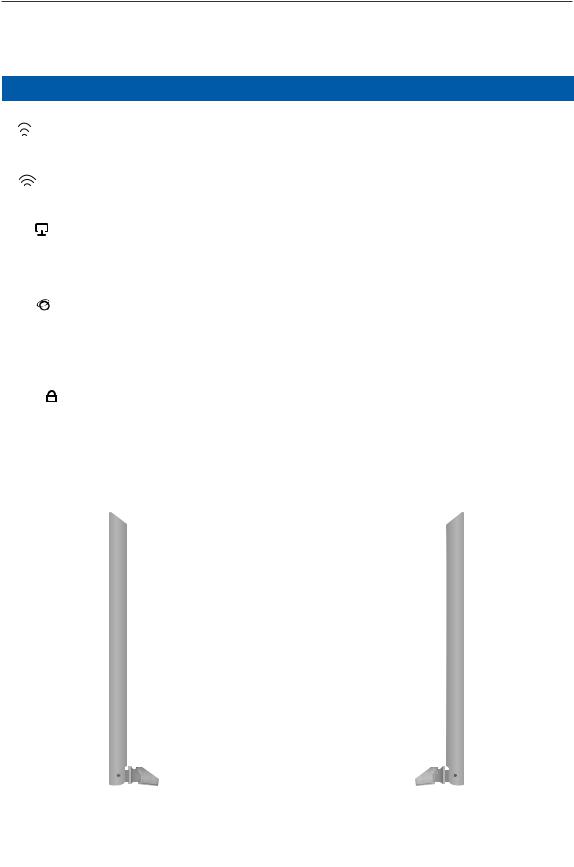
Chapter 1 Get to Know About Your Router
LED Explanation
|
Name |
Status |
Indication |
|
|
On |
The 2.4GHz wireless band is working properly. |
||
|
(2.4GHz Wireless) |
|||
|
Off |
The 2.4 GHz wireless band is disabled. |
||
|
On |
The 5GHz wireless band is working properly. |
||
|
( 5GHz Wireless) |
|||
|
Off |
The 5GHz wireless band is disabled. |
||
|
On |
At least one Ethernet port is connected. |
||
|
(Ethernet) |
|||
|
Off |
No Ethernet port is connected. |
||
|
Green On |
Internet is available. |
||
|
(Internet) |
Orange On |
The router’s Internet port is connected, but the Internet |
|
|
is not available. |
|||
|
Off |
The router’s Internet port is not connected. |
||
|
On/Off |
Turns on when a WPS connection is established, and goes off about |
||
|
5 minutes later. |
|||
|
(WPS) |
|||
|
Flashing |
A wireless device is trying to connect to the network via WPS. This |
||
|
process may take up to 2 minutes. |
|||
1. 2. 2. The Back Panel
The following parts (view from left to right) are located on the rear panel.
|
Item |
Description |
|
|
Power Port |
For connecting the router to a power socket via the provided power |
|
|
adapter. |
||
4

Chapter 1 Get to Know About Your Router
|
Item |
Description |
|
|
Power On/Off Button |
Press this button to power on or off the router. |
|
|
Press this button for about 2 seconds to turn on or off the wireless function of your |
||
|
router. |
||
|
WPS/Wi-Fi On/Off Button |
||
|
Press this button, and immediately press the WPS button on your client device. |
||
|
The WPS LED of the router should change from flashing to solid on, indicating |
||
|
successful WPS connection. |
||
|
Reset Button |
Press this button for about 5 seconds to reset the router to its factory |
|
|
default settings. |
||
|
Internet Port |
For connecting to a DSL/Cable modem, or Ethernet port. |
|
|
Ethernet Ports (1/2/3/4) |
For connecting your PCs or other wired network devices to the router |
|
|
Antennas |
Used for wireless operation and data transmitting. Upright them for the |
|
|
best Wi-Fi performance. |
||
5

Chapter 2
Connect the Hardware
This chapter contains the following sections:
•Position Your Router
•Connect Your Router
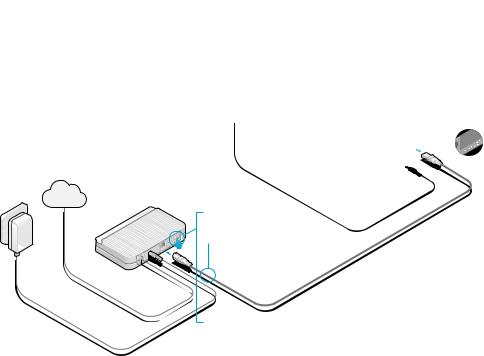
2. 1. Position Your Router
•The Product should not be located where it will be exposed to moisture or excessive heat.
•Place the router in a location where it can be connected to the various devices as well as to a power source.
•Make sure the cables and power cord are safely placed out of the way so they do not create a tripping hazard.
•The router can be placed on a shelf or desktop.
•Keep away from the strong electromagnetic radiation and the device of electromagnetic sensitive.
2. 2. Connect Your Router
1. Follow the steps below to connect your router.
If your Internet connection is through an Ethernet cable from the wall instead of through a DSL / Cable / Satellite modem, connect the Ethernet cable directly to the router’s Internet port, then follow step 4 and 5 to complete the hardware connection.
Power Adapter
Internet
1
|
2 |
||
|
Power Adapter |
Modem |
|
|
3 |
||
|
1 ) |
Turn off the modem, and remove the backup battery if it has one. |
|
|
2 ) |
Connect the modem to the Internet port on your router with an Ethernet cable. |
|
|
3 ) |
Turn on the modem, and then wait about 2 minutes for it to restart. |
7
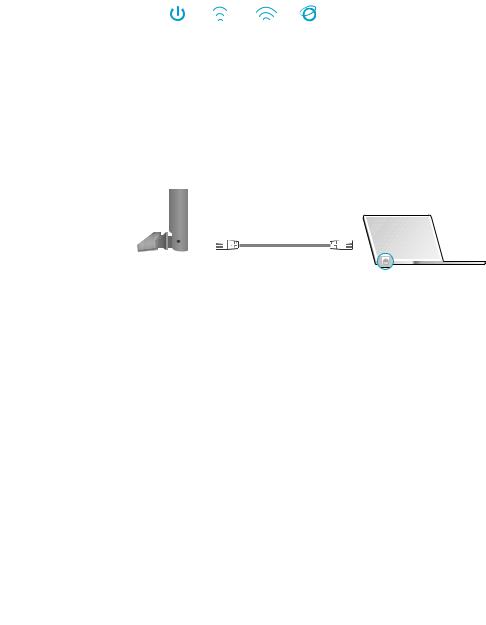
4 ) Turn on the router.
5 ) Verify that the hardware connection is correct by checking these LEDs.
|
Power |
2.4GHz |
5GHz |
Internet |
|
On |
On |
On |
On |
 Tips: If 2.4GHz LED and 5GHz LED are off, press the WPS/Wi-Fi On/Off button for about 2 seconds, and then check the LEDs again in a few seconds.
Tips: If 2.4GHz LED and 5GHz LED are off, press the WPS/Wi-Fi On/Off button for about 2 seconds, and then check the LEDs again in a few seconds.
2. Connect your computer to the router.
• Method 1: Wired
Turn off the Wi-Fi on your computer and connect the devices as shown below.
Ethernet Cable
• Method 2: Wirelessly
1 ) Find the SSID (Network Name) and Wireless Password/PIN printed on the label at the bottom of the router.
2 ) Click the network icon of your computer or go to Wi-Fi Setting of your smart device, and then select the SSID to join the network.
|
Computer |
Smart Device |
||||||||||||||||||
|
Connections are available |
< Settings |
Wi-Fi |
|||||||||||||||||
|
Wi-Fi |
|||||||||||||||||||
|
Wireless Network Connection |
|||||||||||||||||||
|
CHOOSE A NETWORK… |
|||||||||||||||||||
|
TP-LINK_XXXX |
|||||||||||||||||||
|
TP-LINK_XXXX_5G |
TP-LINK_XXXX |
||||||||||||||||||
|
√ Connect automatically |
Connect |
||||||||||||||||||
|
TP-LINK_XXXX_5G |
|||||||||||||||||||
|
Other… |
|||||||||||||||||||
• Method 3: Use the WPS button
Wireless devices that support WPS, including Android phones, tablets, most USB network cards, can be connected to your router through this method. (WPS is not supported by iOS devices.)
 Note:
Note:
The WPS function cannot be configured if the wireless function of the router is disabled. Also, the WPS function will be disabled if your wireless encryption is WEP. Please make sure the wireless function is enabled and is configured with the appropriate encryption before configuring the WPS.
8

1.Tab the WPS icon on the device’s screen.
2.Immediately press the WPS button on your router.
Close to
9

Chapter 3
Log into Your Router
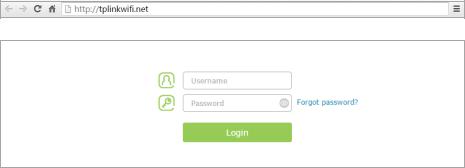
|
Chapter 3 |
Log into Your Router |
With a Web-based utility, it is easy to configure and manage the rouer. The Web-based utility can be used on any Windows, Macintosh or UNIX OS with a Web browser, such as Microsoft Internet Explorer, Mozilla Firefox or Apple Safari.
Follow the steps below to log into your router.
1.Set up the TCP/IP Protocol in Obtain an IP address automatically mode on your computer.
2.Visit http://tplinkwifi.net, and log in with the username and password you set for the router. The default one is admin for both username and password.
 Note:
Note:
If the login window does not appear, please refer to FAQ Section.
11

Chapter 4
Set Up Internet Connection
This chapter introduces how to connect your router to the Internet. The router is equipped with a web-based Quick Setup wizard. It has necessary ISP information built in, automates many of the steps and verifies that those steps have been successfully completed. Furthermore, you can also set up an IPv6 connection if your ISP provides IPv6 service.
This chapter contains the following sections:
•Use Quick Setup Wizard
•Manually Set up Your Internet Connection
•Set Up an IPv6 Internet Connection

|
Chapter 4 |
Set Up Internet Connection |
4. 1. Use Quick Setup Wizard
The Quick Setup Wizard will guide you through the process to set up your router.
 Tips:
Tips:
If you need the IPv6 Internet connection, please refer to the section of Set Up an IPv6 Internet Connection.
Follow the steps below to set up your router.
1.Visit http://tplinkwifi.net, and log in with the username and password you set for the router.
2.Click Quick Setup on the top of the page. Then follow the step-by-step instructions
to connect your router to the Internet.
 Note:
Note:
During the quick setup process:
•If you are not sure of the Internet Connection Type, please click Auto Detect or contact your ISP for Internet connection information.
•If you have changed the preset wireless network name (SSID) and wireless password, all your wireless devices must use the new SSID and password to connect to the router.
4. 2. Manually Set up Your Internet Connection
In this part, you can check your current Internet connection settings. You can also modify the settings according to the service information provided by your ISP.
Follow the steps below to check or modify your Internet connection settings.
1.Visit http://tplinkwifi.net, and log in with the username and password you set for the router.
2.Go to Basic > Internet.
3.Select your Internet connection type from the drop-down list.
 Note:
Note:
If you are unsure of what your connection type is, click Auto Detect. Since different connection types need different cables and connection information, you can also refer to the demonstrations in Step 4 to determine your connection type.
4.Follow the instructions on the page to continue the configuration. Parameters on the figures are just used for demonstration.
1 ) If you choose Dynamic IP, you need to select whether to clone the MAC address or not. Dynamic IP users are usually equipped with a cable TV or fiber cable.
13
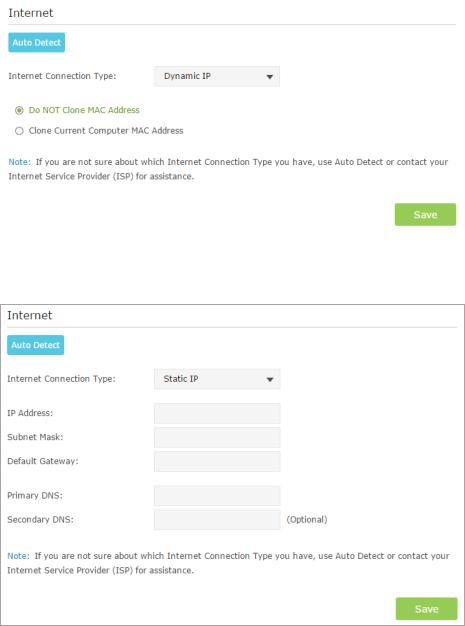
|
Chapter 4 |
Set Up Internet Connection |
|
2 ) If you choose Static IP, enter the information provided by your ISP in the corresponding fields.
3 ) If you choose PPPoE, enter the username and password provided by your ISP. PPPoE users usually have DSL cable modem.
14
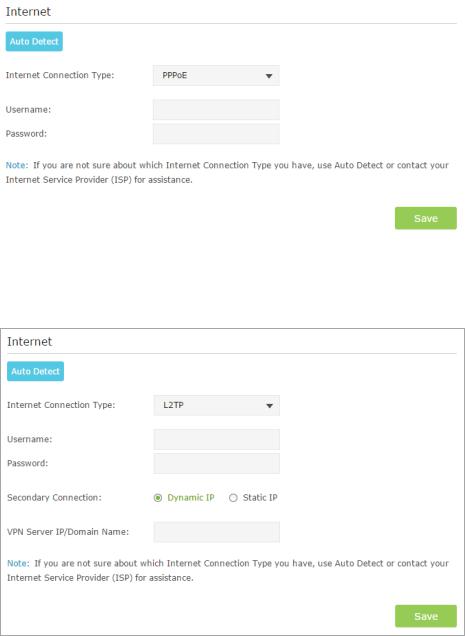
|
Chapter 4 |
Set Up Internet Connection |
|
4 ) If you choose L2TP, enter the username and password and choose the Secondary Connection provided by your ISP. Different parameters are needed according to the Secondary Connection you have chosen.
5 ) If you choose PPTP, enter the username and password, and choose the Secondary Connection provided by your ISP. Different parameters are needed according to the Secondary Connection you have chosen.
15
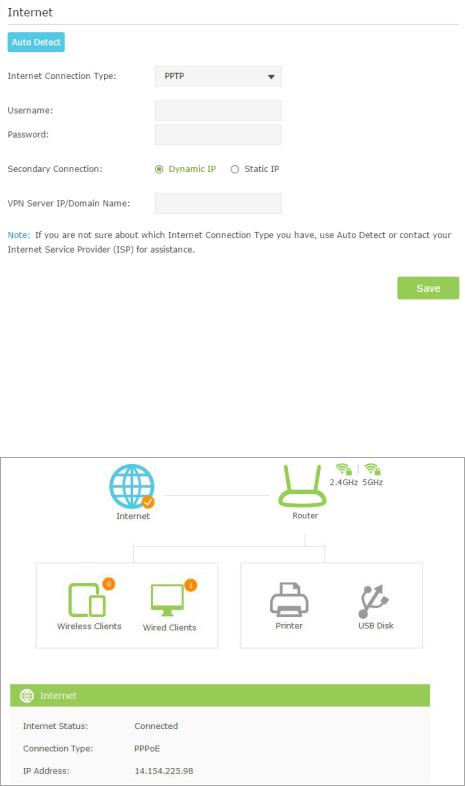
|
Chapter 4 |
Set Up Internet Connection |
|
5. Click Save. To check your Internet connection, click Network Map on the left of the page.
 Note:
Note:
It may take 1-2 minutes to make the settings valid.
6.After the connection succeeds, the screen will display as follows. Here we take PPPoE as an example.
 Tips:
Tips:
1.If your Internet connection type is BigPond Cable, please go to Advanced > Network > Internet to set your router.
2.If you use Dynamic IP and PPPoE and you are provided with any other parameters that are not required on the page, please go to Advanced > Network > Internet to complete the configuration.
3.If you still cannot access the Internet, refer to the FAQ for further instructions.
16
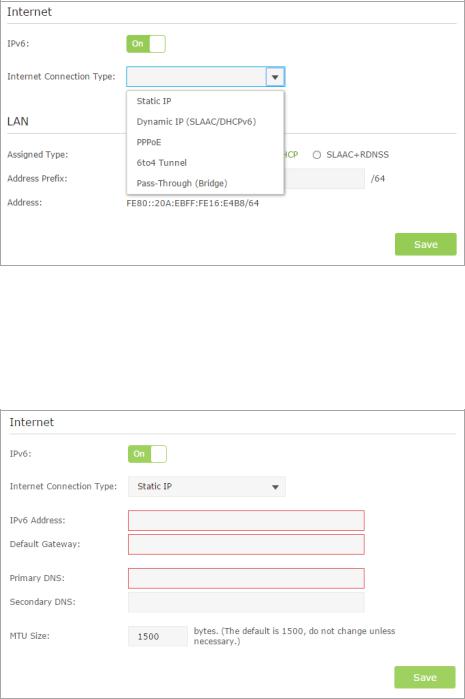
|
Chapter 4 |
Set Up Internet Connection |
4. 3. Set Up an IPv6 Internet Connection
Your ISP provides information about one of the following IPv6 Internet connection types: PPPoE, Dynamic IP(SLAAC/DHCPv6), Static IP, 6to4 tunnel, Pass-Through (Bridge).
1.Visit http://tplinkwifi.net, and log in with the username and password you set for the router.
2.Go to Advanced > IPv6. Select the Internet connection type provided by your ISP.
 Tips:
Tips:
If you do not know what your Internet connection type is, contact your ISP or judge according to the already known information provided by your ISP.
3.Fill in information as required by different connection types. Red blanks must be filled in.
1 ) Static IP: Fill in blanks and click Save.
17
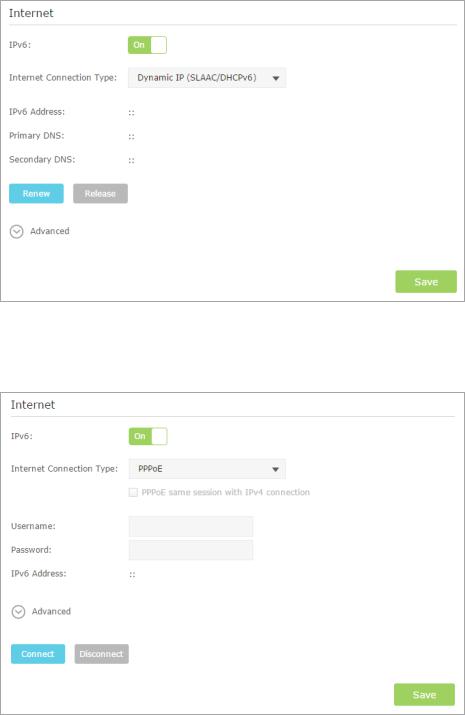
|
Chapter 4 |
Set Up Internet Connection |
2 ) Dynamic IP(SLAAC/DHCPv6): Click Advanced to do more configuration if your ISP requires. Click Save and then click Renew to finish the configuration.
3 ) PPPoE: Fill in the Username and Password. Click Advanced to do more configuration if your ISP requires. Click Save and then click Connect to finish the configuration.
4 ) 6to4 Tunnel: An IPv4 Internet connection type is a prerequisite for this connection type (Manually Set up Your Internet Connection). Click Advanced to do more configuration if your ISP requires. Click Save and then click Connect to finish the configuration.
18
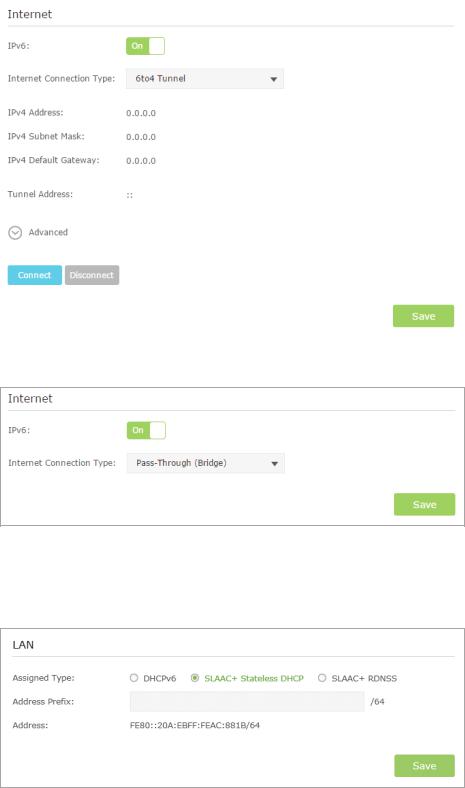
|
Chapter 4 |
Set Up Internet Connection |
||
5 ) Pass-Through (Bridge): Click Save and skip to step 6.
4. Configure LAN ports. Windows users are recommended to choose from the first two types. Fill in Address Prefix provided by your ISP, and click Save.
 Tips:
Tips:
Find Help on the management interface to know more about items.
5.Click Status to check whether you have successfully set up an IPv6 connection. The following figure is an example of a successful PPPoE configuration.
19
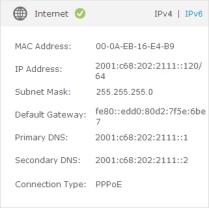
|
Chapter 4 |
Set Up Internet Connection |
|
 Tips:
Tips:
Visit the FAQ if there is no Internet connection.
20

Chapter 5
Guest Network
This function allows you to provide Wi-Fi access for guests without disclosing your main network. When you have guests in your house, apartment, or workplace, you can create a guest network for them. In addition, you can customize guest network options to ensure network security and privacy.
This chapter contains the following sections:
•Create a Network for Guests
•Customize Guest Network Options
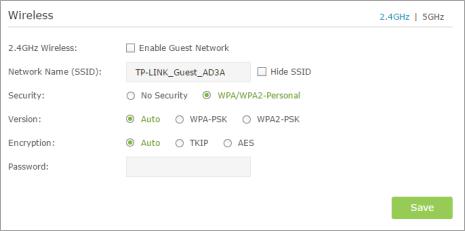
5. 1. Create a Network for Guests
1.Visit http://tplinkwifi.net, and log in with the username and password you set for the router.
2.Go to Advanced > Guest Network. Locate the Wireless section.
3.Create a guest network according to your needs.
1 ) Enable 2.4GHz Wireless network or 5GHz Wireless network.
 Note:
Note:
Guest network and WDS cannot be enabled at the same time. If WDS was enabled, disable it at Advanced > System Tools > System Parameters.
2 ) Customize the SSID. Don‘t select Hide SSID unless you want your guests to manually input the SSID for guest network access.
3 ) Set Security to WPA/WPA2 Personal, keep the default Version and Encryption values, and customize your own password.
4. Click Save. Now your guests can access your guest network using the SSID and password you set!
 Tips:
Tips:
To view guest network information, go to Advanced > Status and locate the Guest Network section.
22

5. 2. Customize Guest Network Options
1.Visit http://tplinkwifi.net, and log in with the username and password you set for the router.
2.Go to Advanced > Guest Network. Locate the Settings section.
3.Customize guest network options according to your needs.
•Allow guests to see each other
Select this checkbox if you want to allow the wireless clients on your guest network to communicate with each other via methods such as network neighbors and Ping.
•Allow guests to access my local network
Select this checkbox if you want to allow the wireless clients on your guest network to communicate with the devices connected to your router’s LAN ports or main network via methods such as network neighbors and Ping.
4. Click Save. Now you can ensure network security and privacy!
 Tips:
Tips:
To view guest network information, go to Advanced > Status and locate the Guest Network section.
23

Chapter 6
Parental Controls
This function allows you to block inappropriate, explicit and malicious websites, and controls access to specified websites at specified time.
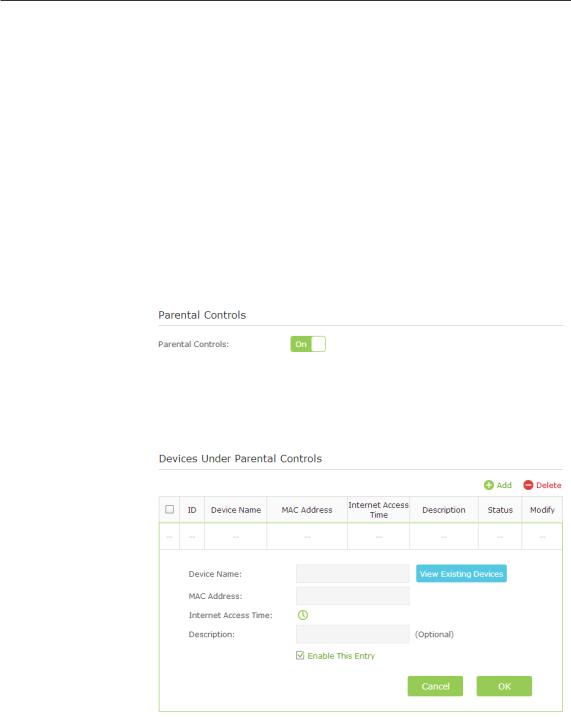
Chapter 6 Parental Controls
|
I want to: |
Control the times of day my children or other home network |
|
|
users are allowed to access the Internet and even types of |
||
|
websites they can visit. |
||
|
For example, I want to allow my children’s devices (e.g. a |
||
|
computer or a tablet) to access only www.tp-link.com and |
||
|
Wikipedia.org from 18:00 (6PM) to 22:00 (10PM) at the weekend |
||
|
and not other times. |
||
|
How can I |
1. |
Visit http://tplinkwifi.net, and log in with the username and |
|
do that? |
password you set for the router. |
|
|
2. |
Go to Advanced > Parental Controls and enable Parental |
|
|
Controls. |
||
|
3. |
Click Add. And then Click View Existing Devices, and select |
|
|
the access device. Or, input the Device Name and MAC |
||
|
Address manually. |
||
4.Click the  icon to set the Internet Access Time. Drag the cursor over the appropriate cell(s) and click OK.
icon to set the Internet Access Time. Drag the cursor over the appropriate cell(s) and click OK.
25

|
Chapter 6 |
Parental Controls |
5.Enter a Description for the entry. Keep the Enable This Entry checkbox selected. Click OK.
6.Select Whitelist as the restriction policy.
 Tips:
Tips:
1.With Blacklist selected, the controlled devices cannot access any websites containing the specified keywords during the Internet Access Time period.
2.With Whitelist selected, the controlled devices can only access websites containing the specified keywords during the Internet Access Time period.
7.Click  . Enter a keyword or a website and click Save.
. Enter a keyword or a website and click Save.
You can add up to 32 keywords for either Blacklist orWhitelist. Below are some sample entries to allow access.
•Enter a web address (e.g. wikipedia.org) or a web address keyword (e.g. wikipedia) to only allow or block access to the websites containing that keyword.
•Specify the domain suffix (eg. .edu or .org) to allow access only to the websites with that suffix.
•If you wish to block all Internet browsing access, do not add any keyword to the Whitelist.
26
 Loading…
Loading…

